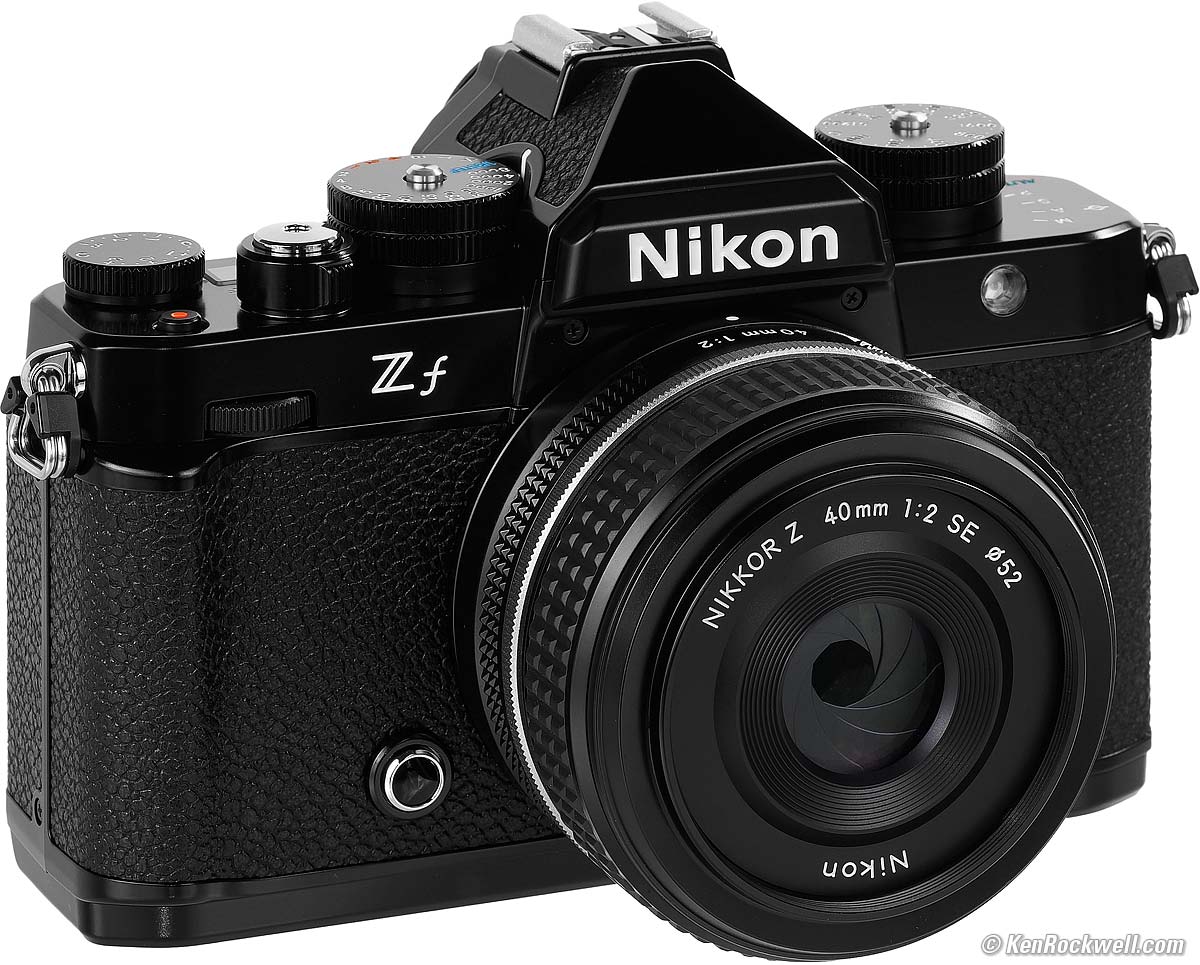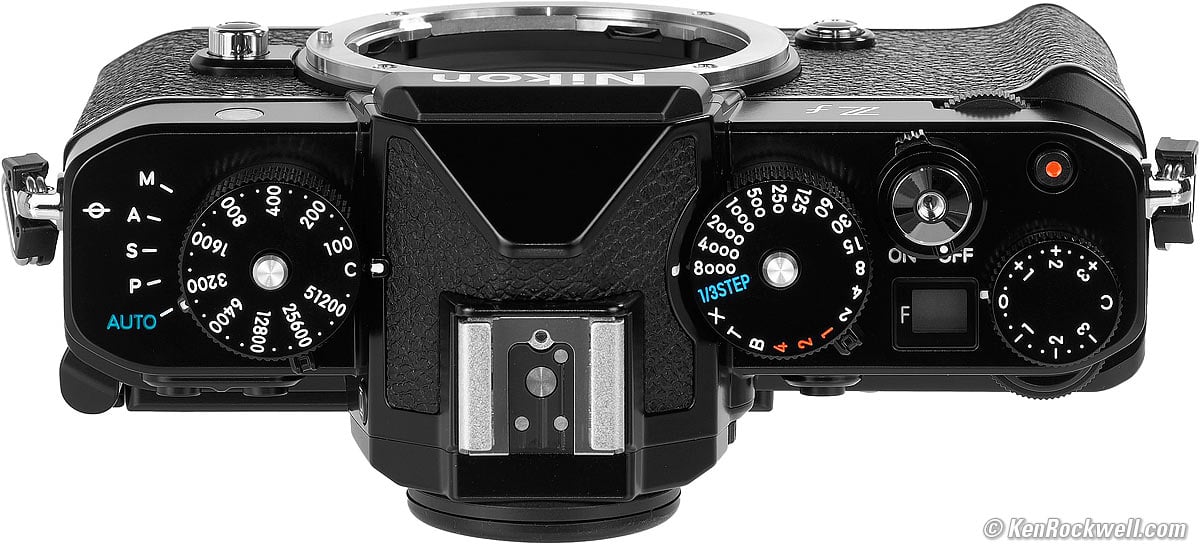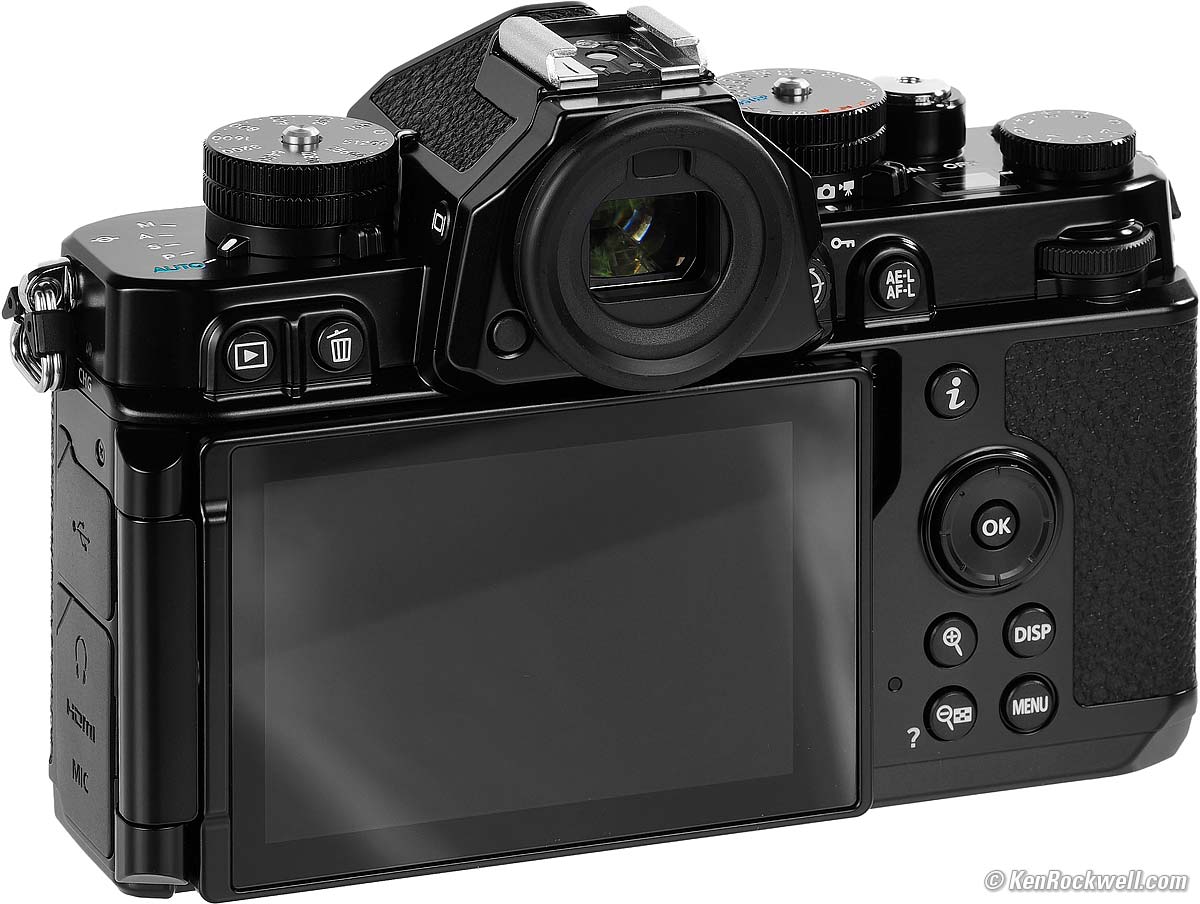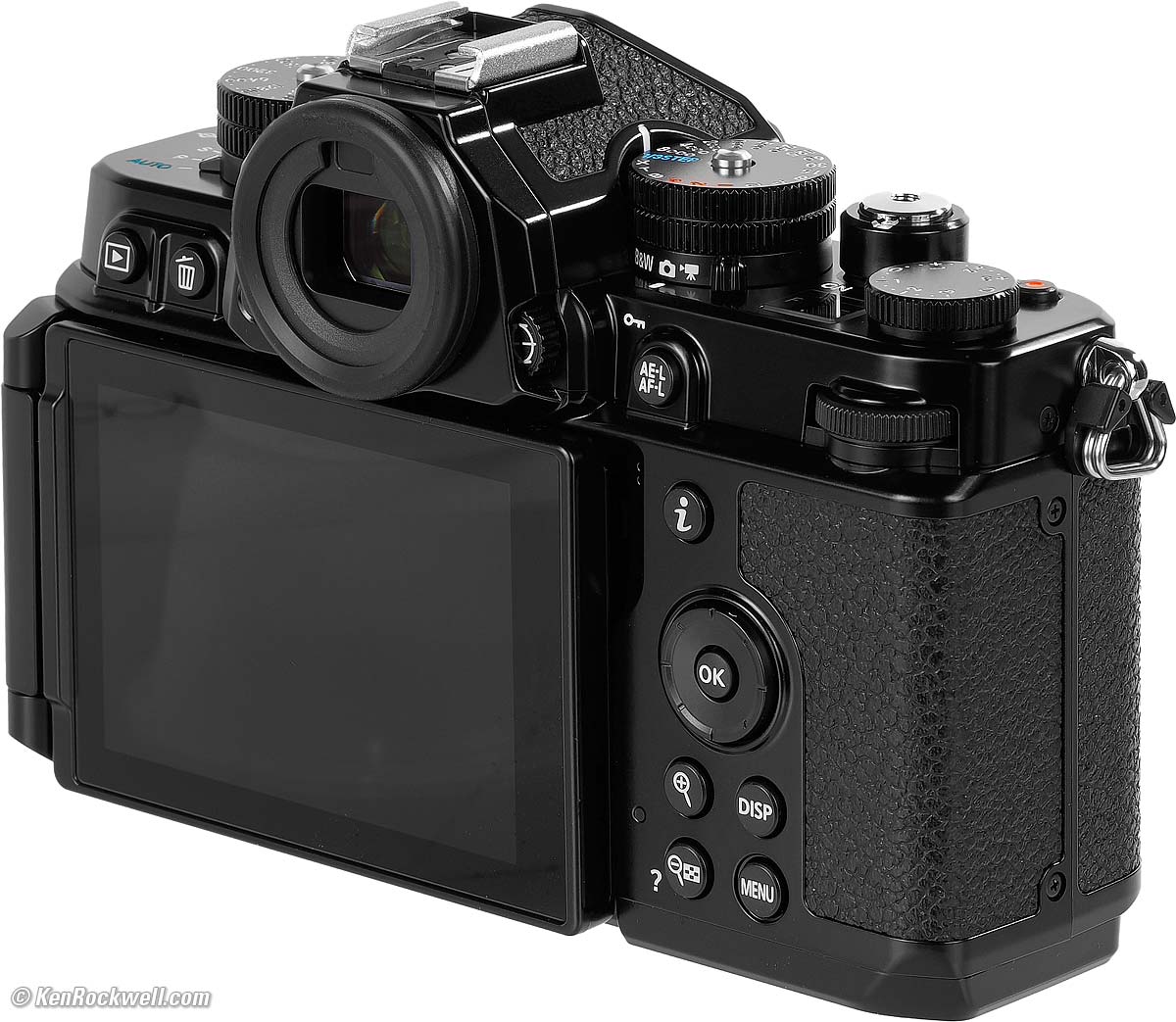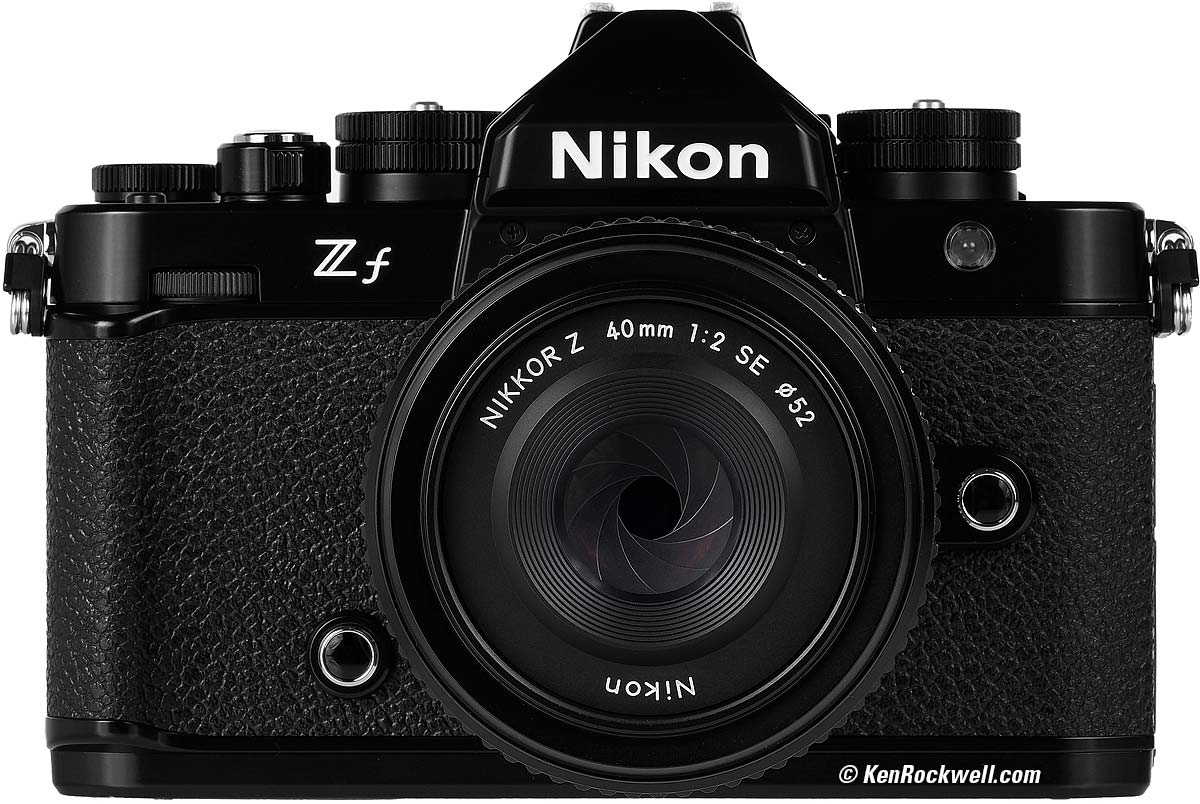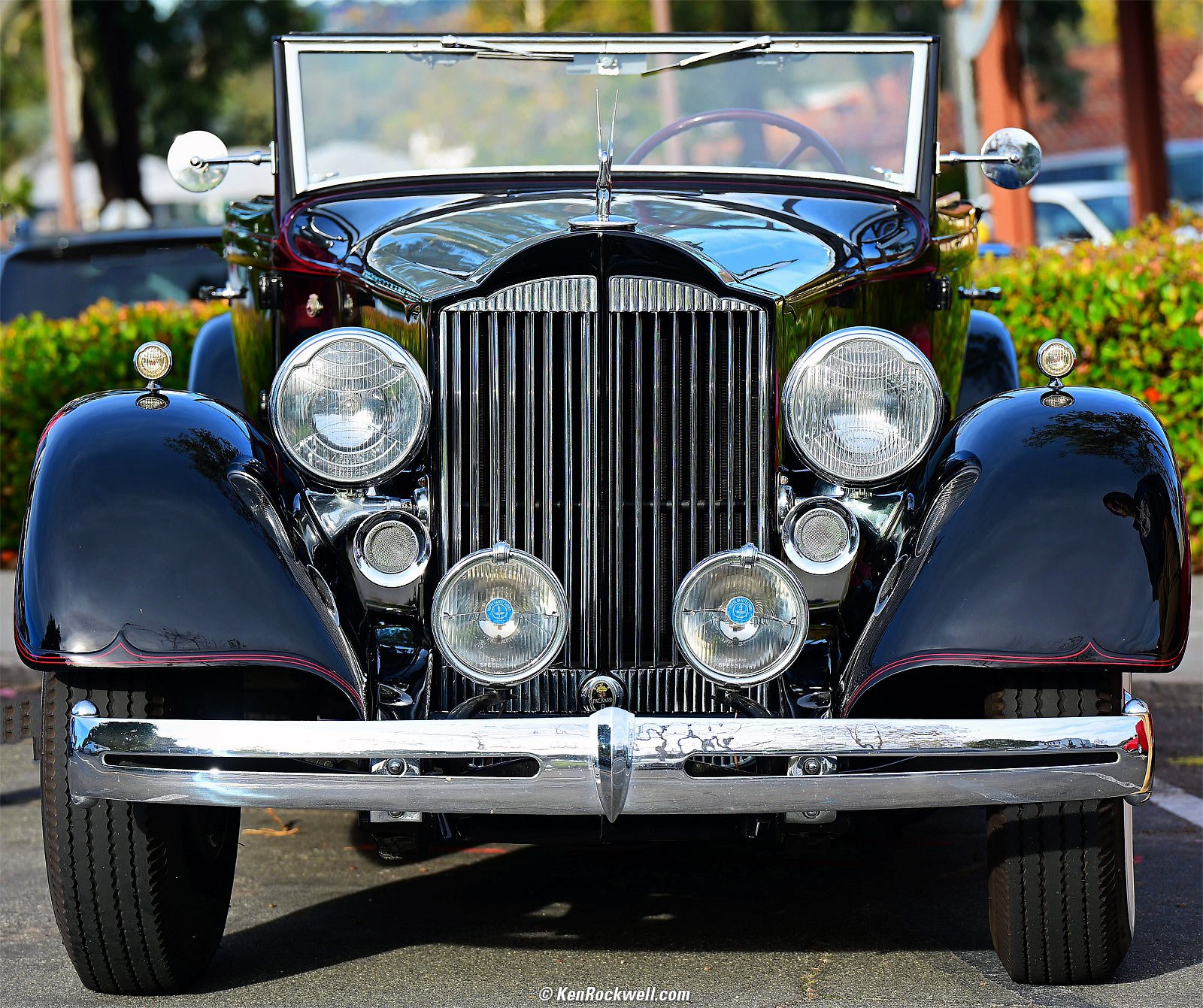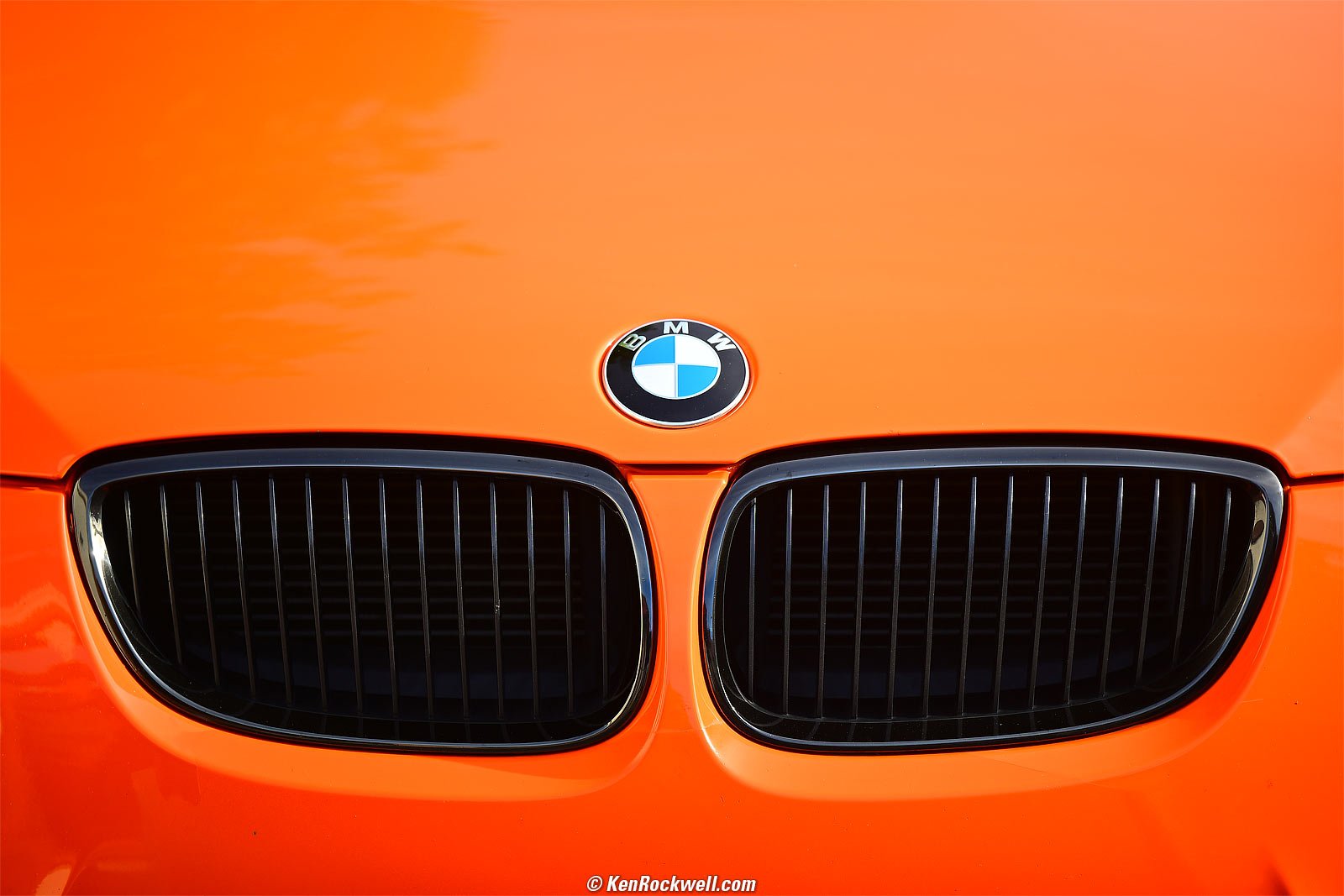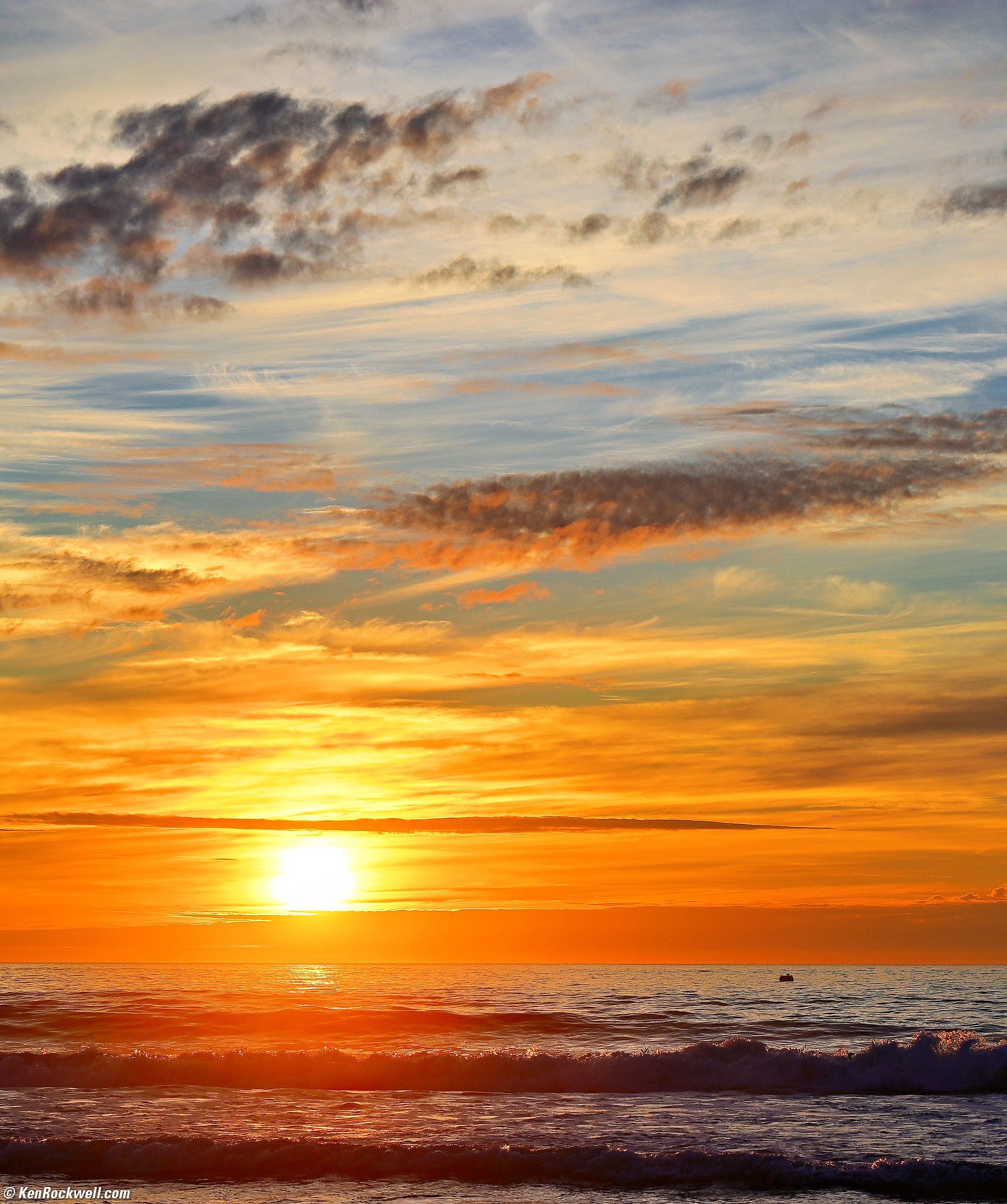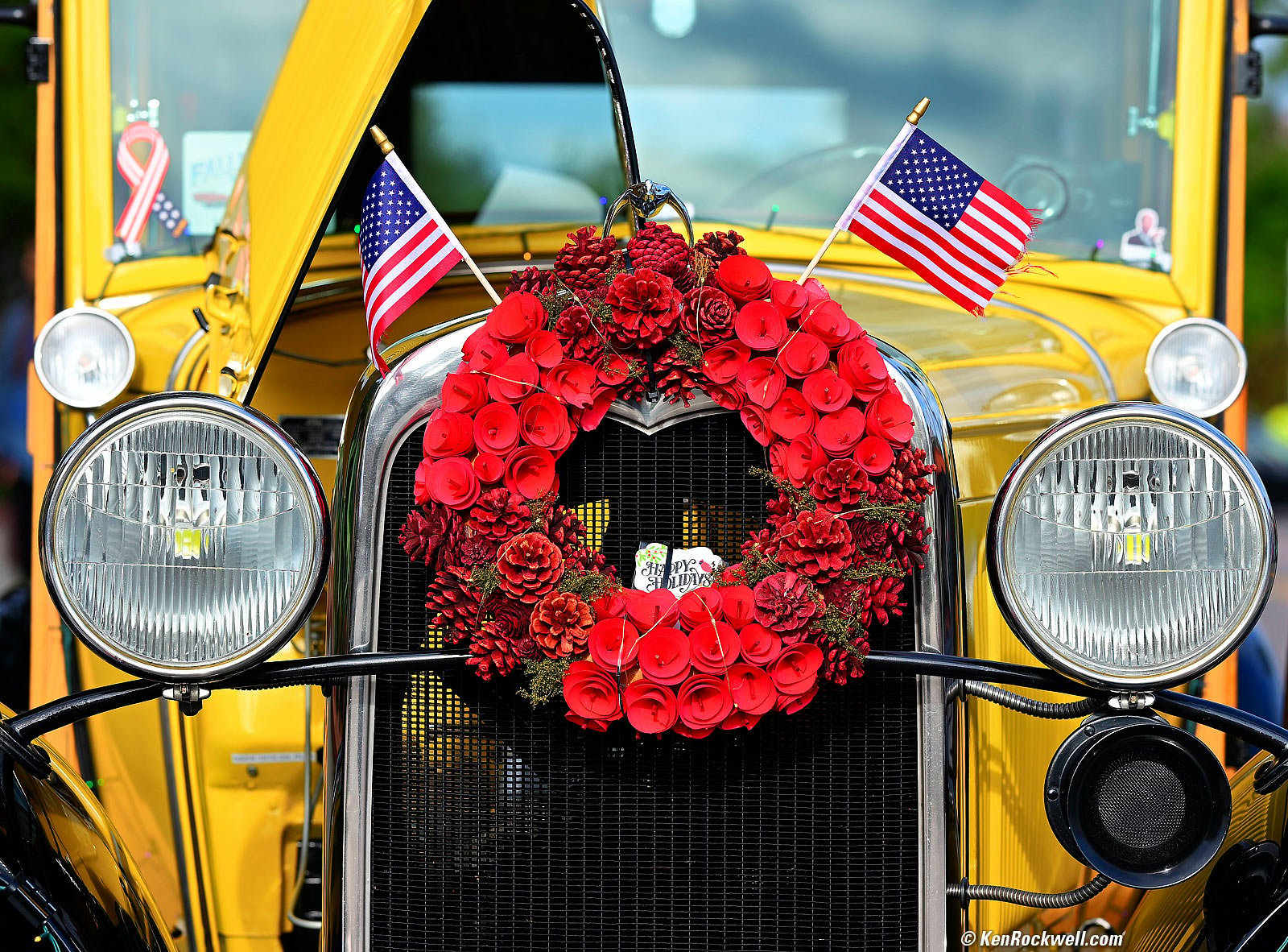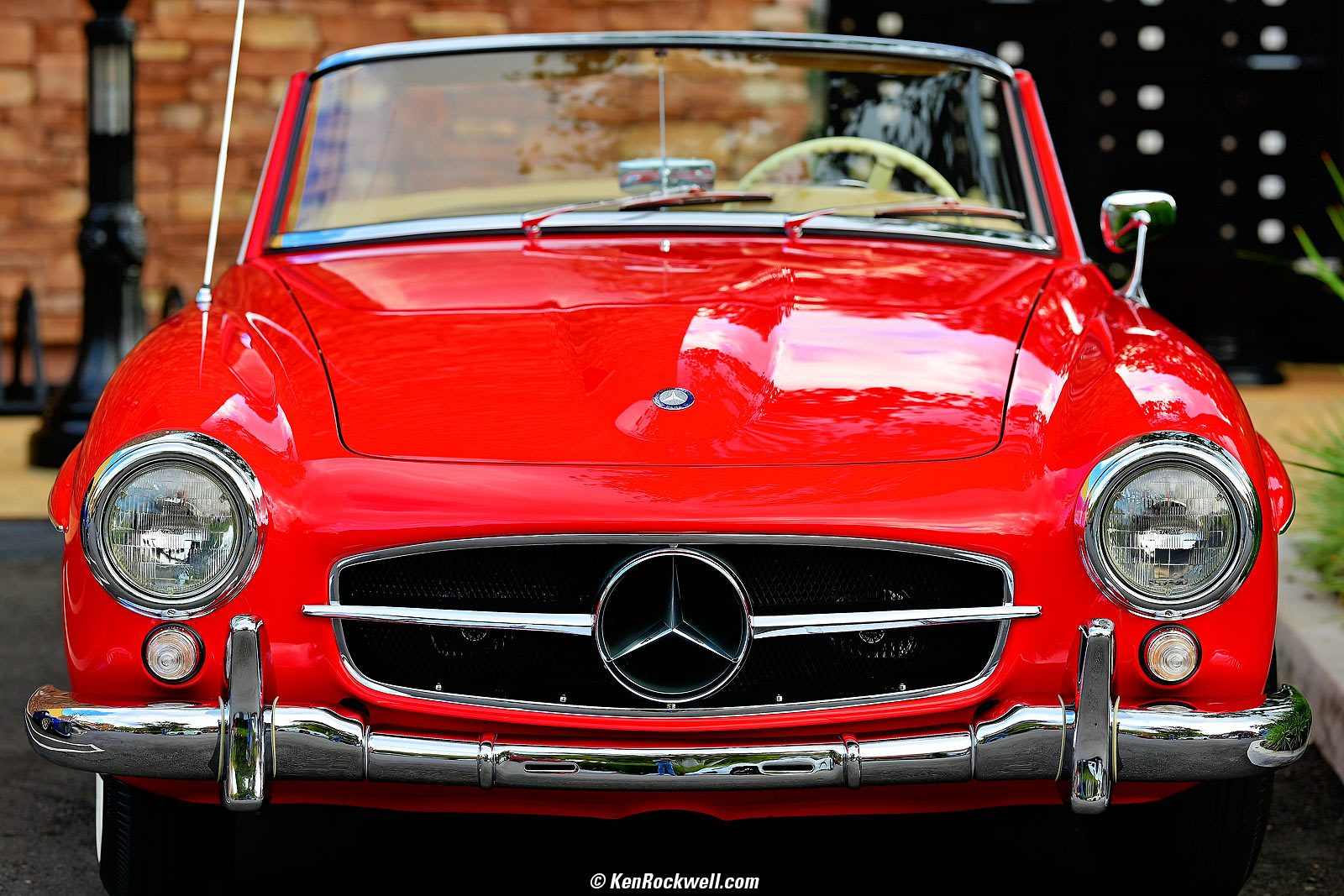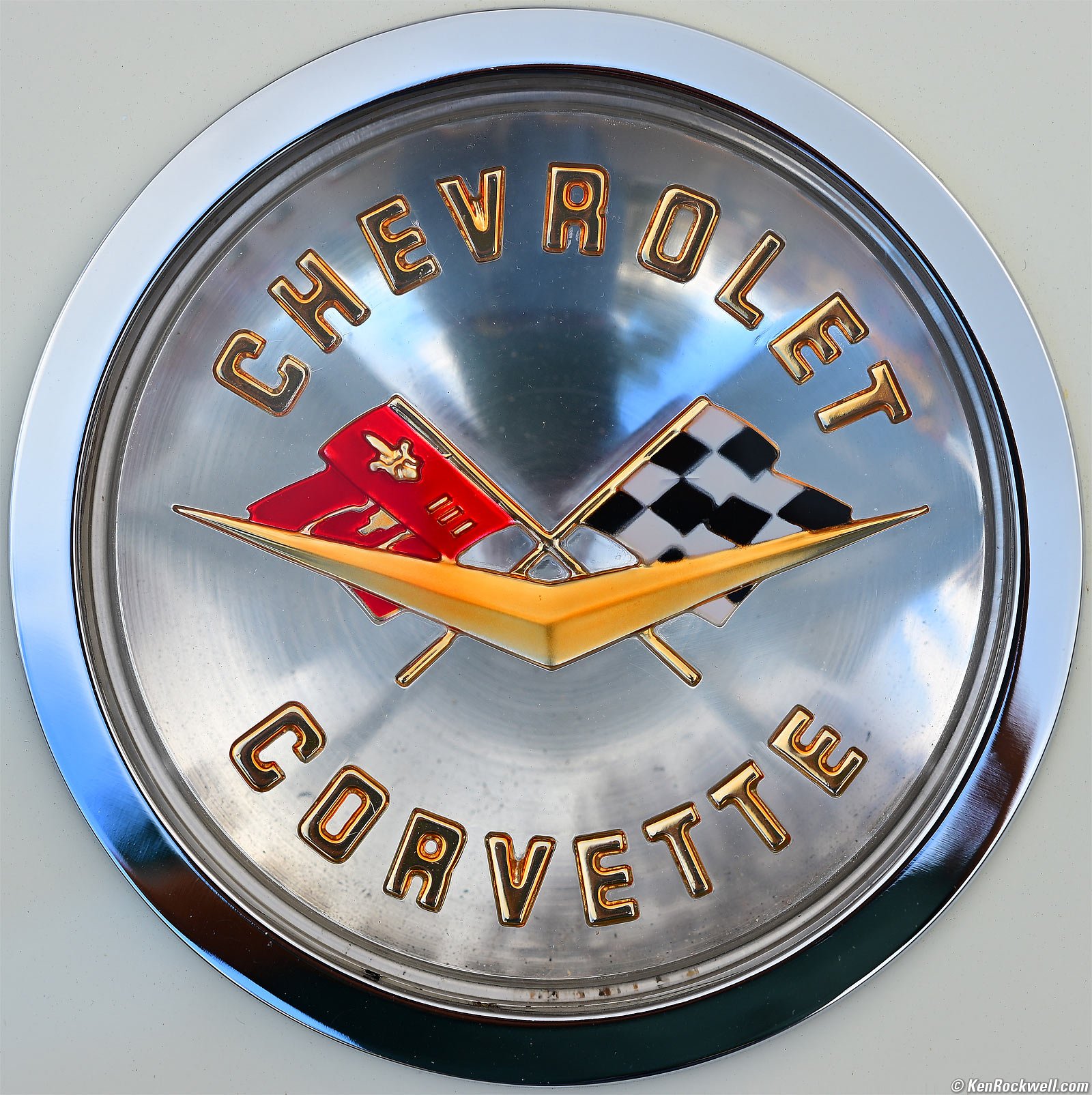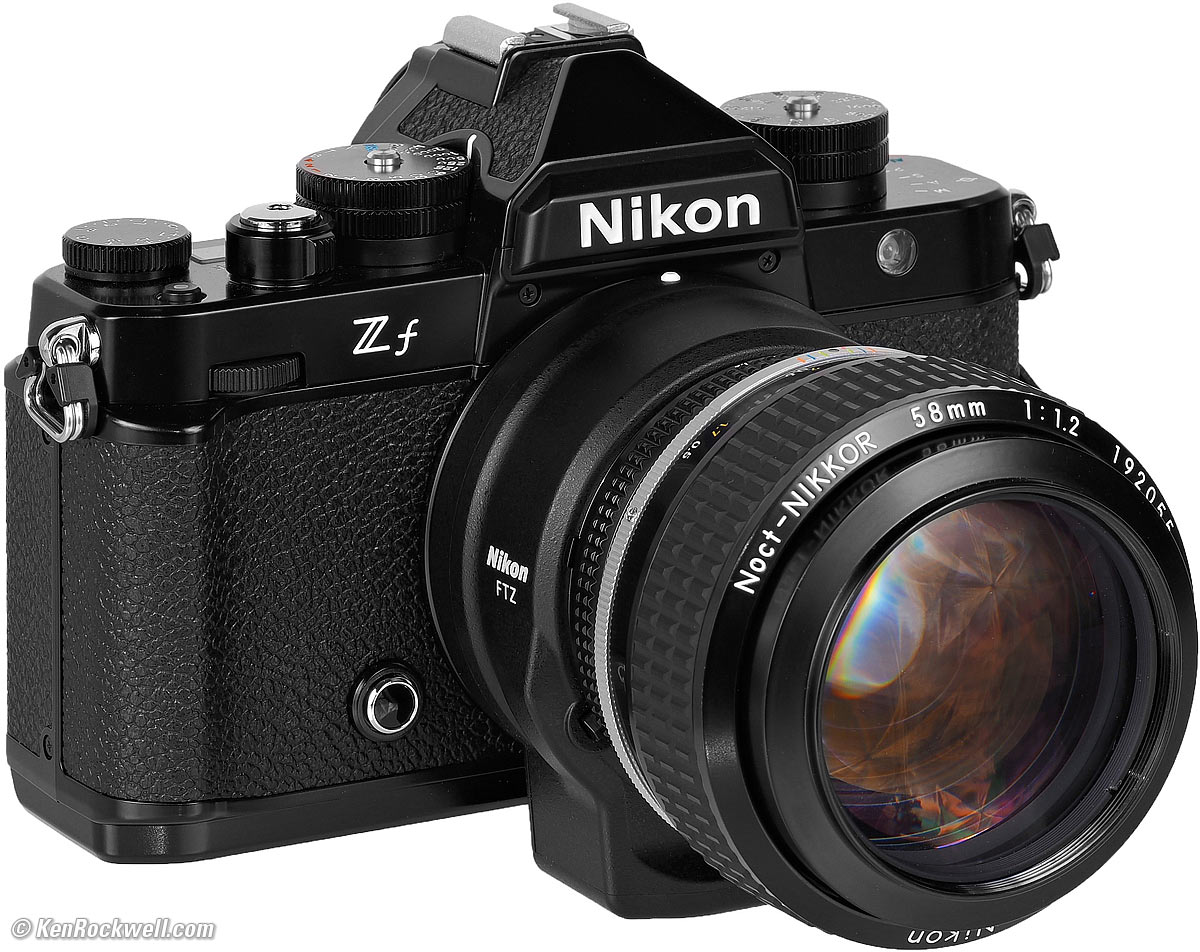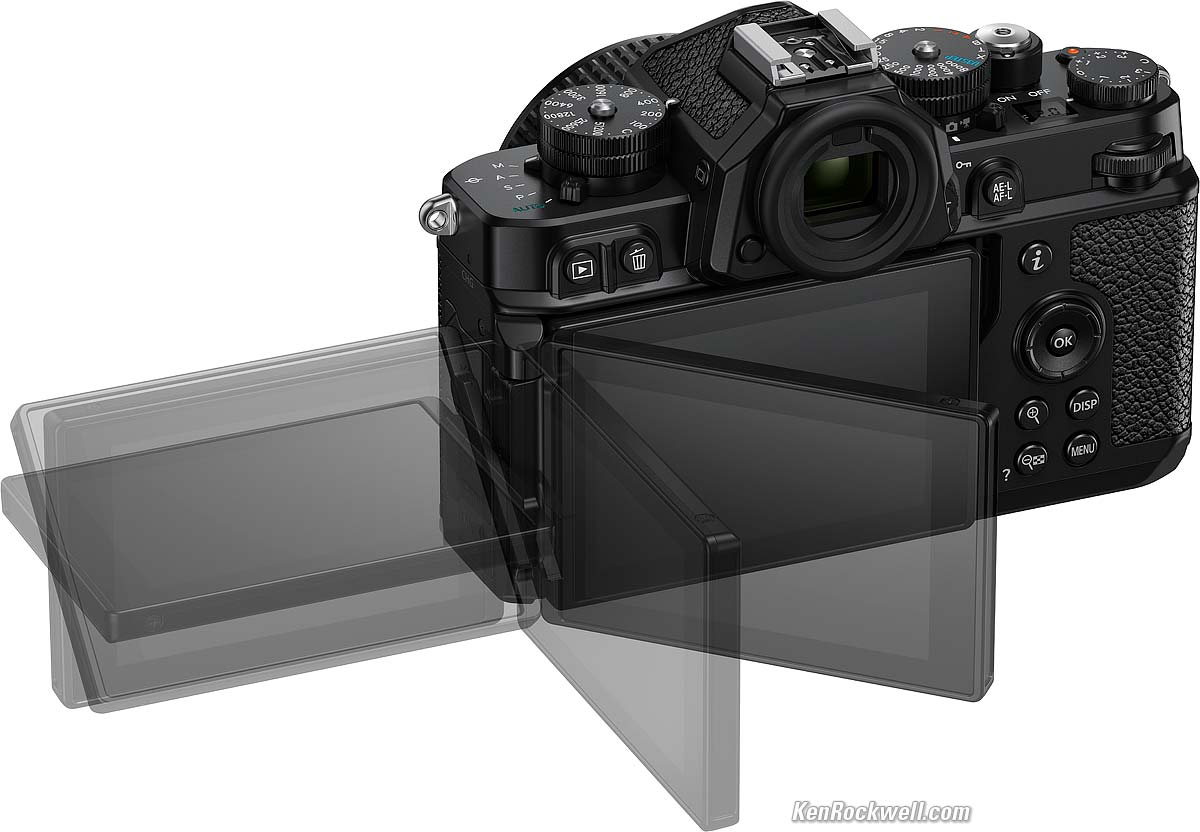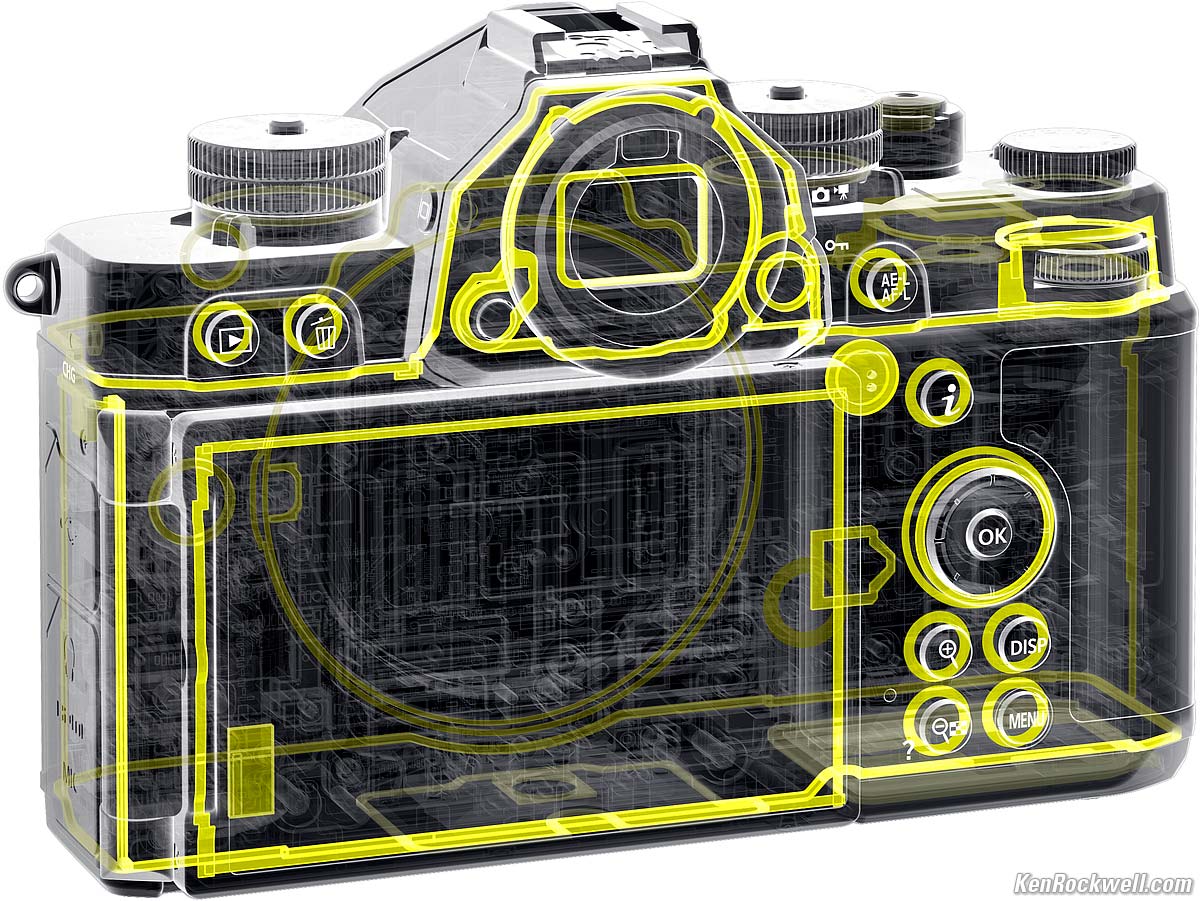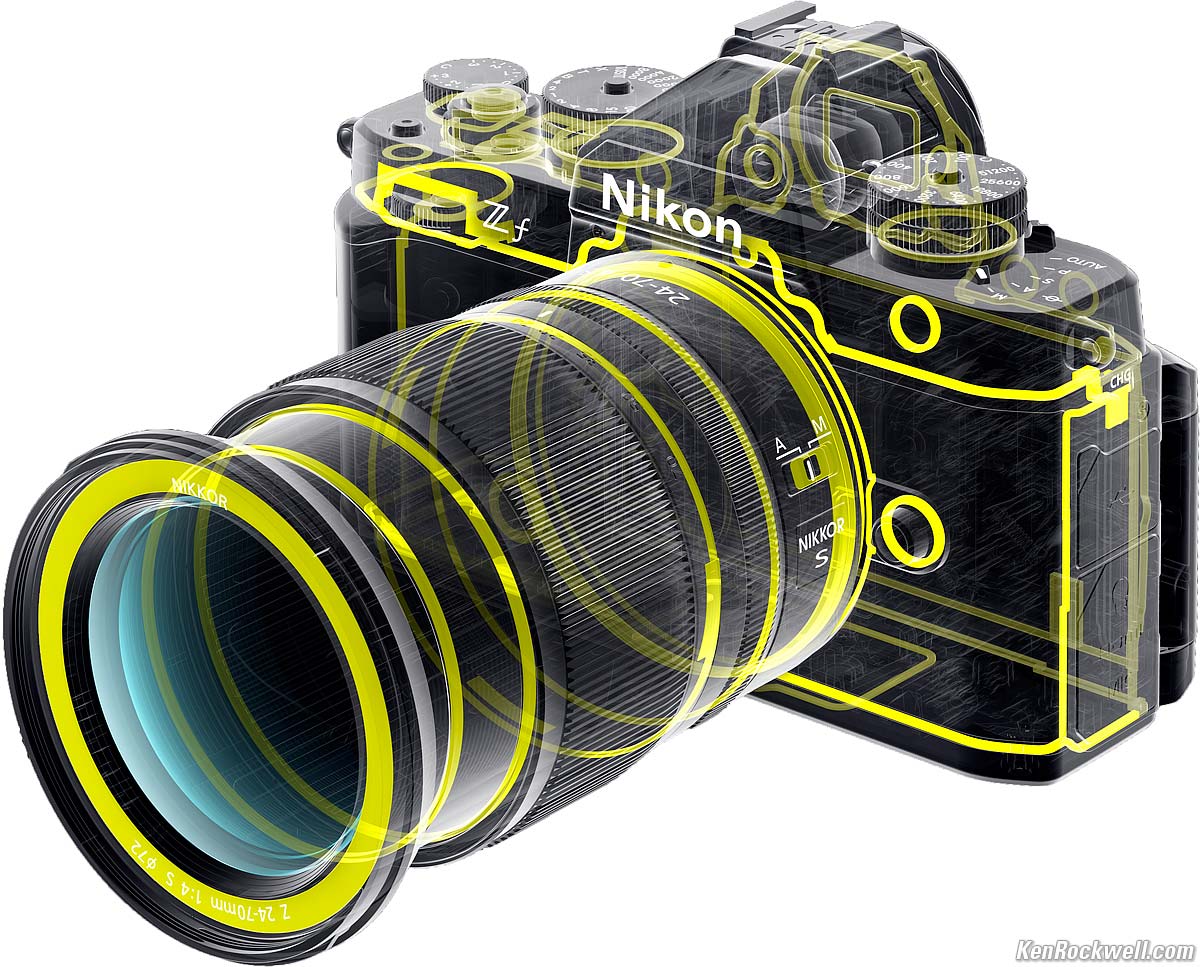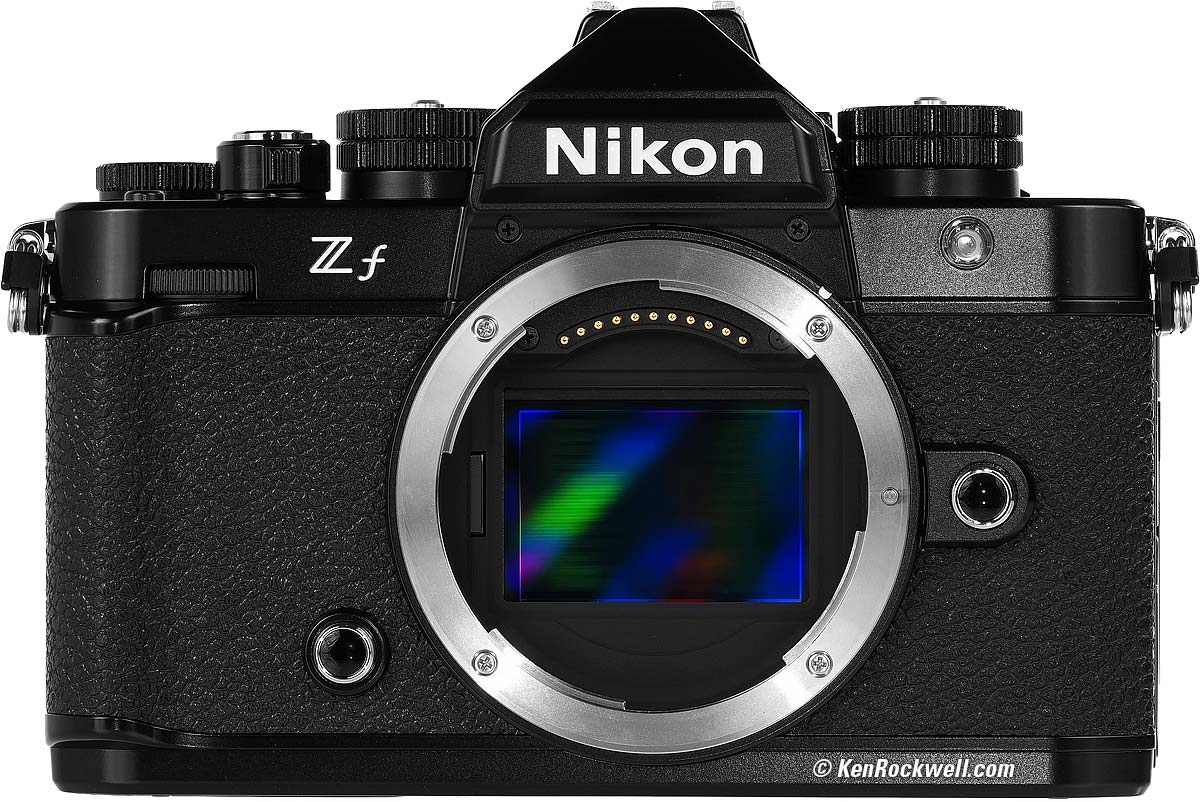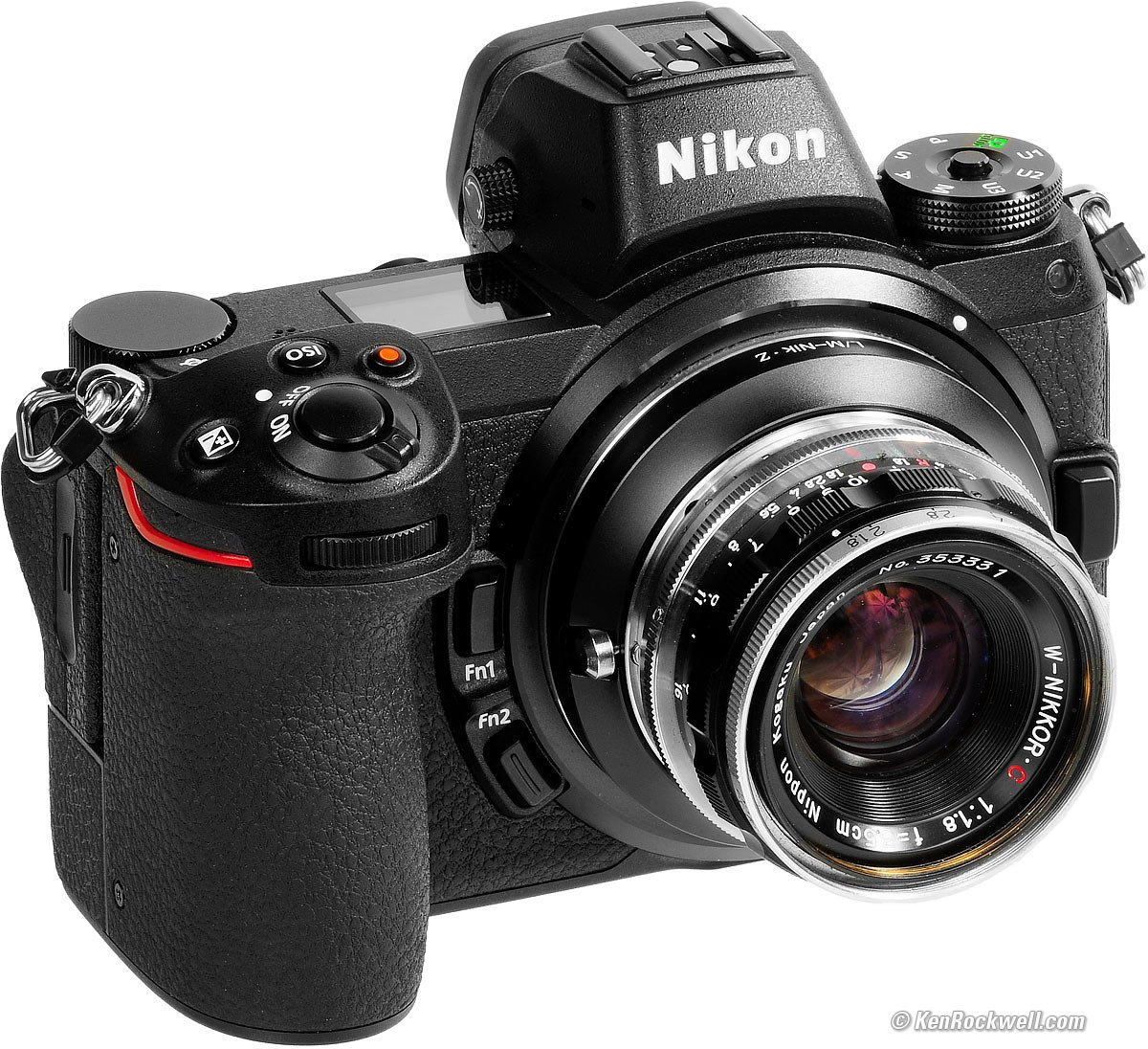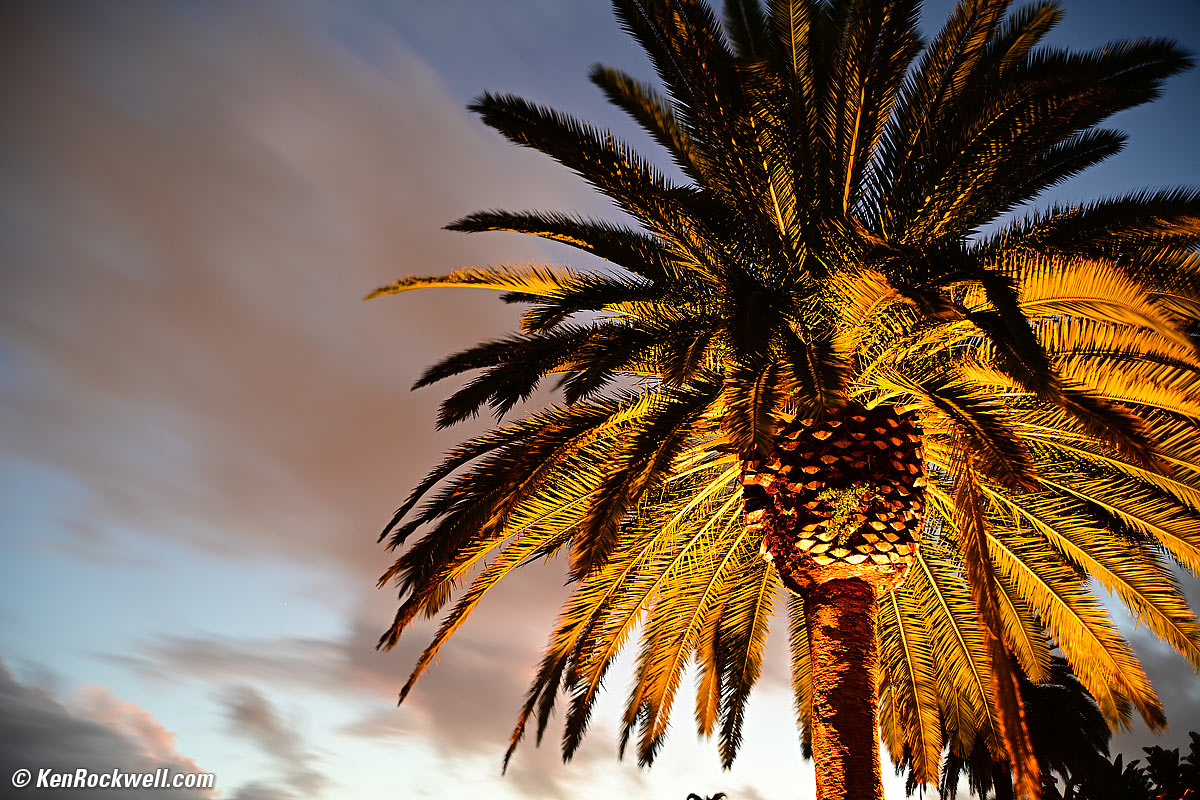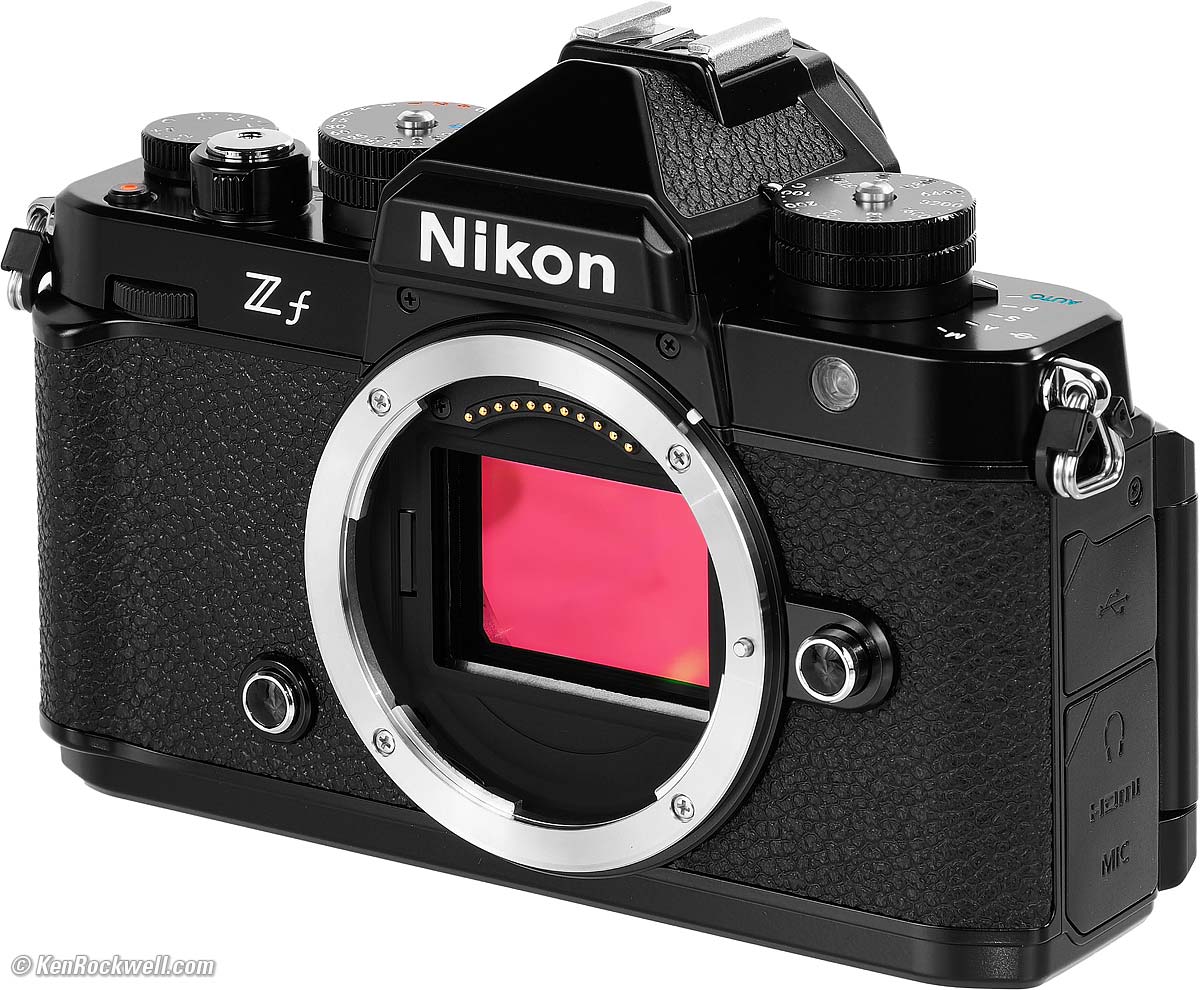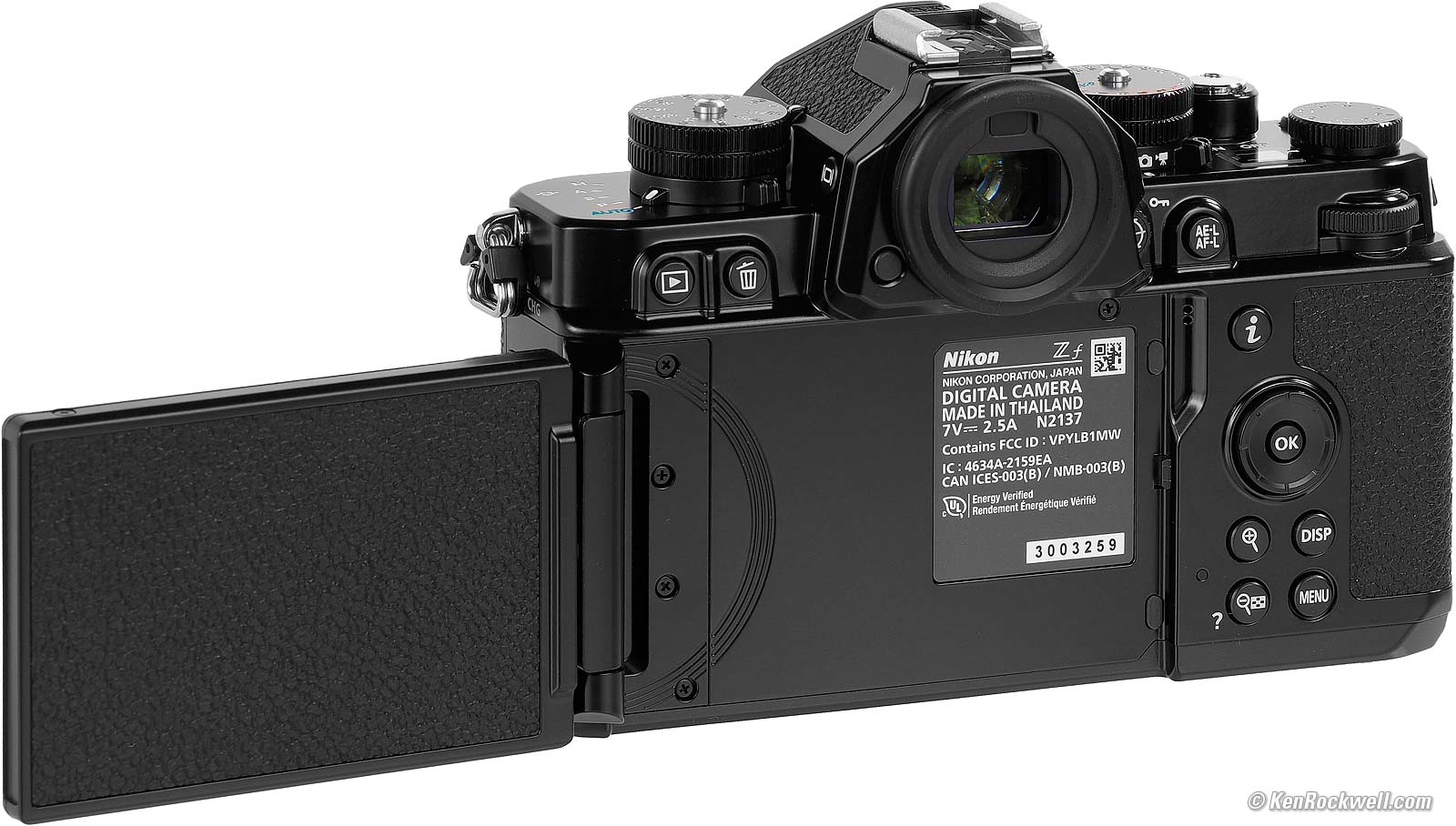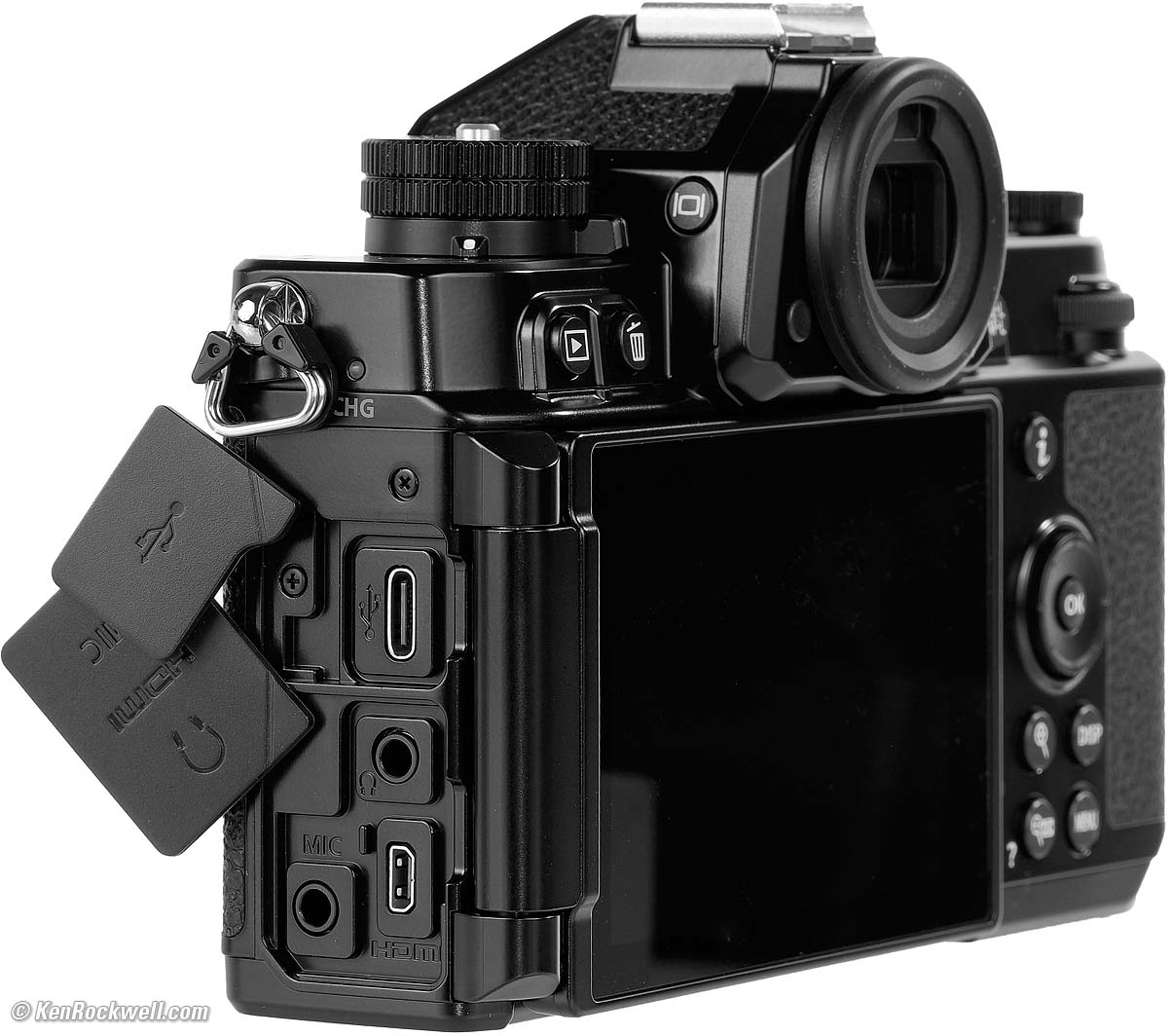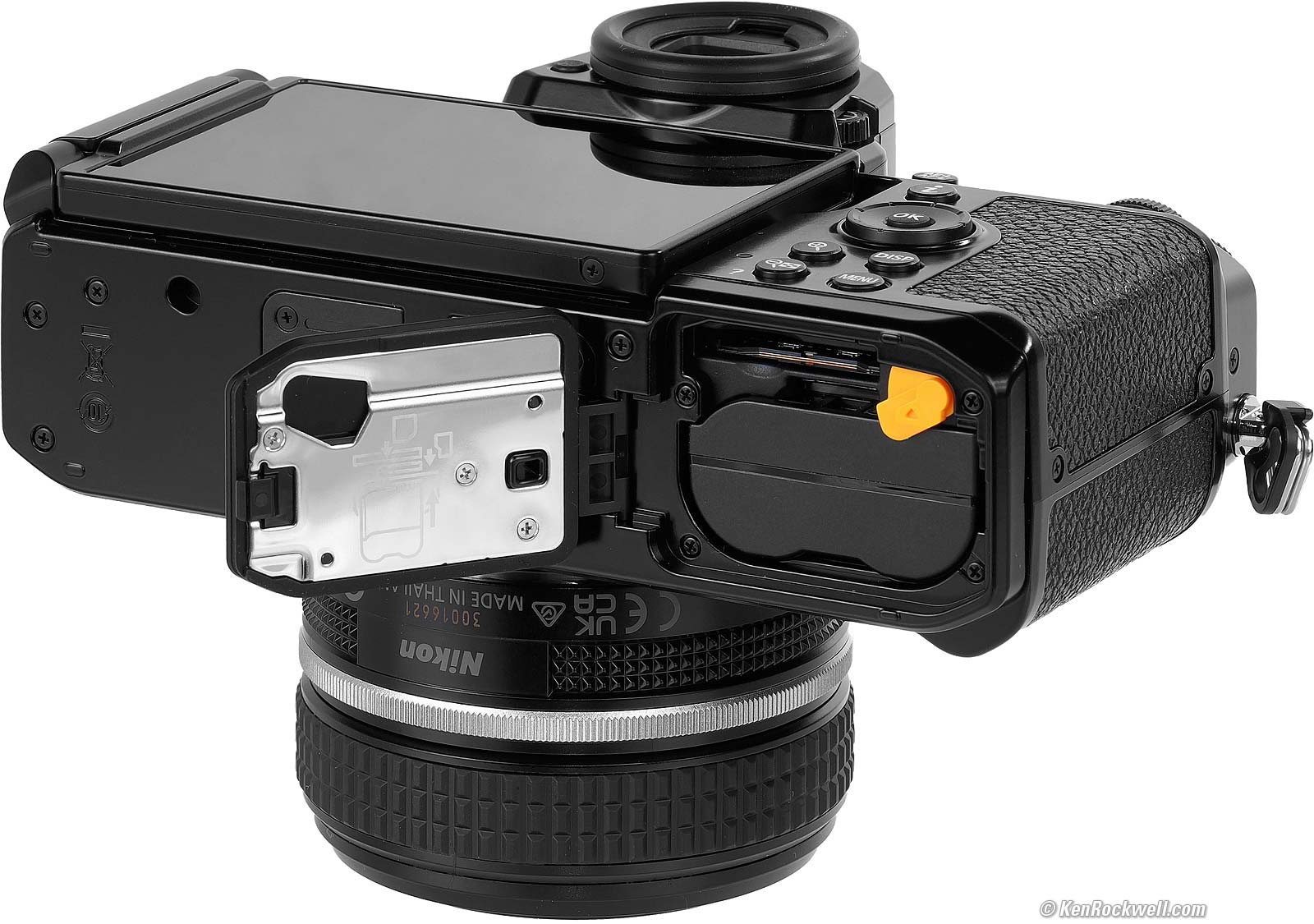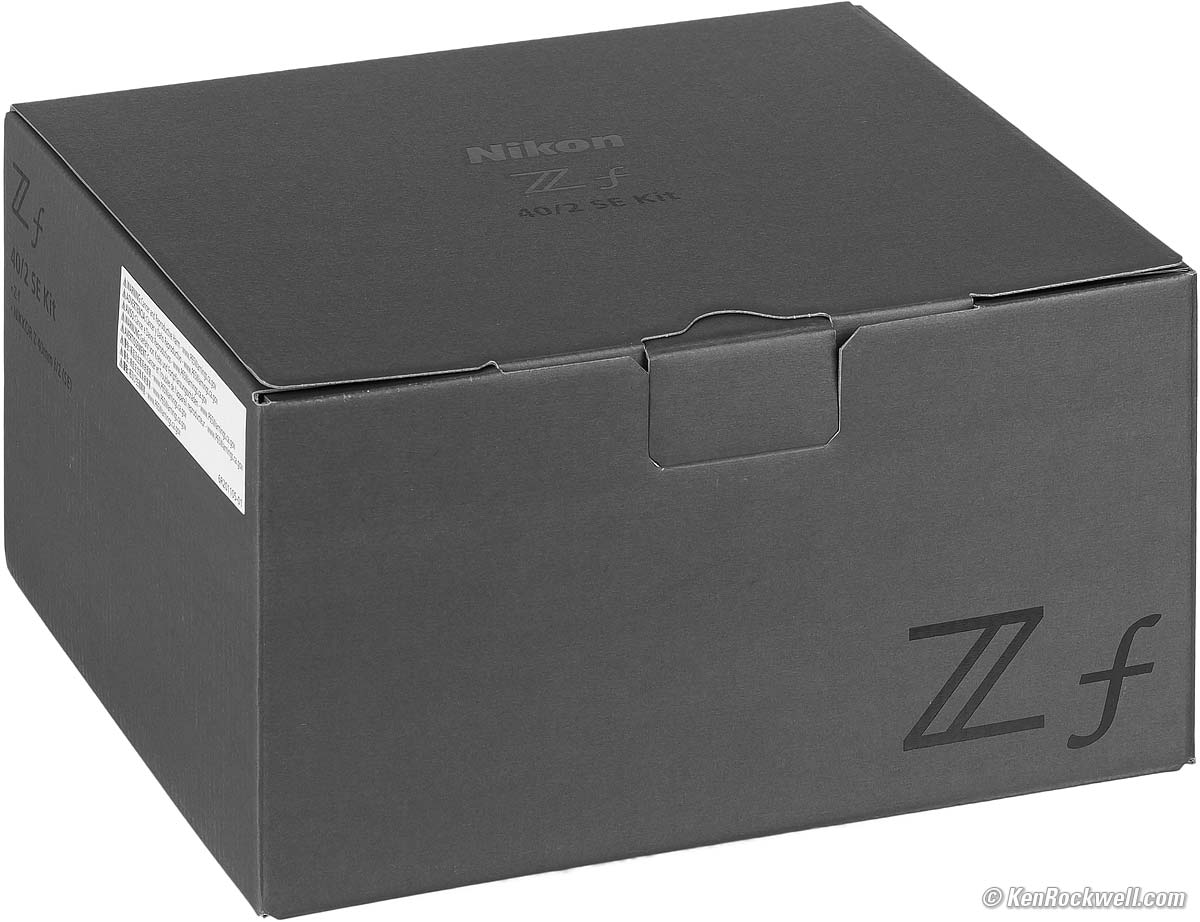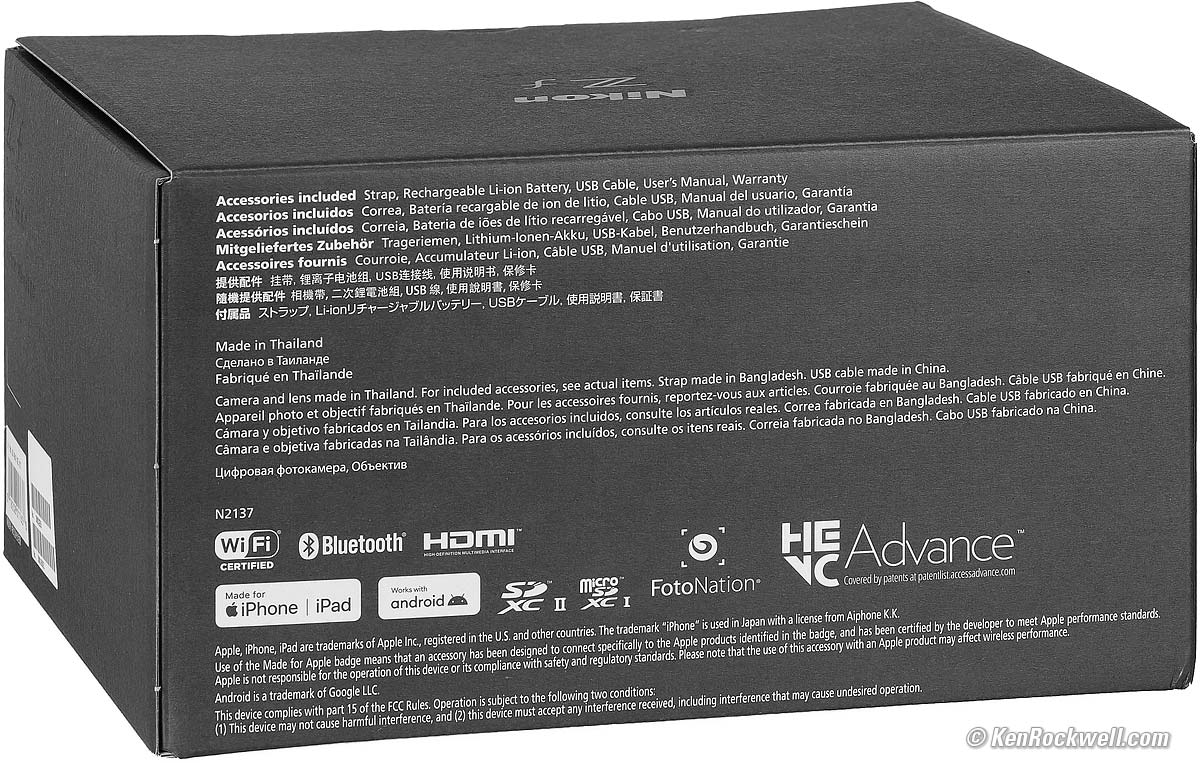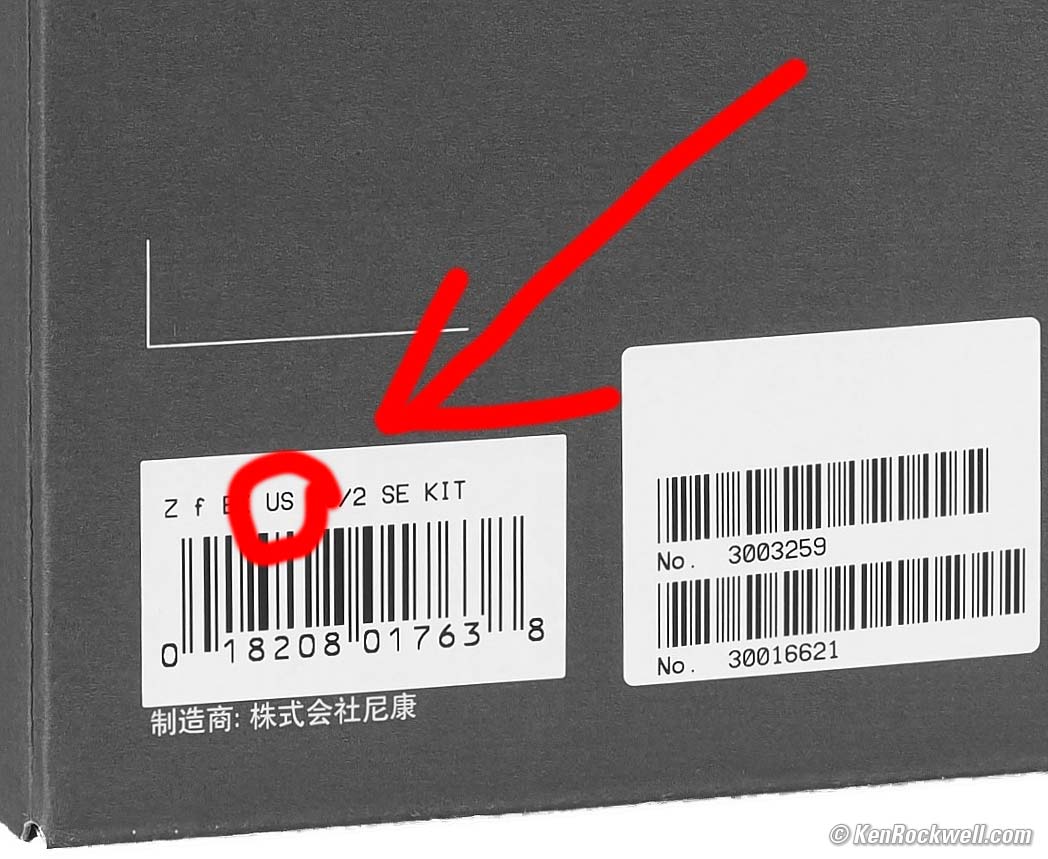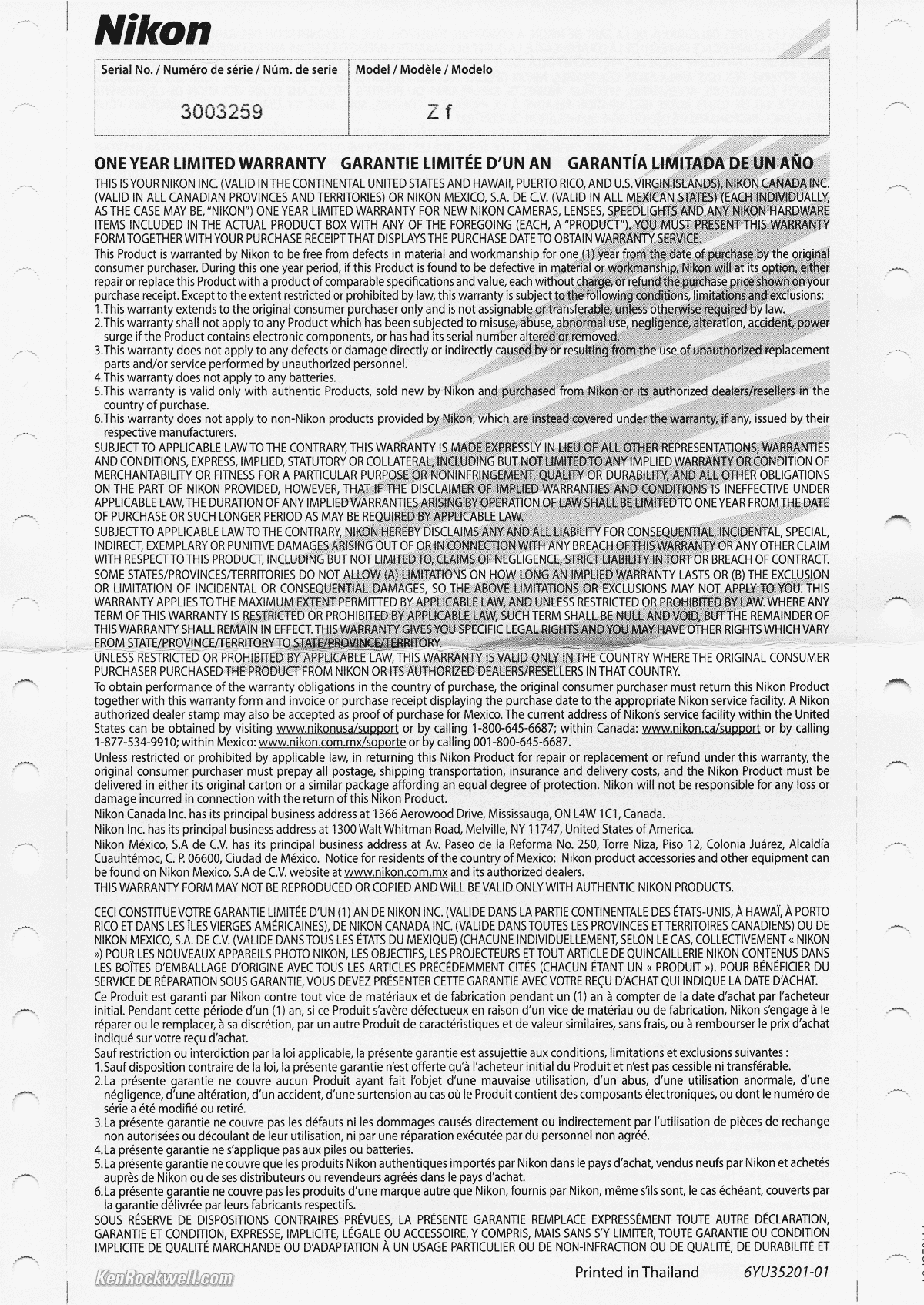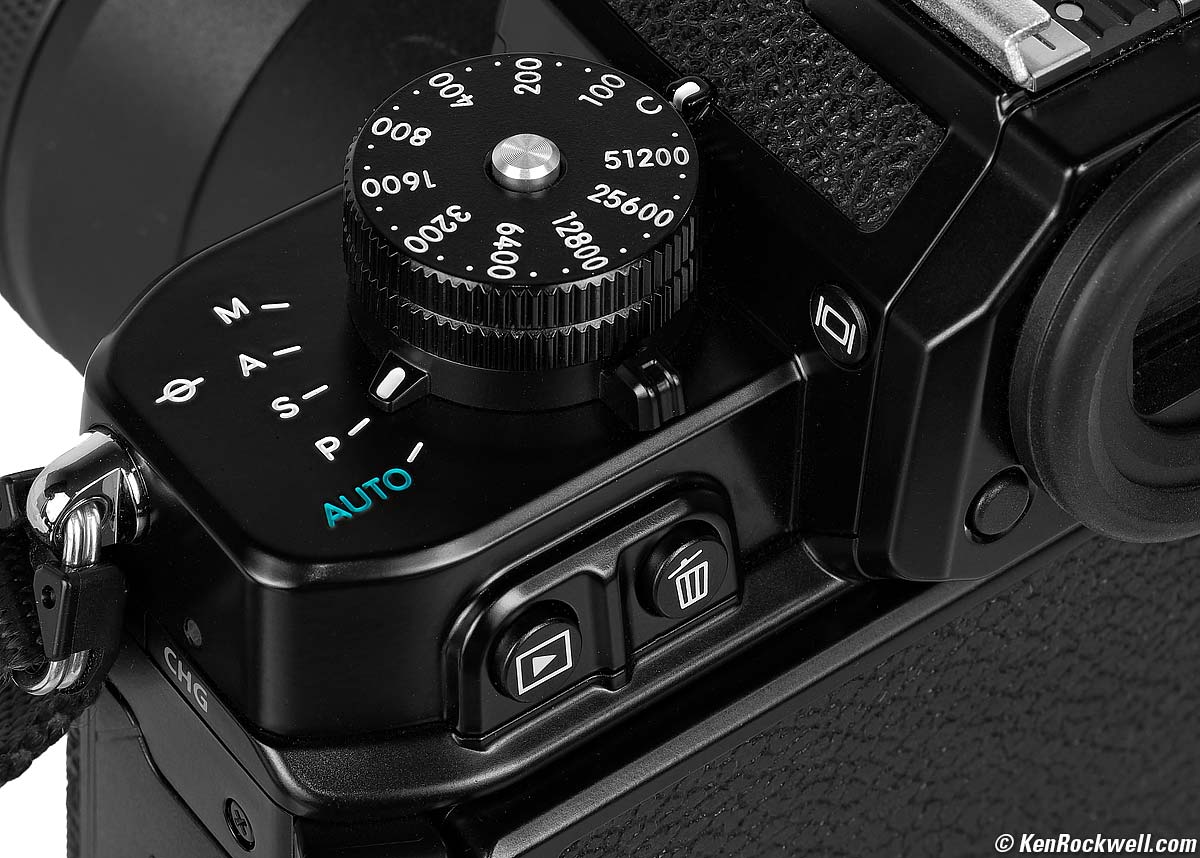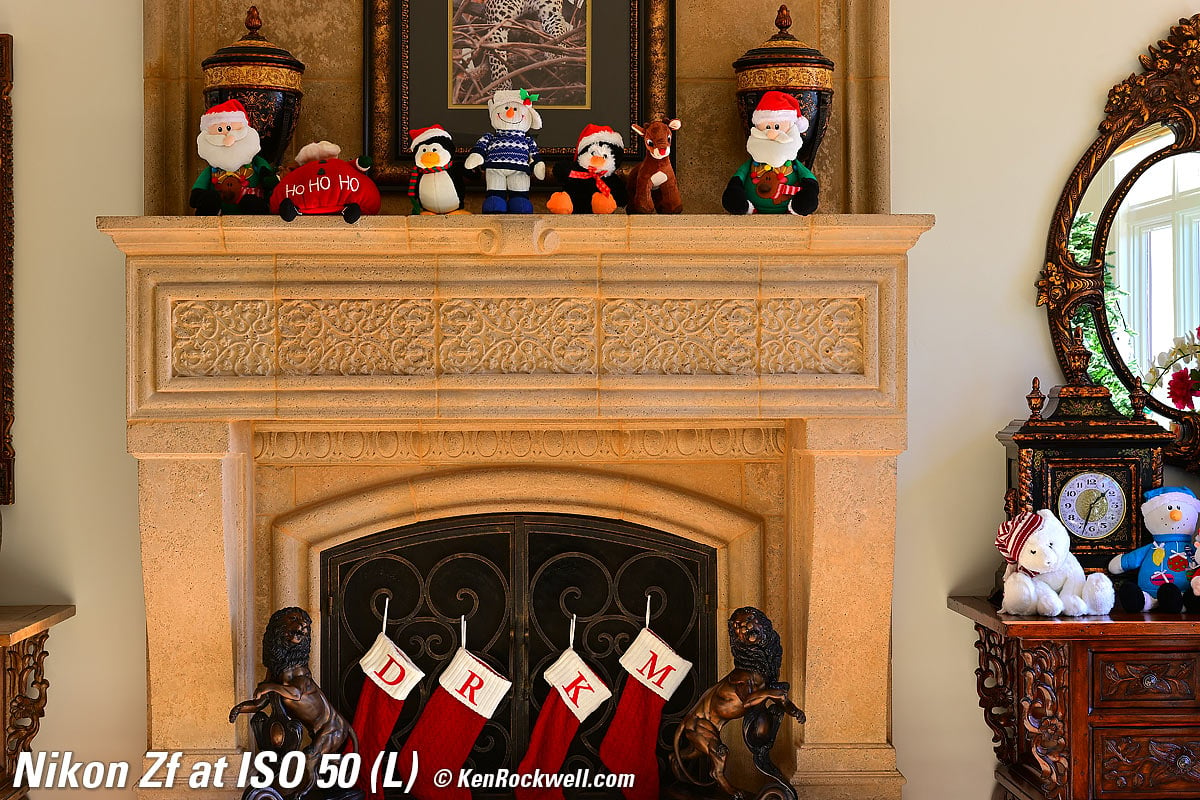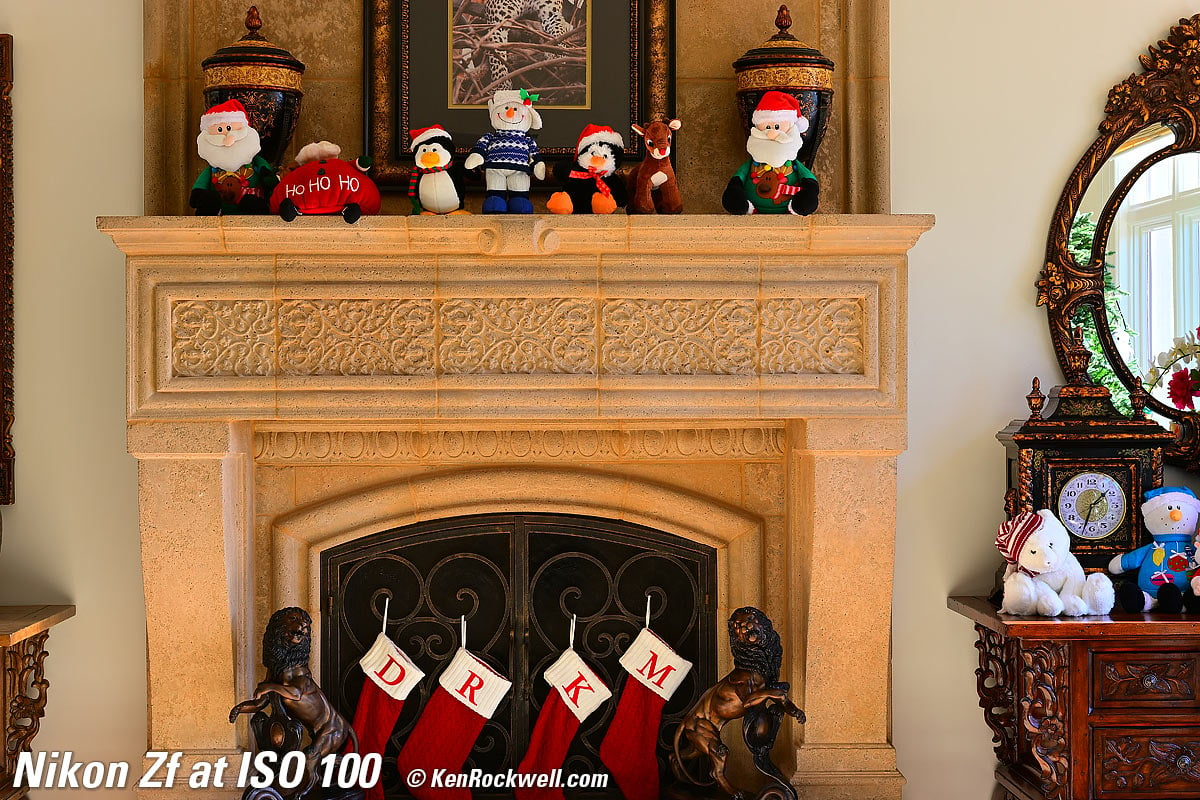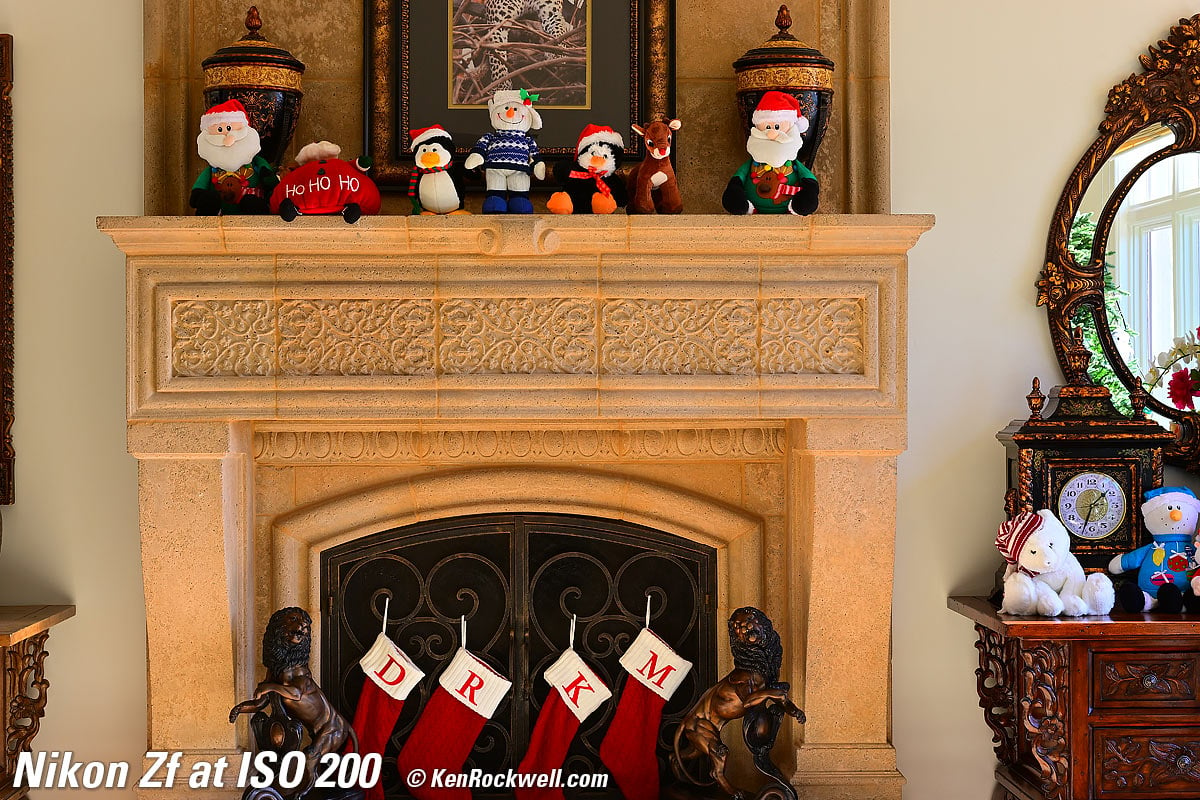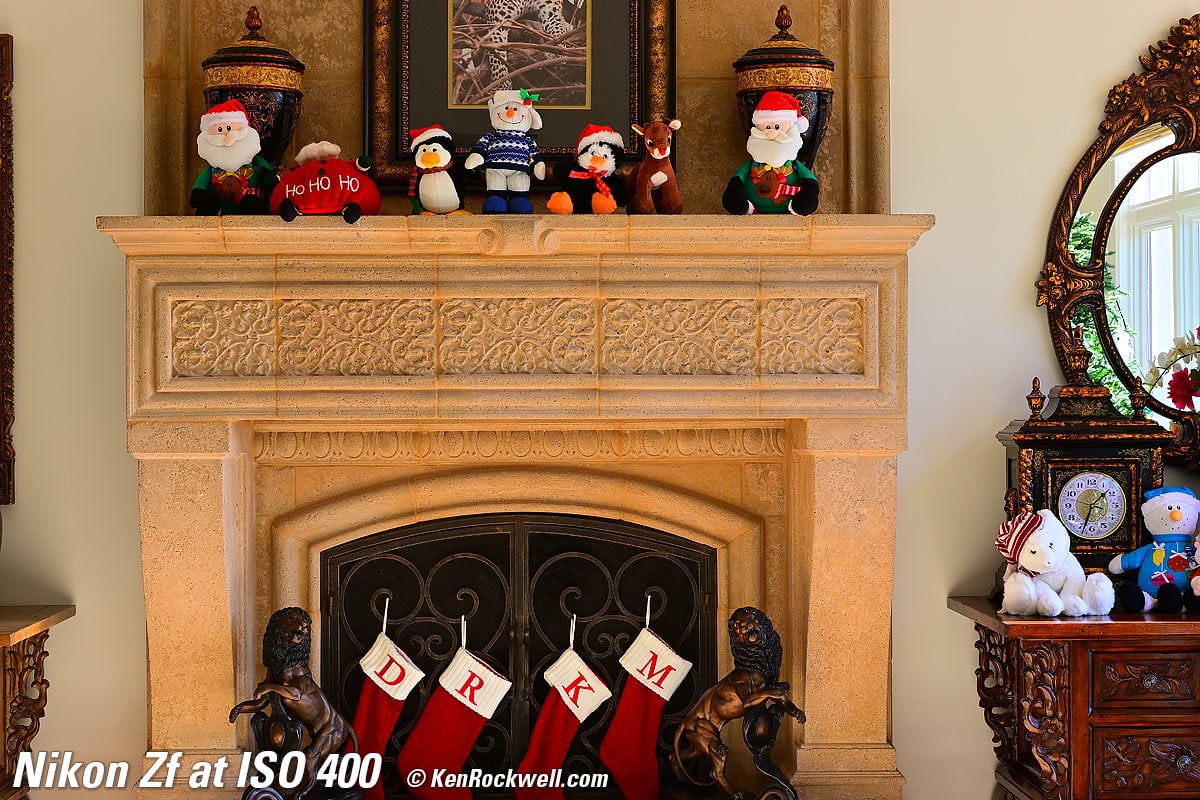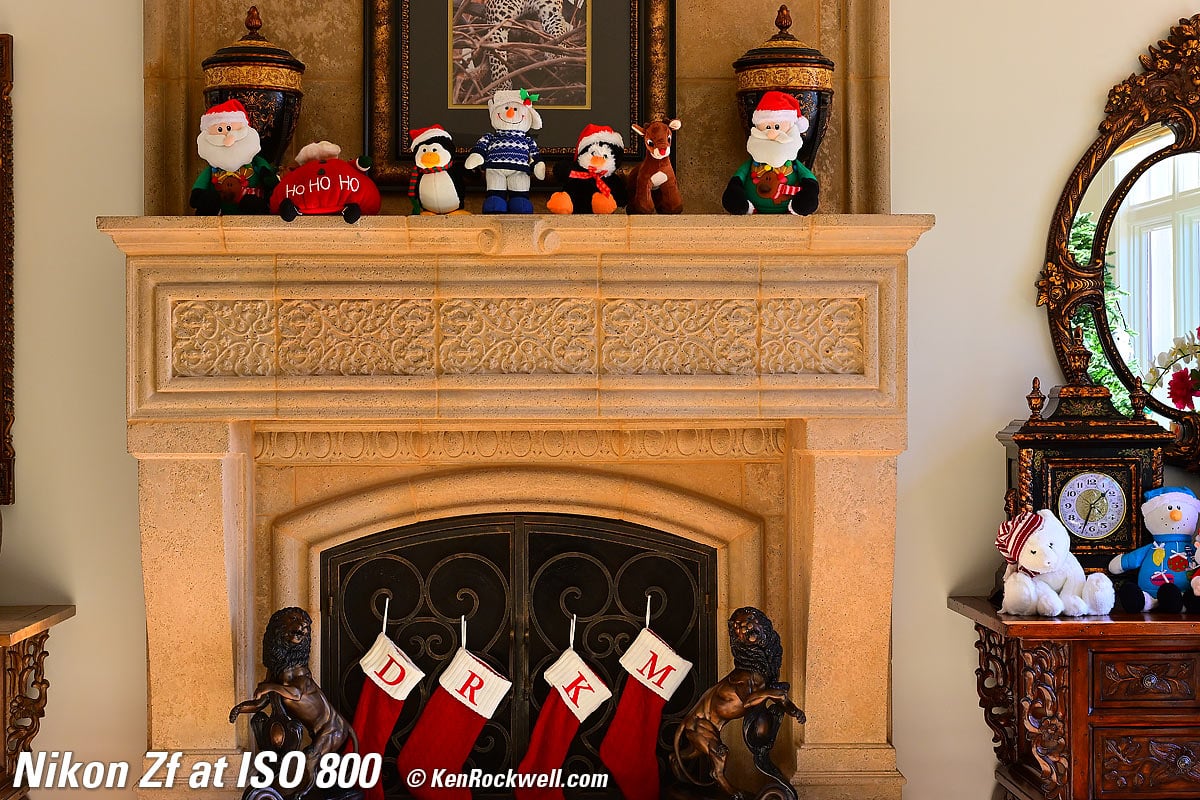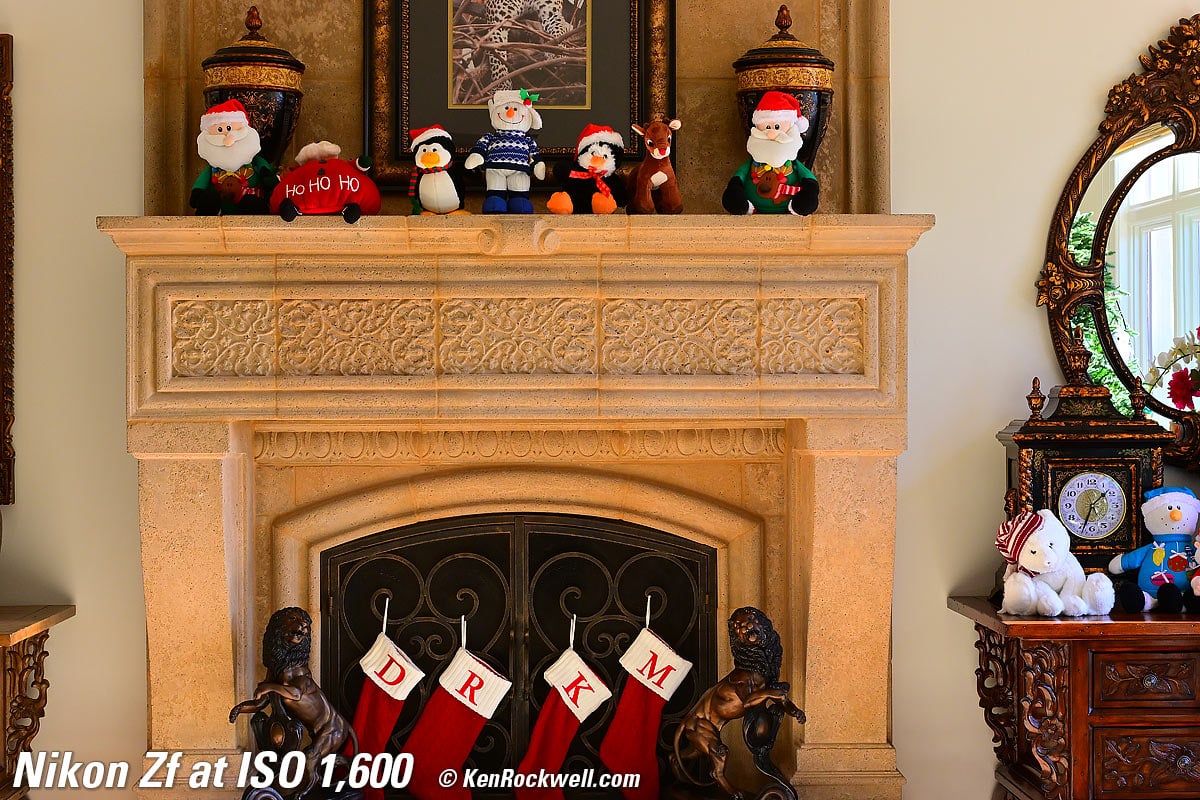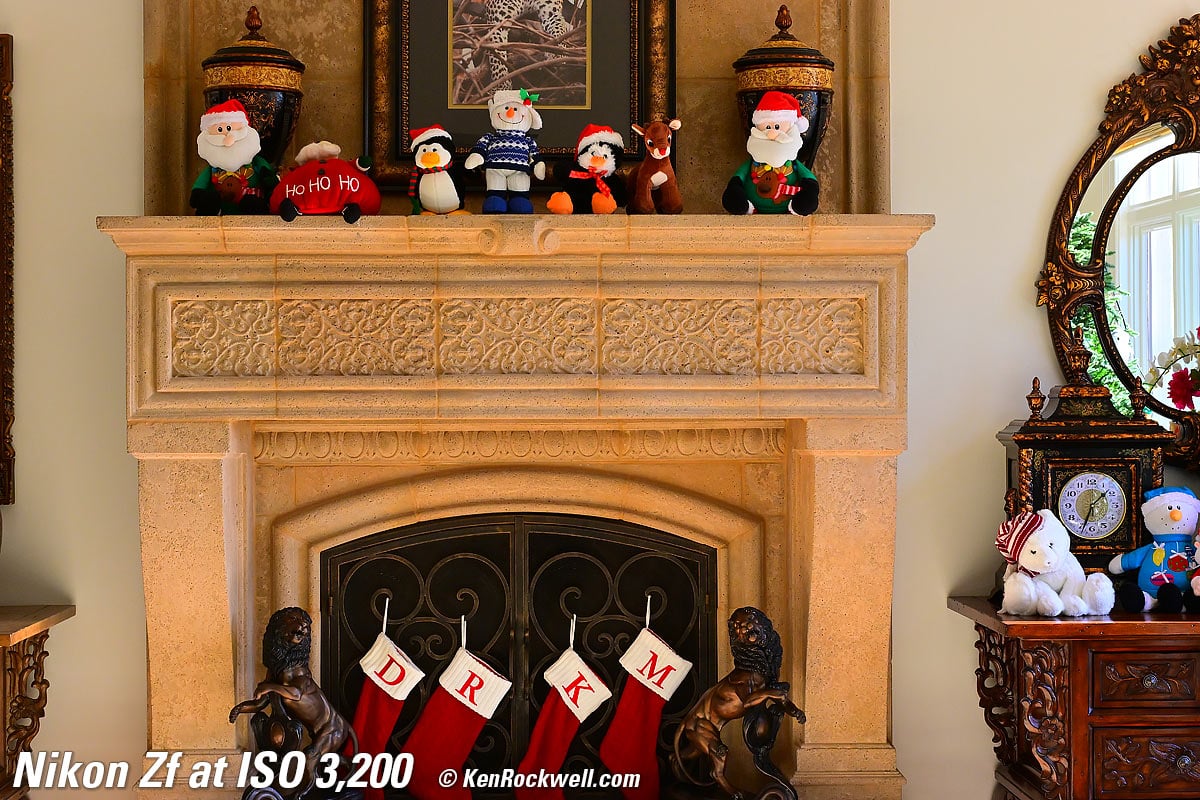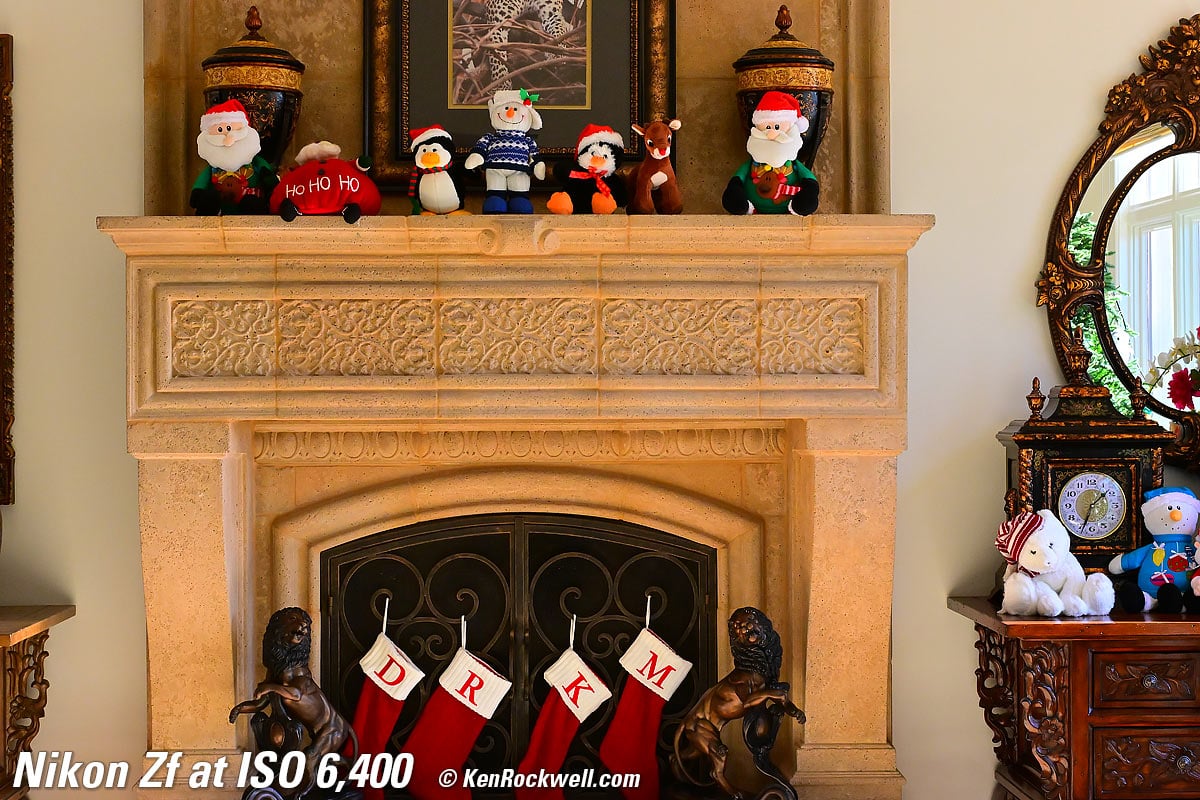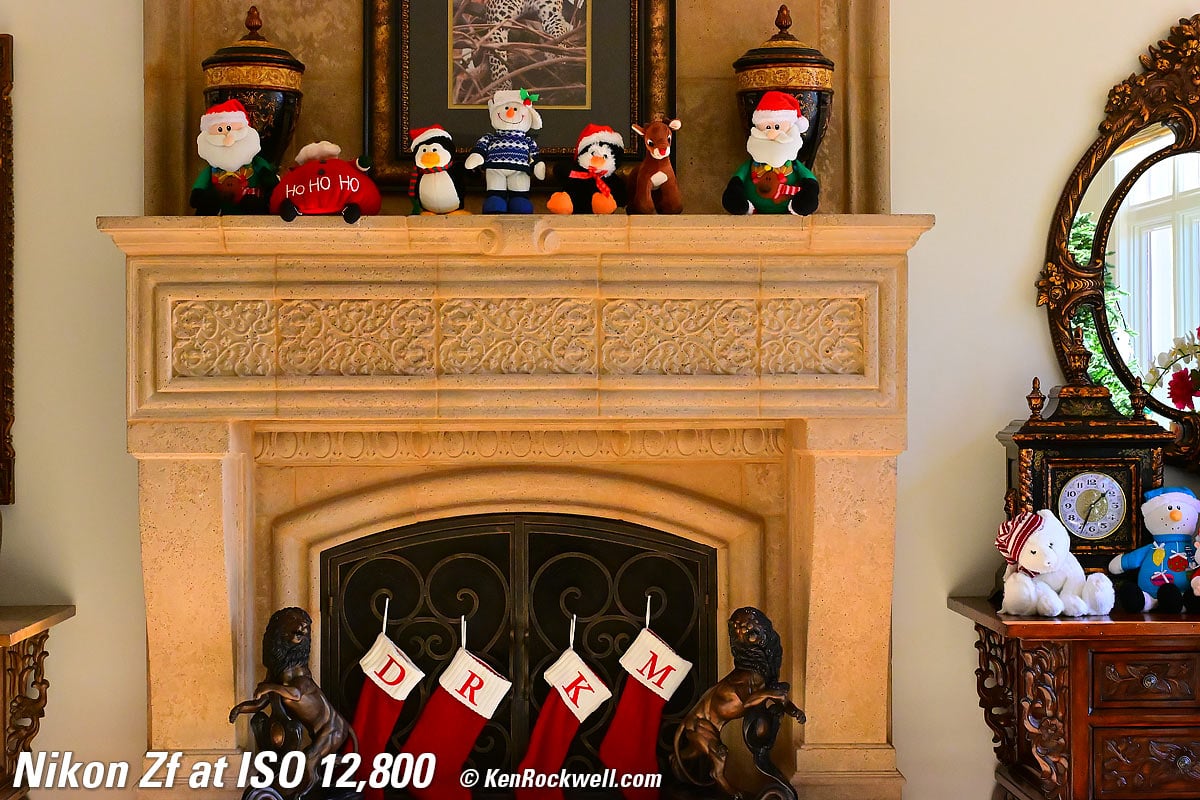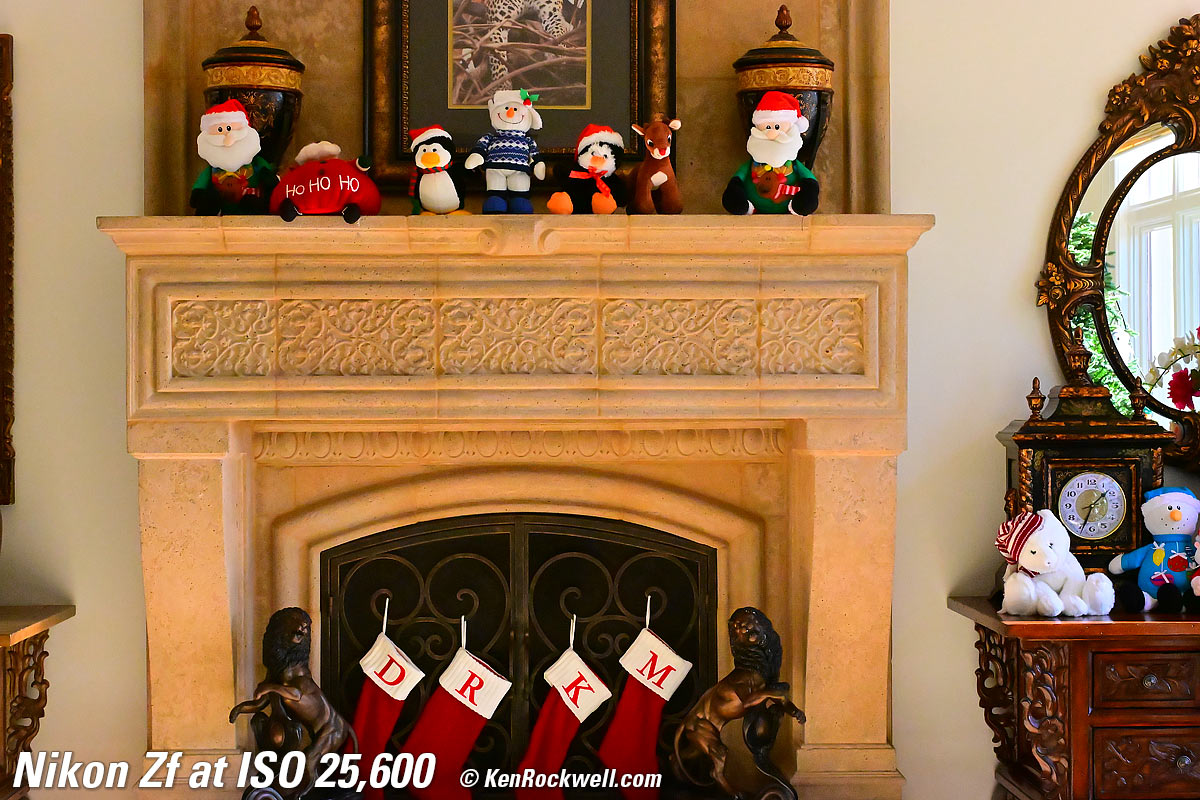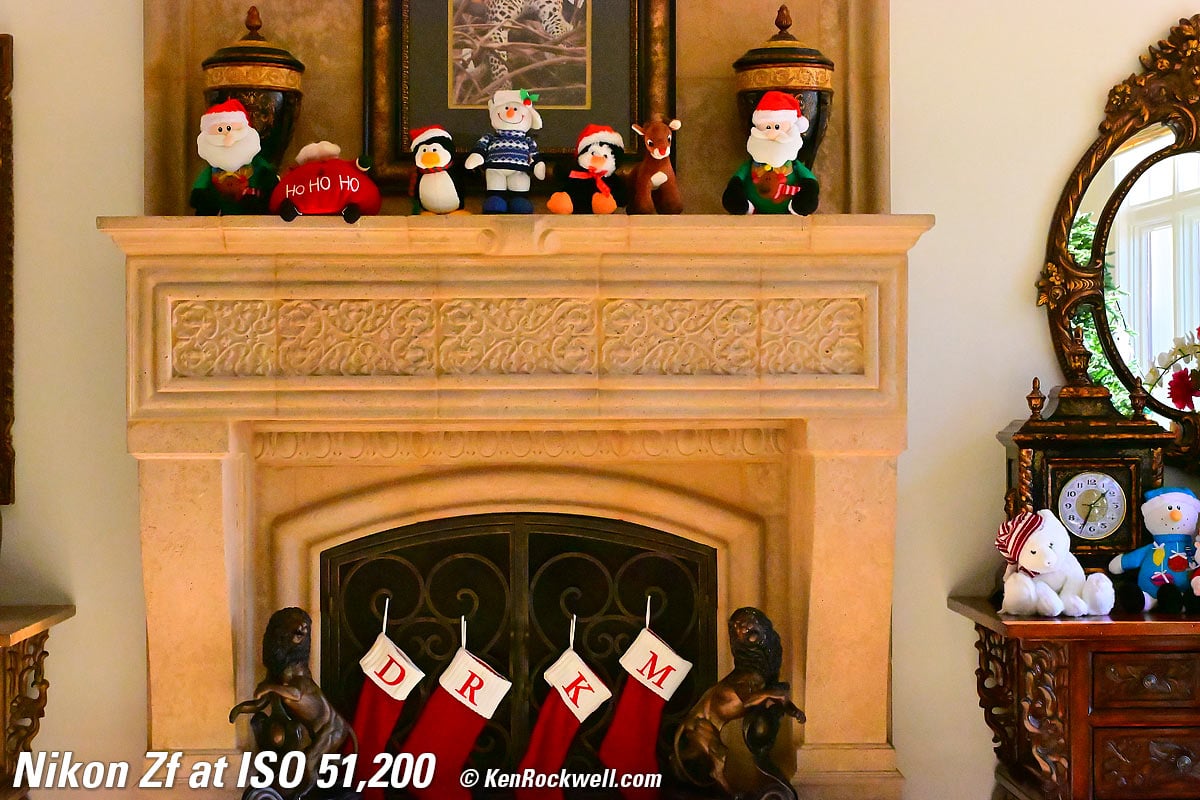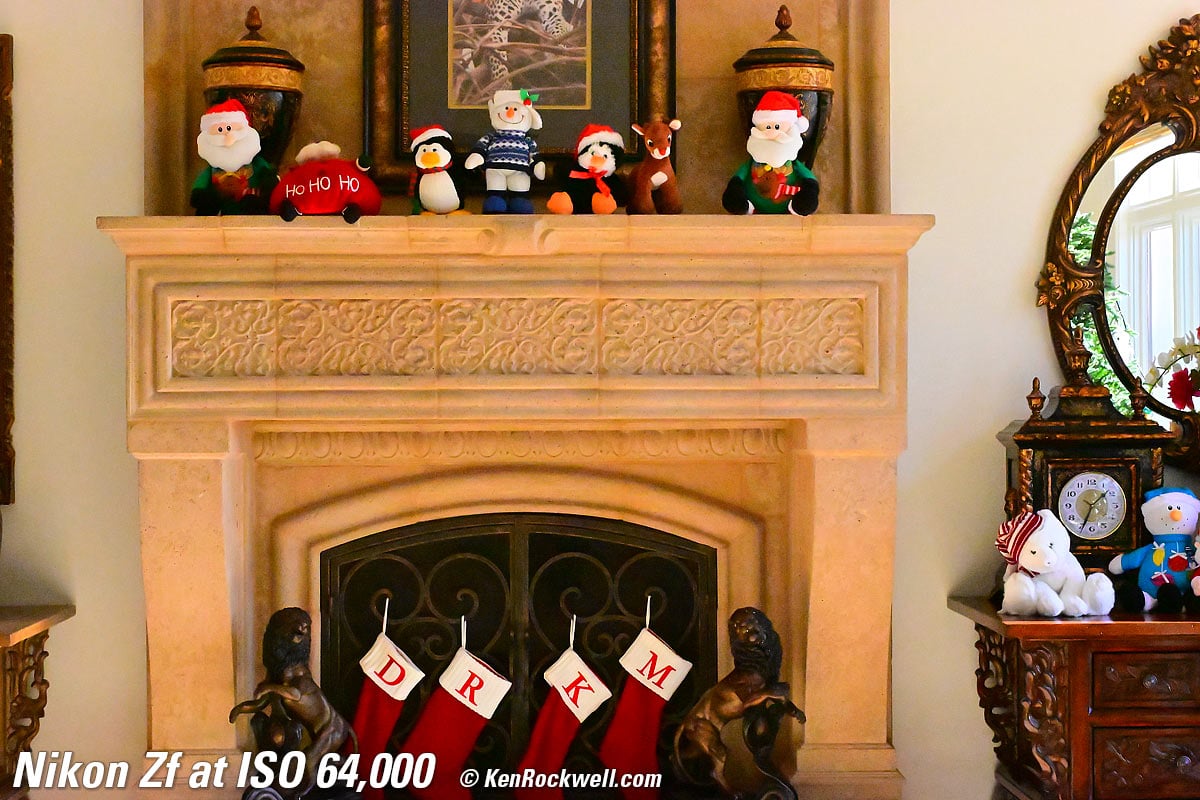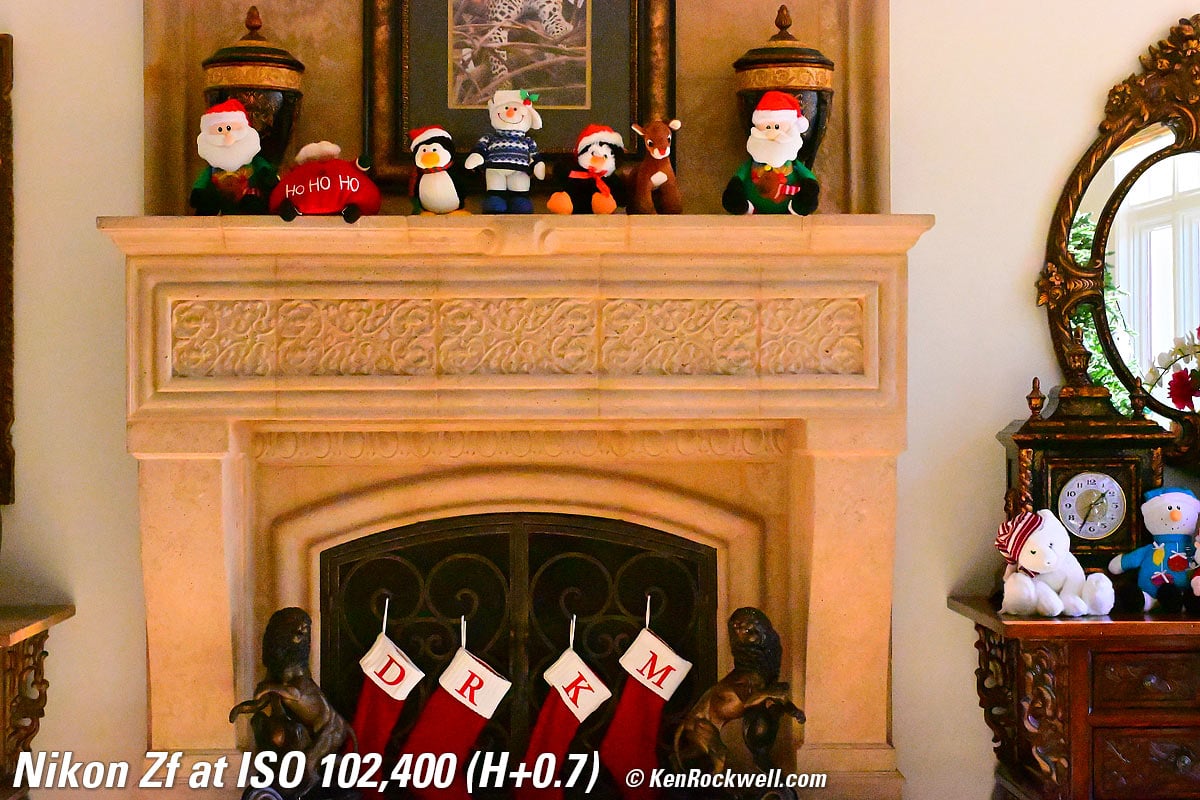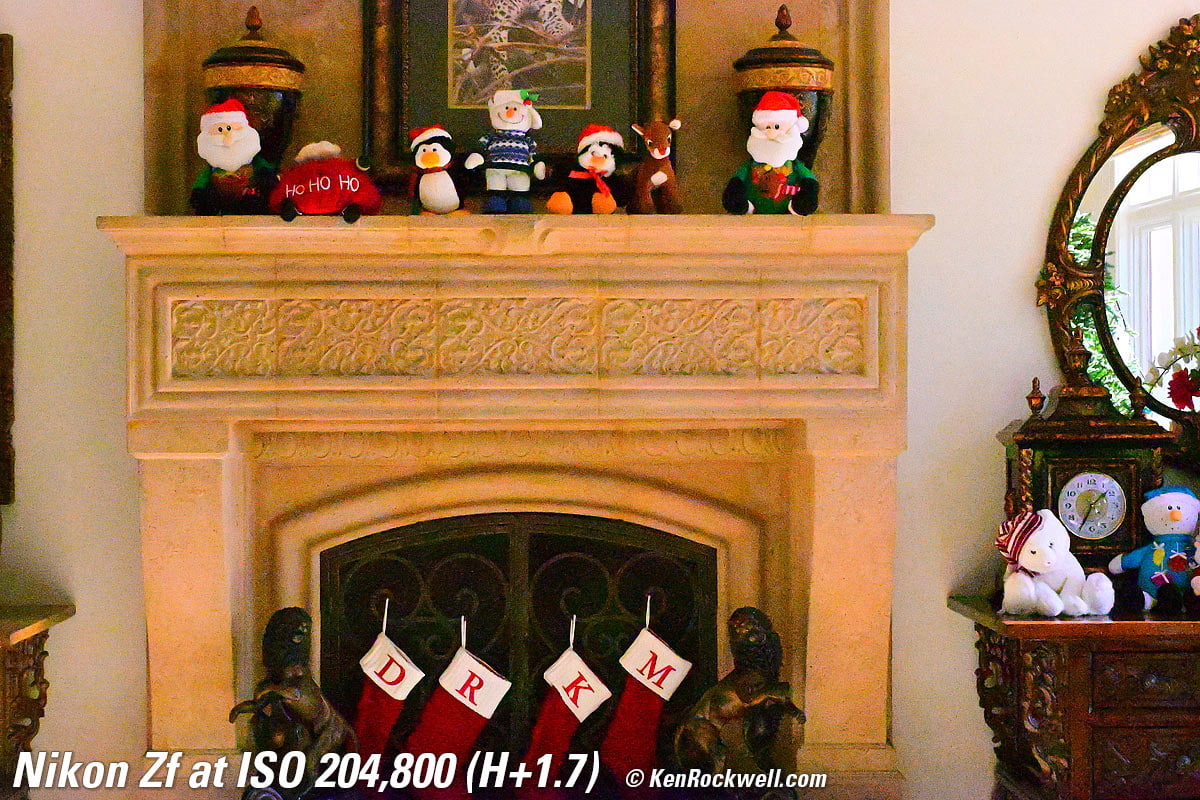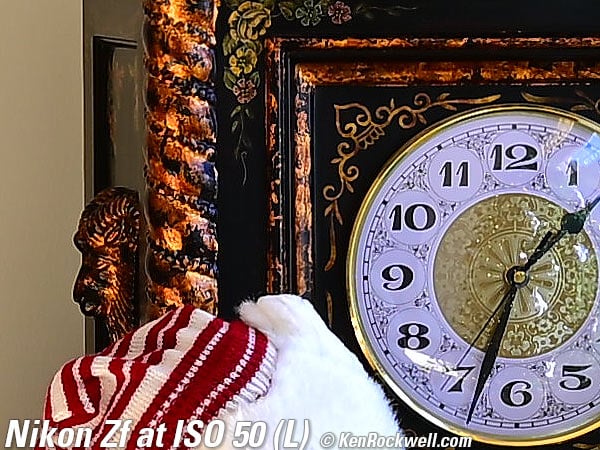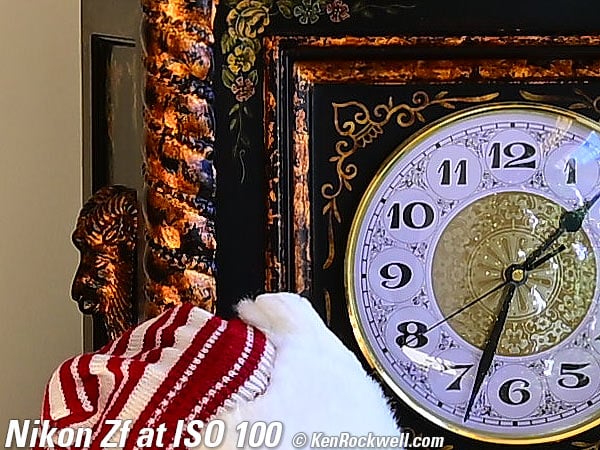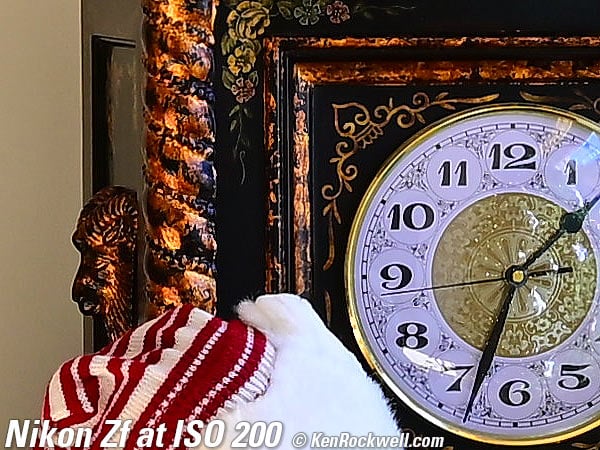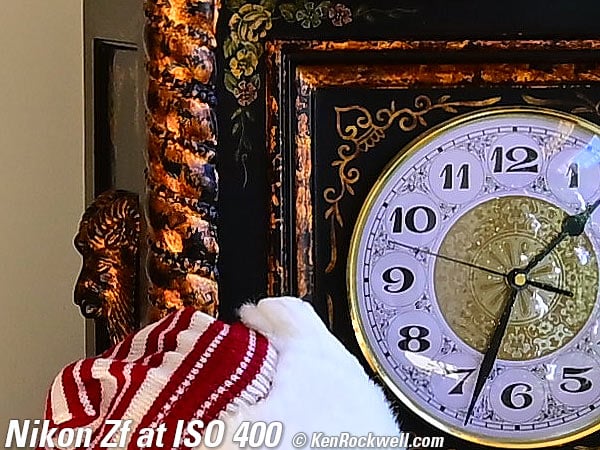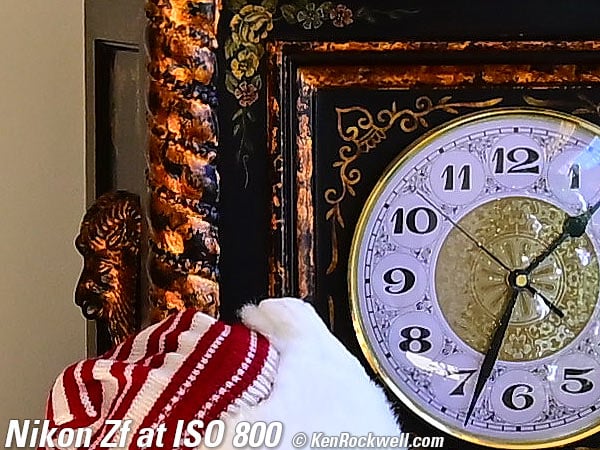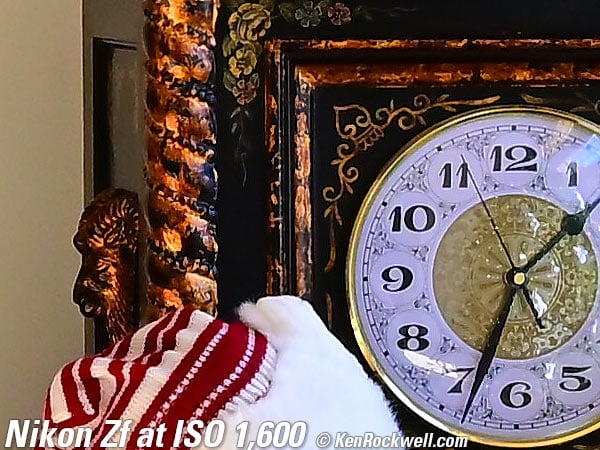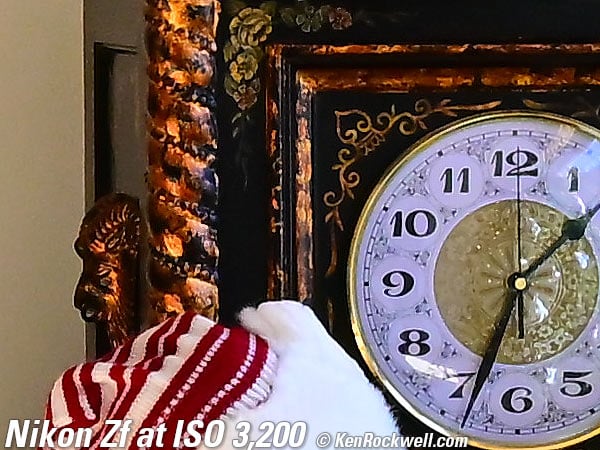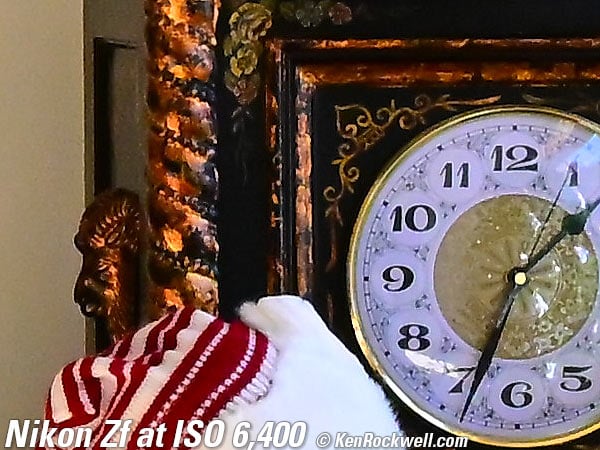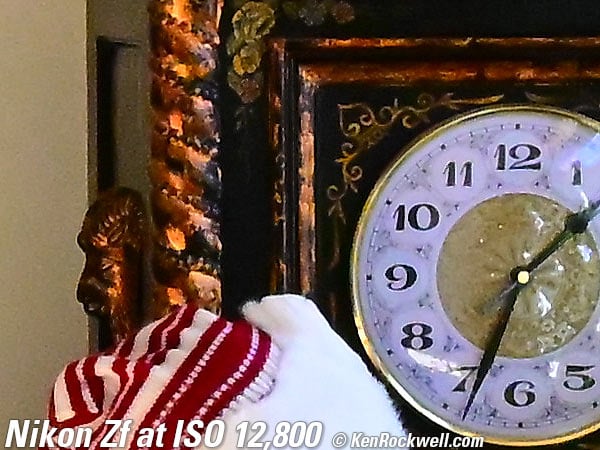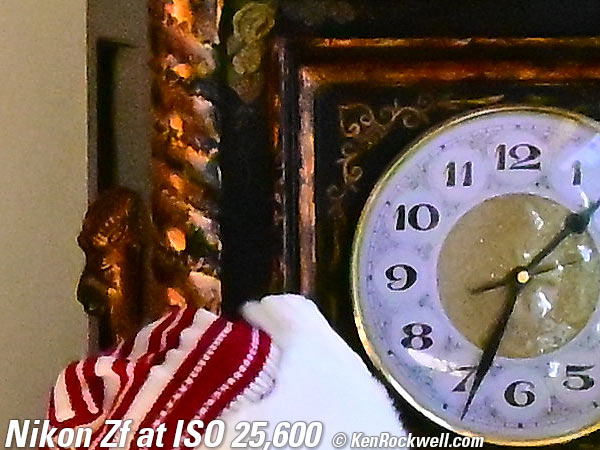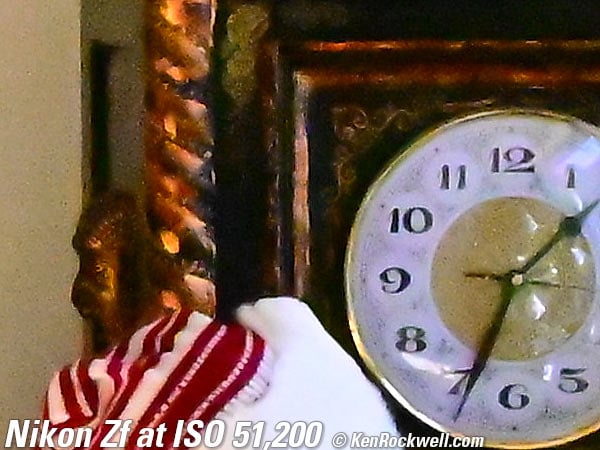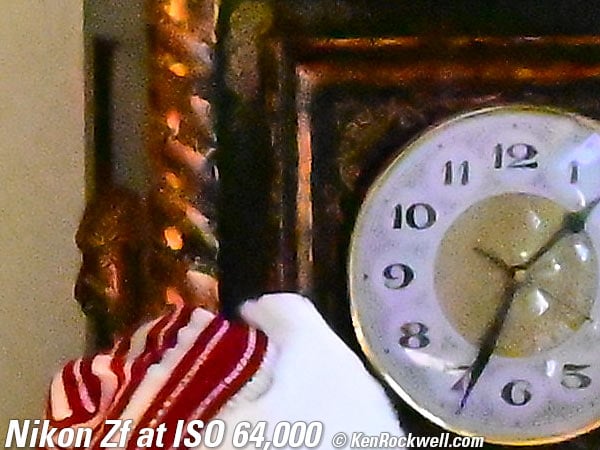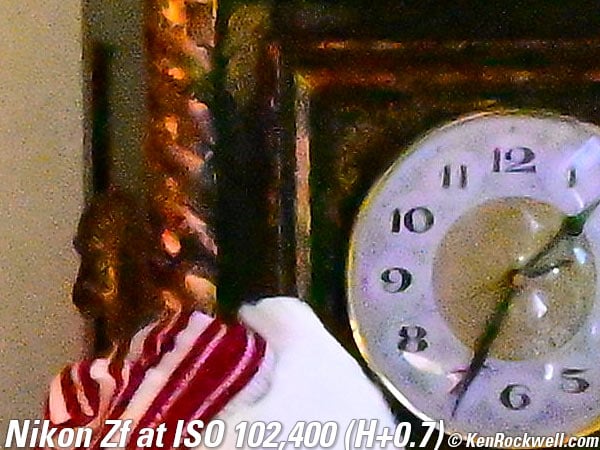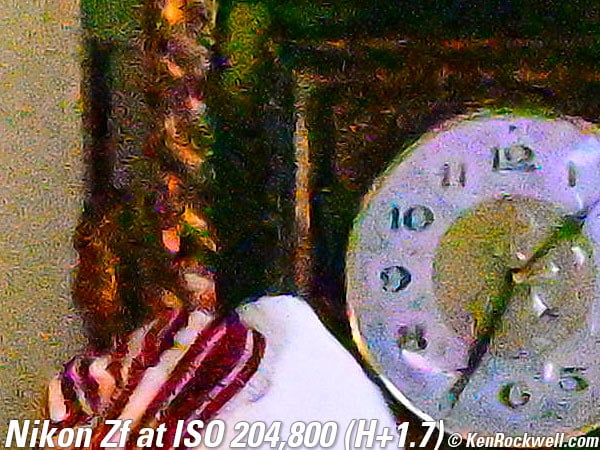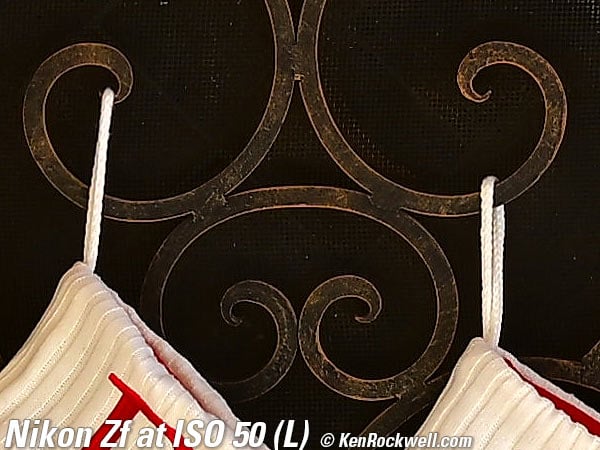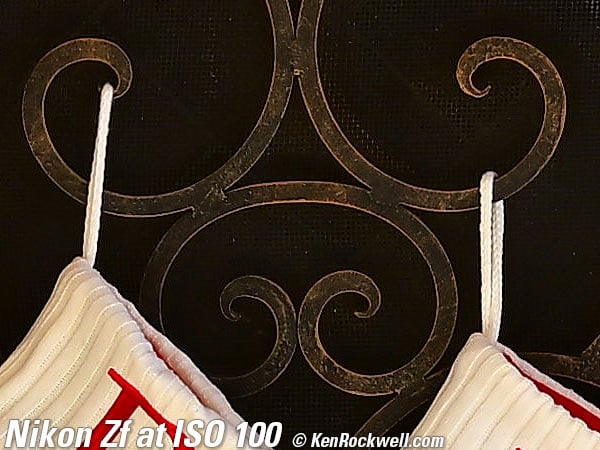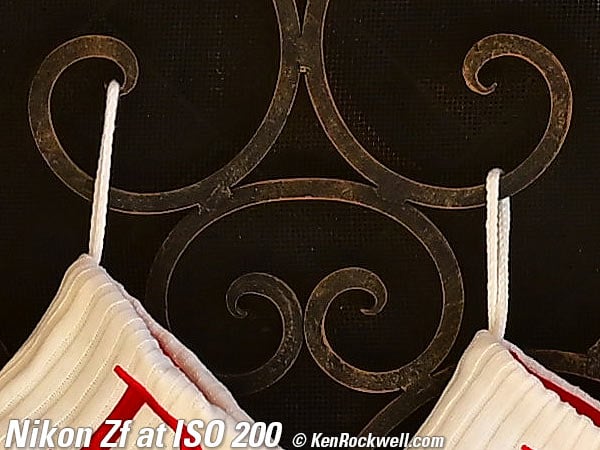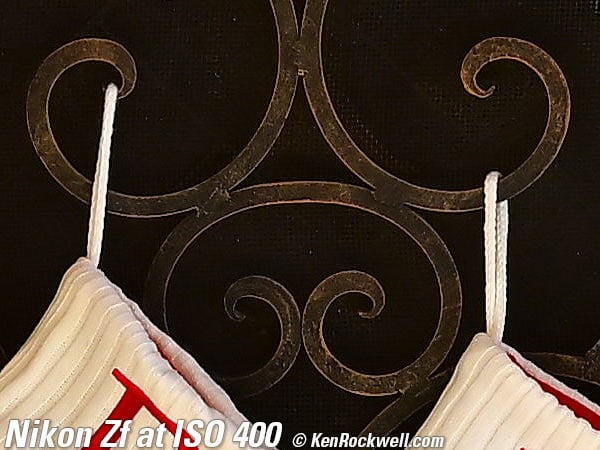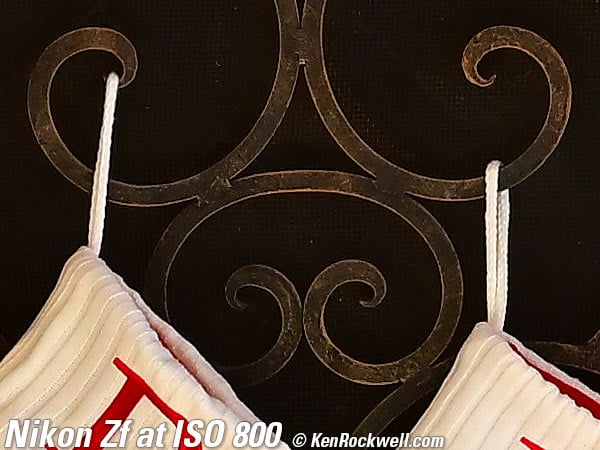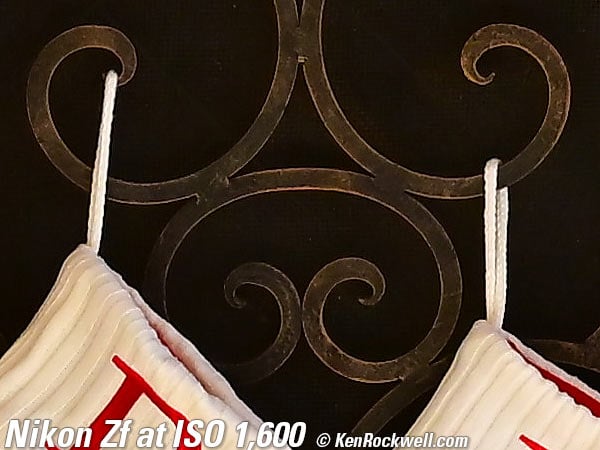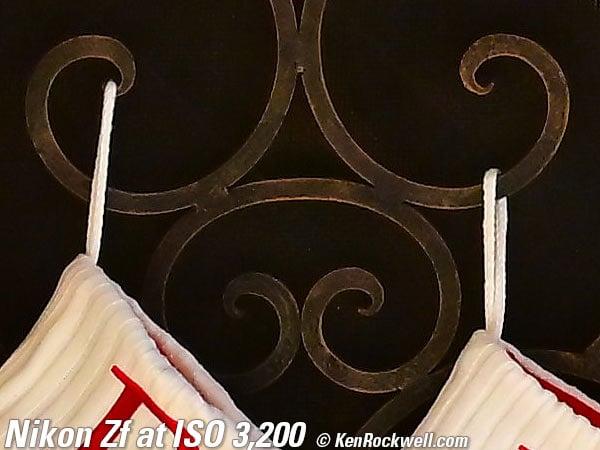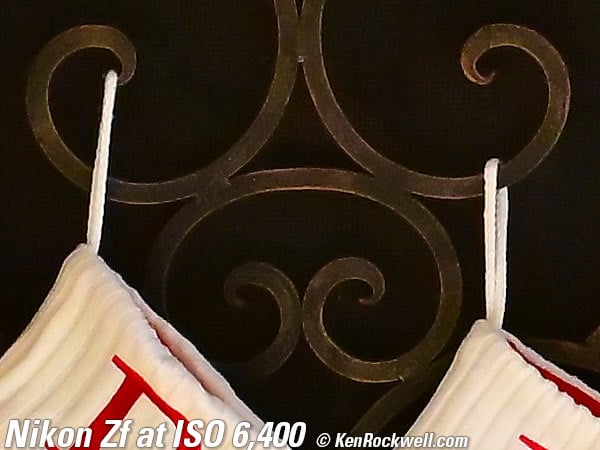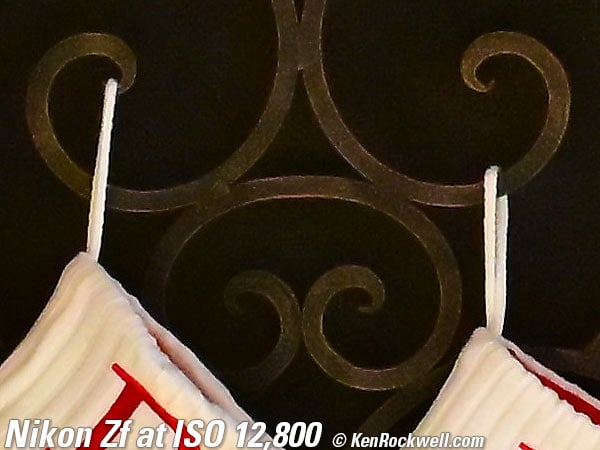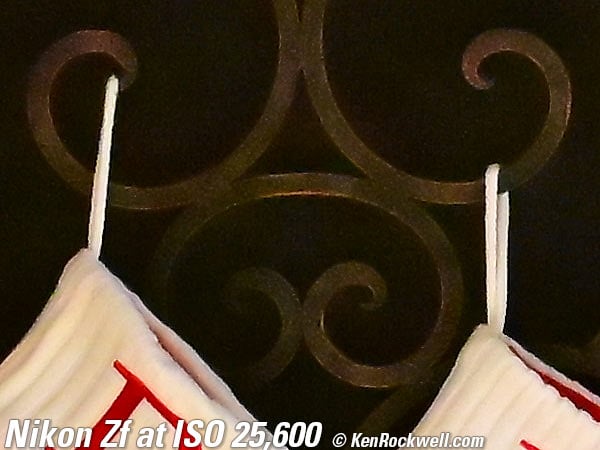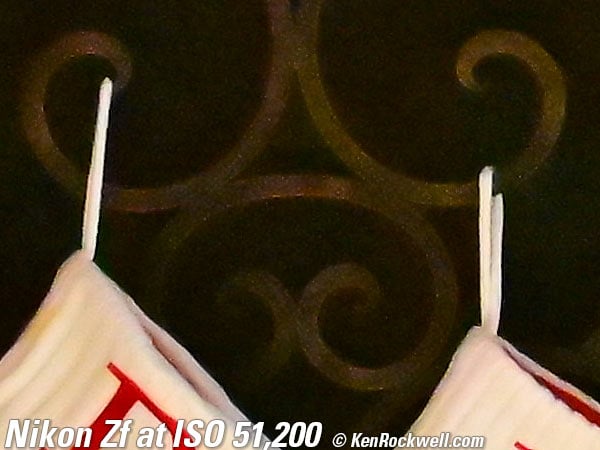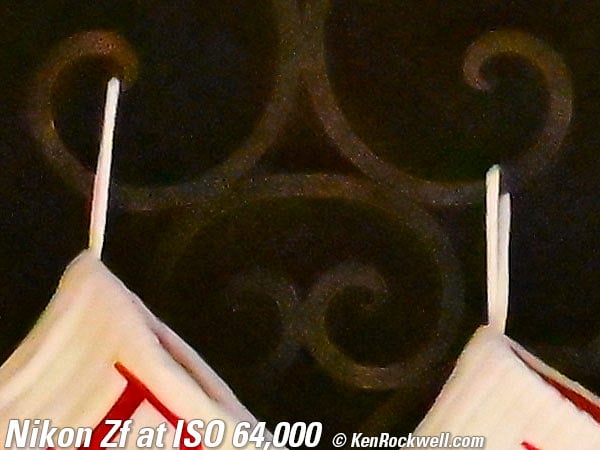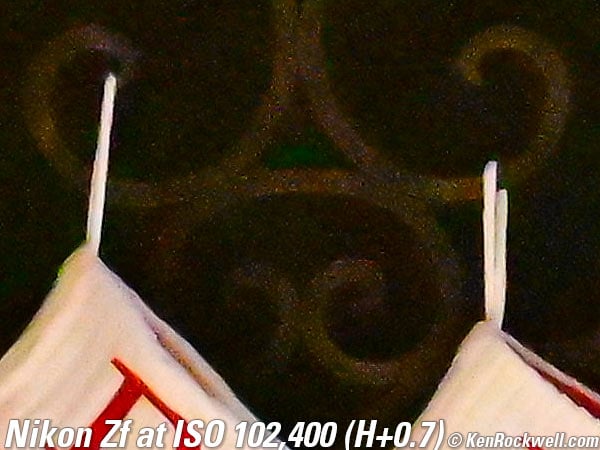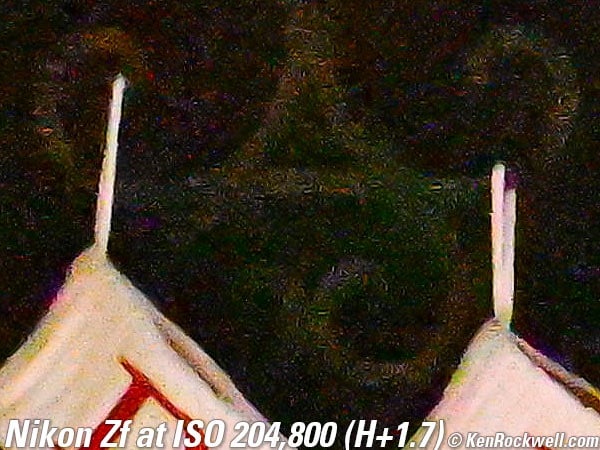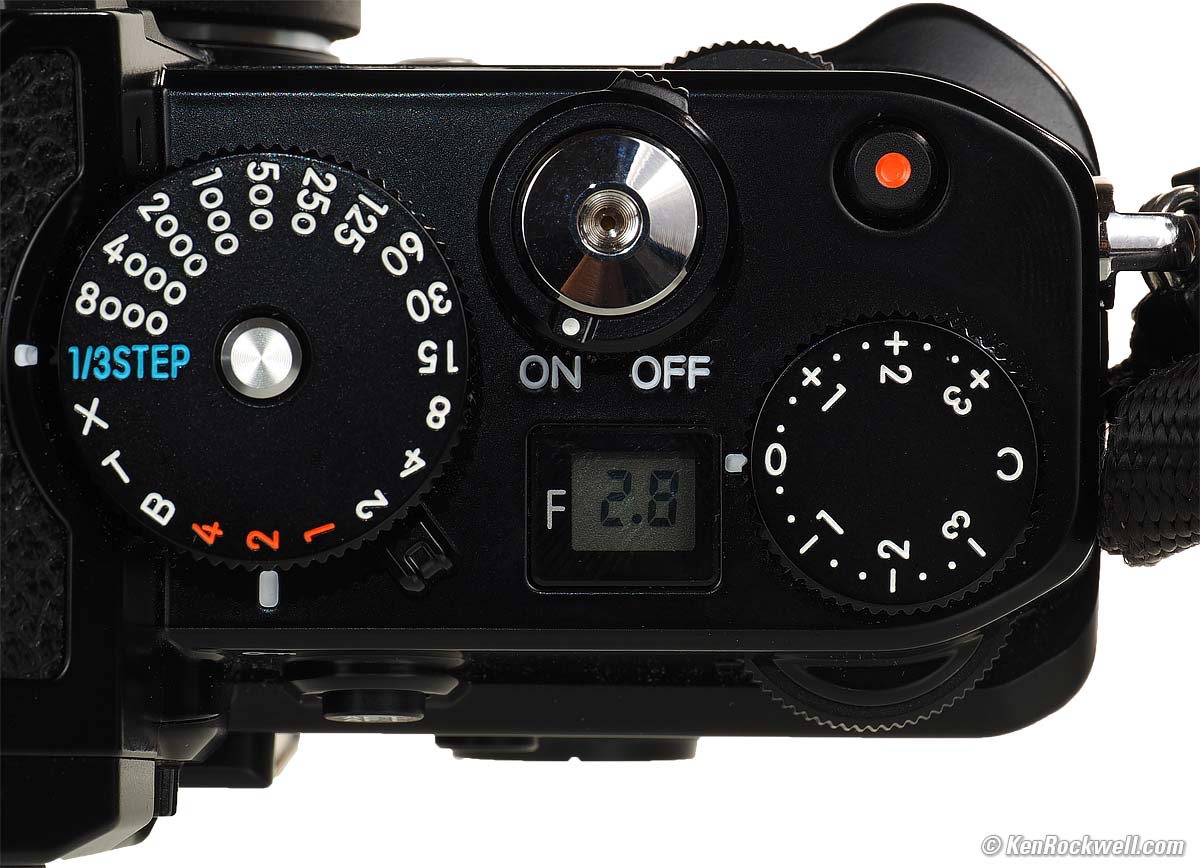Nikon Zf
Mirrorless 24MP FX, IBIS, ISO 100~64,000 (50L~204,800H), Silent 14 FPS, 4K60
Sample Images Intro New Good Bad Missing
Lens Compatibility Specifications USA Version
Performance User's Guide Recommendations
Z9 Z8 Z7 II Z6 II Zf Z7 Z6 Z5 Z fc Z50 Z30
Z System Z Lenses All Nikon Lenses Flash
Nikon Zf (25.1 oz./710g with battery and one SD card, also has a second micro SD slot, $1,997) and Nikon Z 40mm f/2 Special Edition. bigger. I got my Zf at at B&H:
Zf body-only: $1,997 at B&H, at Adorama, at Amazon and at Crutchfield, or get it used if you know How to Win at eBay.Zf with discounted Z 40mm f/2 Special Edition as shown above: $2,237 at B&H, at Adorama, at Amazon and at Crutchfield.
Zf with discounted Z 24-70mm f/4: $2,597 at B&H, at Adorama, at Amazon and at Crutchfield.
This 100% all-content, junk-free website's biggest source of support is when you use those or any of these links to my personally approved sources I've used myself for way over 100 combined years when you get anything, regardless of the country in which you live. Nikon does not seal its boxes in any way, so never buy at retail or any other source not on my personally approved list since you'll have no way of knowing if you're missing accessories, getting a defective, damaged, returned, non-USA, store demo or used camera — and all of my personally approved sources allow for 100% cash-back returns for at least 30 days if you don't love your new camera. I've used many of these sources since the 1970s because I can try it in my own hands and return it if I don't love it, and because they ship from secure remote warehouses where no one gets to touch your new camera before you do. Buy only from the approved sources I've used myself for decades for the best prices, service, return policies and selection.
January 2024 Nikon Mirrorless Mirrorless Lenses All Nikon Lenses Nikon Flash All Reviews
Nikon vs Canon vs Sony Full Frame Mirrorless Compared
Canon, Nikon, Sony, Fuji & OM SYSTEM Menu Systems Compared
Nikon Zf and Nikon Z 40mm f/2 Special Edition. bigger.
Sample Images top
Sample Images Intro New Good Bad Missing
Lens Compatibility Specifications USA Version
Performance User's Guide Recommendations
(more at High ISOs)
These are just snapshots; my real work is in my Gallery.
These are all shot hand-held as BASIC ★ JPGs; no tripods, NORMAL or FINE JPGs or RAW files were used or needed.
Packard, 8:52 AM, Saturday, 16 December 2023, Nikon Zf, Nikon Z 70-180mm f/2.8 at 125mm at f/4.5 at 1/320 at Auto ISO 100 (LV 12⅔), distracting elements erased with Luminar Neo's ERASE tool, dynamic optimization in Perfectly Clear (now sold as Radiant Photo). bigger or full resolution.
Orange BMW, 9:09 AM, Saturday, 16 December 2023, Nikon Zf, Nikon Z 70-180mm f/2.8 at 180mm wide-open at f/2.8 at 1/500 at Auto ISO 100 (LV 11.9), as shot. bigger.
Fletcher Cove Sunset, 4:37 PM, Monday, 18 December 2023. Vertical crop from horizontal Nikon Zf shot, Nikon Z 70-180mm f/2.8 at 81mm at f/6.3 at 1/1,000 at Auto ISO 110 (LV 15⅙), Radiant Photo. bigger.
Yellow Classic Car with Red Rose Wreath (try saying that five times fast!), 9:19 AM, Saturday, 23 December 2023, Nikon Zf, Nikon Z 135mm f/1.8 "Plena" at f/5 at 1/400 at Auto ISO 100 (LV 13.3), Perfectly Clear (now sold as Radiant Photo). bigger or full resolution.
Mercedes-Benz SL, 10:02 AM, Saturday, 23 December 2023, Nikon Zf, Nikon Z 135mm f/1.8 "Plena" at f/3.5 at 1/200 at Auto ISO 100 (LV 11¼), Perfectly Clear (now sold as Radiant Photo). bigger or full resolution.
Classic Corvette Emblem, 10:03 AM, Saturday, 23 December 2023, Nikon Zf, Nikon Z 135mm f/1.8 "Plena" at f/4 at 1/250 at Auto ISO 100, +0.7 stops exposure compensation (LV 12.0), as shot. bigger or camera-original © JPG file.
Introduction top
Sample Images Intro New Good Bad Missing
Lens Compatibility Specifications USA Version
Performance User's Guide Recommendations

I buy only from these approved sources. I can't vouch for ads below. |


 Everyone who owns the Zf loves it to death because is has great technical performance and it looks so cool, at least to Nikon old timers who remember the days when Nikon was number one for action, news and sports photography.
Everyone who owns the Zf loves it to death because is has great technical performance and it looks so cool, at least to Nikon old timers who remember the days when Nikon was number one for action, news and sports photography.
The Zf has most of the guts of the Z6 II in a body that looks just like a Nikon FE 35mm camera from 1977. The Zf is a Z6 II in a more stylish but less practical body.
The Zf looks like any of Nikon's compact series of professional 35mm cameras like the FE, FE2, FM, FM2, FM2n and FM3a made from 1977~ 2006. These were all fully professional high-end 35mm cameras in compact bodies designed for pros who needed complete reliability and portability under any and every conditions out in the field. Here's my classic chart of all of that series of 35mm cameras compared — but I'm getting distracted as there is nothing in common between the Zf and a 35mm camera other than looks; the lenses they use are completely different and even with the FTZ and FTZ II adapters Nikon's best manual focus lenses don't work anywhere near well as they do on 35mm and DSLR cameras, which have the correct mechanical parts sadly lacking in the FTZ and FTZ II.
The sensor, frame rates, shutter, finder and touch screen specifications are essentially identical to 2020's Z6 II. While Nikon claims it's more like the fancier Z8 in its marketing, it's really more of a Z6 II rather than a Z8.
 While I also love the Zf's shape and appearance, I'm not a fan of the Zf because its shape makes its control layout inferior to modern designs. It's a slave to fashion, and while it looks great around your neck, it's a pain for shooting as it has no real grip and the buttons and main control dials are very uncomfortable to reach. Their placement is defined by its style, not by where they belong.
While I also love the Zf's shape and appearance, I'm not a fan of the Zf because its shape makes its control layout inferior to modern designs. It's a slave to fashion, and while it looks great around your neck, it's a pain for shooting as it has no real grip and the buttons and main control dials are very uncomfortable to reach. Their placement is defined by its style, not by where they belong.
 While the ISO, Shutter Speed and Exposure Compensation dials look great, the more important front and rear general control dials are tiny, uncomfortable and inconvenient to reach. The rest of the buttons usually require having to pull your right thumb down and to the right to reach them, and the PLAY and DELETE button and MODE lever are on the wrong (left) side, requiring a second hand to reach.
While the ISO, Shutter Speed and Exposure Compensation dials look great, the more important front and rear general control dials are tiny, uncomfortable and inconvenient to reach. The rest of the buttons usually require having to pull your right thumb down and to the right to reach them, and the PLAY and DELETE button and MODE lever are on the wrong (left) side, requiring a second hand to reach.
The Nikon FE of 35mm film days was a wonderful camera, but we set very little to nothing other than moving the aperture and focus rings and wound the film from shot-to-shot. In film days setting ISO was only done if we loaded a different kind of film than we shot last roll, and that was it.
 Sadly the Zf makes doing everything else we do setting up every digital shot a relative pain compared to other mirrorless cameras. The Zf is a lifestyle camera you own and love for its looks and the decades of leadership it represents; I prefer the Nikon Z5 or Canon R6 II for actual shooting.
Sadly the Zf makes doing everything else we do setting up every digital shot a relative pain compared to other mirrorless cameras. The Zf is a lifestyle camera you own and love for its looks and the decades of leadership it represents; I prefer the Nikon Z5 or Canon R6 II for actual shooting.
 For instance, critical is my ability to reset my camera immediately from one kind of shooting (sports, portraits, landscapes, macro, products, studio, etc.) to another, as often I have to shoot different things from one frame to another. It takes too long when I'm in the field to have to reset a zillion things (color saturation, frame rate, AF-S or AF-C, AF area mode, LCD brightness, Auto ISO minimum shutter speed, Auto ISO range and a zillion other things) one by one for each frame. I'm a huge fan of the preset U1, U2 and U3 modes found on cameras like the Nikon Z5 and Canon R6 II to which I can program complete sets of all camera settings, and then recall all of them in one click. The Zf lacks this critical control, so actually to shoot the Zf I have to spend too long resetting everything about it each time I shoot something different, which is many times a day. In the real world life waits for no one to piddle with camera settings; you have to be ready to shoot in an instant, which I can't do with the Zf. If I shot just one kind of photo or spent more time reading about cameras than shooting the Zf would be awesome,but since I need it to jump when I say jump, it's not for me.
For instance, critical is my ability to reset my camera immediately from one kind of shooting (sports, portraits, landscapes, macro, products, studio, etc.) to another, as often I have to shoot different things from one frame to another. It takes too long when I'm in the field to have to reset a zillion things (color saturation, frame rate, AF-S or AF-C, AF area mode, LCD brightness, Auto ISO minimum shutter speed, Auto ISO range and a zillion other things) one by one for each frame. I'm a huge fan of the preset U1, U2 and U3 modes found on cameras like the Nikon Z5 and Canon R6 II to which I can program complete sets of all camera settings, and then recall all of them in one click. The Zf lacks this critical control, so actually to shoot the Zf I have to spend too long resetting everything about it each time I shoot something different, which is many times a day. In the real world life waits for no one to piddle with camera settings; you have to be ready to shoot in an instant, which I can't do with the Zf. If I shot just one kind of photo or spent more time reading about cameras than shooting the Zf would be awesome,but since I need it to jump when I say jump, it's not for me.
Nikon Zf and Noct-NIKKOR 58mm f/1.2s on FTZ. bigger.
 The Zf seems like it's begging to be shot with Nikon's classic manual-focus lenses on the FTZ or FTZ II adapters, but sadly the FTZ adapter is too big, and worse, those adapters are lacking at least two electromechanical interfaces needed to use those classic lenses properly. If you really want the ultimate Nikon digital experience, shoot manual-focus lenses on any FX DSLR like the D780, D850, D750 or many others, all of which have the correct mechanical sensors and actuators to read aperture ring position and to actuate the automatic diaphragm instantly for full-aperture focussing, which are all lacking on the FTZ and FTZ II adapters. For the ultimate style, get a used Nikon Df, which is unique in being the world's only FX DSLR which also looks like a 35mm camera, and it works far better with manual focus lenses than any mirrorless camera.
The Zf seems like it's begging to be shot with Nikon's classic manual-focus lenses on the FTZ or FTZ II adapters, but sadly the FTZ adapter is too big, and worse, those adapters are lacking at least two electromechanical interfaces needed to use those classic lenses properly. If you really want the ultimate Nikon digital experience, shoot manual-focus lenses on any FX DSLR like the D780, D850, D750 or many others, all of which have the correct mechanical sensors and actuators to read aperture ring position and to actuate the automatic diaphragm instantly for full-aperture focussing, which are all lacking on the FTZ and FTZ II adapters. For the ultimate style, get a used Nikon Df, which is unique in being the world's only FX DSLR which also looks like a 35mm camera, and it works far better with manual focus lenses than any mirrorless camera.
When you shoot pretty much every day for over 50 years as I have, you appreciate that the most important aspect of a camera isn't features about which you read at leisure; what's important is how well the camera just gets out of your way to get your picture with a minimum of fiddling. Sadly the Zf's control layout makes setting most things take too many clicks, and when shooting for a living, every click that isn't the shutter is wasting your time and costing you money.
The Zf has sensor-shift image stabilization, and stabilization works great, even with ancient 1940s rangefinder lenses!
I got my Zf at at B&H:
Zf body-only: $1,997 at B&H, at Adorama, at Amazon and at Crutchfield, or get it used if you know How to Win at eBay.Zf with discounted Z 40mm f/2 Special Edition as shown above: $2,237 at B&H, at Adorama, at Amazon and at Crutchfield.
Zf with discounted Z 24-70mm f/4: $2,597 at B&H, at Adorama, at Amazon and at Crutchfield.
New intro top
 Nikon's first mirrorless that lets us program the touch screen to select AF points as we're looking though the finder. It's about time; every other Nikon is completely behind Sony and Canon making us have to click that idiotic rear controller; the Zf is the first and only Nikon that lets us use the LCD as a huge touch panel for moving AF areas around. Geesh, this was and still is such a huge omission from every other Nikon.
Nikon's first mirrorless that lets us program the touch screen to select AF points as we're looking though the finder. It's about time; every other Nikon is completely behind Sony and Canon making us have to click that idiotic rear controller; the Zf is the first and only Nikon that lets us use the LCD as a huge touch panel for moving AF areas around. Geesh, this was and still is such a huge omission from every other Nikon.
 Shooting data and playback images and data rotate automatically in the finder and rear LCD as we rotate the Zf. (Menus still don't rotate).
Shooting data and playback images and data rotate automatically in the finder and rear LCD as we rotate the Zf. (Menus still don't rotate).
 AF range rated LV -10 ~ +19 with an f/1.2 lens. Minus ten LV!
AF range rated LV -10 ~ +19 with an f/1.2 lens. Minus ten LV!
 Nikon's first full-frame mirrorless tribute camera, following the Df DSLR tribute and the Z fc DX tribute.
Nikon's first full-frame mirrorless tribute camera, following the Df DSLR tribute and the Z fc DX tribute.
 Nikon's first full-frame mirrorless with a normal flippy screen rather than the idiotic tilt mechanisms of older cameras that never let the screen move very far:
Nikon's first full-frame mirrorless with a normal flippy screen rather than the idiotic tilt mechanisms of older cameras that never let the screen move very far:
Nikon Zf flippy screen. bigger.
 Maximum video rate at 4K is now 59.94p (progressive), up from 29.97p. (In Hollywood everything is shot at 23.976 FPS; higher rates are rarely for serious motion picture work.)
Maximum video rate at 4K is now 59.94p (progressive), up from 29.97p. (In Hollywood everything is shot at 23.976 FPS; higher rates are rarely for serious motion picture work.)
 "Pixel Shift" higher-resolution scanning.
"Pixel Shift" higher-resolution scanning.
 In-camera VR rated 8 stops improvement, the best of any Nikon.
In-camera VR rated 8 stops improvement, the best of any Nikon.
 VR clever enough to optimize itself to the selected focus point.
VR clever enough to optimize itself to the selected focus point.
 Dedicated switch for B&W mode (under the shutter speed dial).
Dedicated switch for B&W mode (under the shutter speed dial).
 First Nikon with a micro SD slot, in addition to the usual SD card.
First Nikon with a micro SD slot, in addition to the usual SD card.
 HLG still photo tone mode, set at MENU > 📷 PHOTO SHOOTING MENU (camera icon) > Tone mode > HLG. I always leave this alone and leave it set at SDR.
HLG still photo tone mode, set at MENU > 📷 PHOTO SHOOTING MENU (camera icon) > Tone mode > HLG. I always leave this alone and leave it set at SDR.
 Now can shoot HEIF, but no longer offers TIF.
Now can shoot HEIF, but no longer offers TIF.
 Video now runs up to 125 minutes per take.
Video now runs up to 125 minutes per take.
 No more wired remote connector; has what looks like a standard threaded cable release socket like real camera — but doesn't work!
No more wired remote connector; has what looks like a standard threaded cable release socket like real camera — but doesn't work!
Good intro top
 Easy Voice Note recorder if you set the Fn button accordingly at MENU > ✎ (pencil icon) CUSTOM SETTINGS MENU > f Controls > f3 Custom Controls (playback) > Fn button > Voice memo. Play an image, hold the button and talk: one-click and done — no menus required. Tap again to play the note: easy!
Easy Voice Note recorder if you set the Fn button accordingly at MENU > ✎ (pencil icon) CUSTOM SETTINGS MENU > f Controls > f3 Custom Controls (playback) > Fn button > Voice memo. Play an image, hold the button and talk: one-click and done — no menus required. Tap again to play the note: easy!
 Magnesium alloy top and bottom covers.
Magnesium alloy top and bottom covers.
 Made with lots of metal with engraved markings.
Made with lots of metal with engraved markings.
 In-camera sensor-shift image-stabilization rated for 8 stops improvement, up from just 5 stops in the Z6 II.
In-camera sensor-shift image-stabilization rated for 8 stops improvement, up from just 5 stops in the Z6 II.
 Timed manual exposures out to 15 minutes (900 seconds) if you enable them at MENU > CUSTOM SETTING MENU (pencil icon> Shooting/display > d6 Extended shutter speeds (M) > ON.
Timed manual exposures out to 15 minutes (900 seconds) if you enable them at MENU > CUSTOM SETTING MENU (pencil icon> Shooting/display > d6 Extended shutter speeds (M) > ON.
 Optional square 1:1 and 16:9 crops as-shot. I usually shoot in 1:1 since the native 3:2 is usually to long and skinny for me, and with square images I never have to turn the camera to shoot verticals.
Optional square 1:1 and 16:9 crops as-shot. I usually shoot in 1:1 since the native 3:2 is usually to long and skinny for me, and with square images I never have to turn the camera to shoot verticals.
 Simple ON/OFF menu entries usually need but one click to change them. No longer do we have to select an item, clicking up or down to select the other OFF or ON option, and then hit OK to register the selection. You can toggle them directly at the menu listing, bravo!
Simple ON/OFF menu entries usually need but one click to change them. No longer do we have to select an item, clicking up or down to select the other OFF or ON option, and then hit OK to register the selection. You can toggle them directly at the menu listing, bravo!
 Settings save and recall from a card.
Settings save and recall from a card.
 Crud-resistant fluorine-coated finder eyepiece.
Crud-resistant fluorine-coated finder eyepiece.
 Aspherical eyepiece elements.
Aspherical eyepiece elements.
 Wi-Fi and Bluetooth.
Wi-Fi and Bluetooth.
 Multiple exposures.
Multiple exposures.
 Lots of weather-sealing gaskets:
Lots of weather-sealing gaskets:
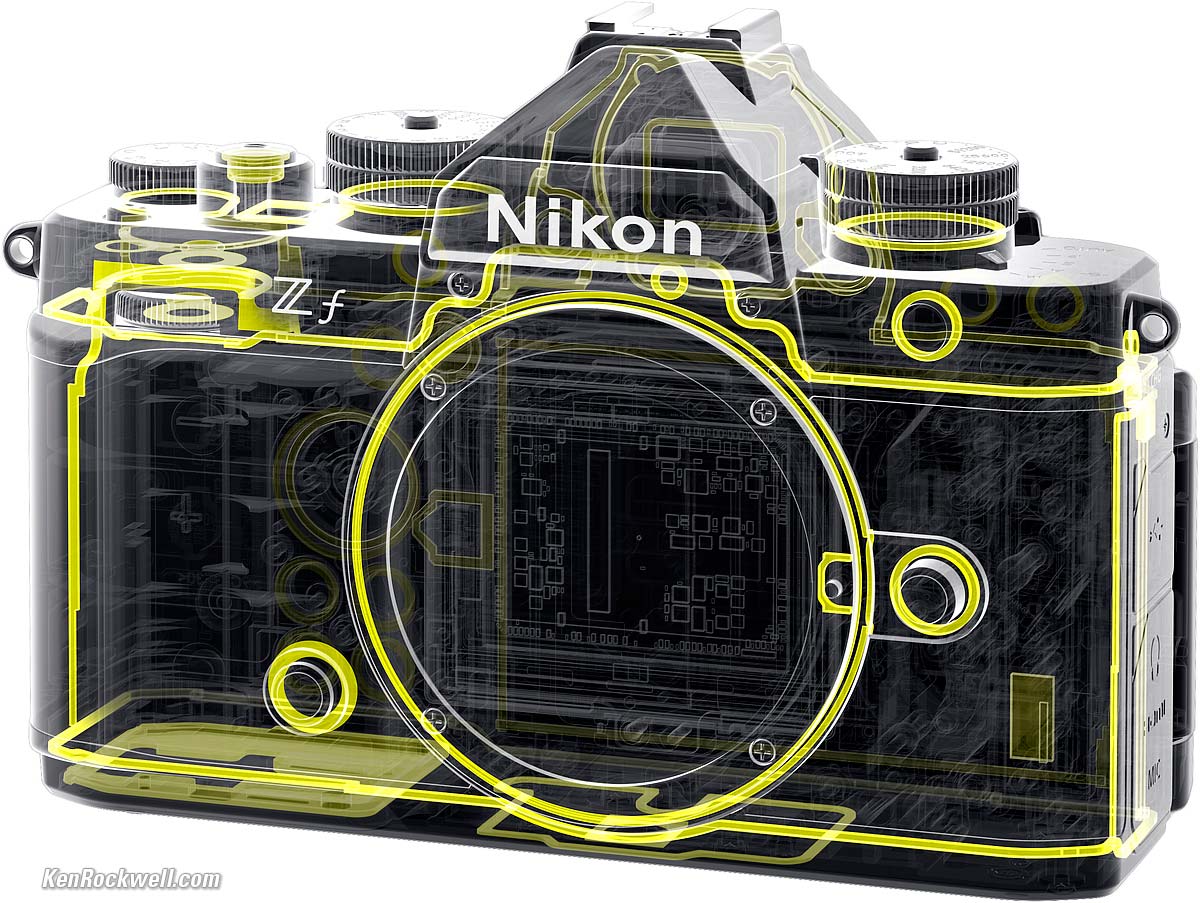
Nikon Zf and Z 24-70mm f/4 gaskets. bigger.
Bad intro top
 The exposure mode lever is on the left (wrong) side of the Zf, so it takes a second hand to change it!
The exposure mode lever is on the left (wrong) side of the Zf, so it takes a second hand to change it!
 No universal preset U1, U2 and U3 memory modes to recall entire sets of camera settings in one click. Instead the Zf has the same idiotic different sets of non-lockable "Shooting Menu Banks" and "Custom Settings Banks" that have limited many of Nikon's better cameras for two decades. The problem is to recall different modes you need numerous clicks to select both a Custom Setting Bank and select a Shooting Menu Bank, and by the time you do that, you've missed your shot — and even both of these banks together only recalls about 2/3 of the camera's settings, forgetting autofocus, sounds, brightness, advance modes and other settings that I want all recalled at once as I change assignments. Even if these "banks" worked, there's no way to lock them form being changed accidentally Boo!
No universal preset U1, U2 and U3 memory modes to recall entire sets of camera settings in one click. Instead the Zf has the same idiotic different sets of non-lockable "Shooting Menu Banks" and "Custom Settings Banks" that have limited many of Nikon's better cameras for two decades. The problem is to recall different modes you need numerous clicks to select both a Custom Setting Bank and select a Shooting Menu Bank, and by the time you do that, you've missed your shot — and even both of these banks together only recalls about 2/3 of the camera's settings, forgetting autofocus, sounds, brightness, advance modes and other settings that I want all recalled at once as I change assignments. Even if these "banks" worked, there's no way to lock them form being changed accidentally Boo!
 An ISO dial is a nice touch, but taking a bad cue from Fuji, the highest (H) and lowest (L) ISOs are missing from the ISO dial, so who cares? You still have to go to the menu system to get to all the possible ISO settings. ??? Boo!
An ISO dial is a nice touch, but taking a bad cue from Fuji, the highest (H) and lowest (L) ISOs are missing from the ISO dial, so who cares? You still have to go to the menu system to get to all the possible ISO settings. ??? Boo!
 Designed for style, not utility, so the knobs, dials and buttons are in inconvenient locations.
Designed for style, not utility, so the knobs, dials and buttons are in inconvenient locations.
 No 4:3 or 4:5 crops, but does have DX, square 1:1 and 16:9 crops. (Oddly the Z7 II has the 4:5 crop).
No 4:3 or 4:5 crops, but does have DX, square 1:1 and 16:9 crops. (Oddly the Z7 II has the 4:5 crop).
 The FTZ adapter autofocuses only with Nikon's newest lenses with a built-in AF motor (AF-S and AF-P). It does not autofocus with any other lenses. The FTZ is a dud for those of us with a large collection of Nikon lenses because it only works (autofocuses or indexes properly) with about half of them. Nikon likes to forget to mention that all traditional AF and AF-D (screw-type) lenses will not autofocus. The FTZ works very poorly with manual-focus F, AI , AI'd and AI-s lenses, having no diaphragm control meaning you have to open and close the diaphragm manually for precise focus before and after each shot, has no exposure or EXIF data so you have no in-finder indication of aperture and have no EXIF aperture data, and there is no Matrix metering, Program or Shutter-priority automation with manual-focus lenses — which offer all these functions and more if used on 1984's Nikon FA! Worse, the Zf's automatic viewfinder brightness varies all over the place as you change the aperture on a manual lens. F, AI , AI'd, AI-s, AF and AF-D lenses, many of which Nikon still sells new today, work much better on any FX DSLR like a D750. Poo!
The FTZ adapter autofocuses only with Nikon's newest lenses with a built-in AF motor (AF-S and AF-P). It does not autofocus with any other lenses. The FTZ is a dud for those of us with a large collection of Nikon lenses because it only works (autofocuses or indexes properly) with about half of them. Nikon likes to forget to mention that all traditional AF and AF-D (screw-type) lenses will not autofocus. The FTZ works very poorly with manual-focus F, AI , AI'd and AI-s lenses, having no diaphragm control meaning you have to open and close the diaphragm manually for precise focus before and after each shot, has no exposure or EXIF data so you have no in-finder indication of aperture and have no EXIF aperture data, and there is no Matrix metering, Program or Shutter-priority automation with manual-focus lenses — which offer all these functions and more if used on 1984's Nikon FA! Worse, the Zf's automatic viewfinder brightness varies all over the place as you change the aperture on a manual lens. F, AI , AI'd, AI-s, AF and AF-D lenses, many of which Nikon still sells new today, work much better on any FX DSLR like a D750. Poo!
 Sensor not protected by shutter blades with power off. Instead, the sensor is always exposed and out in the open every time you change lenses or leave the body without a lens.
Sensor not protected by shutter blades with power off. Instead, the sensor is always exposed and out in the open every time you change lenses or leave the body without a lens.
 Production dumped to Thailand, not made domestically in Japan.
Production dumped to Thailand, not made domestically in Japan.
Missing intro top
 No U1, U2 or U3 user presets.
No U1, U2 or U3 user presets.
 No color histograms while shooting (only on playback).
No color histograms while shooting (only on playback).
 Sensor is always uncovered when off; there's no option to have the shutter close to keep it clean.
Sensor is always uncovered when off; there's no option to have the shutter close to keep it clean.
 ISO dial lacks H and L settings for the top and bottom ISOs, so why bother with a dial if we still have to go to the menu system to get all the ISO settings?
ISO dial lacks H and L settings for the top and bottom ISOs, so why bother with a dial if we still have to go to the menu system to get all the ISO settings?
 Bursts oddly limited to a maximum of 200 frames with the mechanical shutter (14 FPS max.) at MENU > ✎ (pencil icon) CUSTOM SETTINGS MENU > d2 > Maximum shots per burst (sets 1 ~ 200), while this setting seems to be ignored with unlimited shots at 30 FPS.
Bursts oddly limited to a maximum of 200 frames with the mechanical shutter (14 FPS max.) at MENU > ✎ (pencil icon) CUSTOM SETTINGS MENU > d2 > Maximum shots per burst (sets 1 ~ 200), while this setting seems to be ignored with unlimited shots at 30 FPS.
 No auto brightness control for the rear LCD; heck, every iPhone does this.
No auto brightness control for the rear LCD; heck, every iPhone does this.
 No built-in flash.
No built-in flash.
 No more wired remote connector; use the app.
No more wired remote connector; use the app.
 No timer displayed during TIME exposures.
No timer displayed during TIME exposures.
 Has what looks like a standard threaded cable release socket — but it doesn't work!!! While you can screw-in a cable release, it won't fire the camera. It's only for show. Boo!
Has what looks like a standard threaded cable release socket — but it doesn't work!!! While you can screw-in a cable release, it won't fire the camera. It's only for show. Boo!
 The FTZ and FTZ II adapters autofocus with F-mount lenses with a built-in AF motor (AF-S and AF-P), but does not autofocus with traditional AF and AF-D (screw-type) lenses.
The FTZ and FTZ II adapters autofocus with F-mount lenses with a built-in AF motor (AF-S and AF-P), but does not autofocus with traditional AF and AF-D (screw-type) lenses.
 Nikon specifies no battery life figure.
Nikon specifies no battery life figure.
 No GPS, but you might be able to tag images using your phone over an app.
No GPS, but you might be able to tag images using your phone over an app.
 No 4:3 or 4:5 crops, but does have DX, square 1:1 and 16:9 crops. (Oddly the Z7 II has the 4:5 crop).
No 4:3 or 4:5 crops, but does have DX, square 1:1 and 16:9 crops. (Oddly the Z7 II has the 4:5 crop).
 Like most cameras, no illuminated buttons.
Like most cameras, no illuminated buttons.
 Like most cameras, advance mode icons are simply labeled as L, H and H+ instead of their actual frame rates (3 FPS, 10 FPS, etc.).
Like most cameras, advance mode icons are simply labeled as L, H and H+ instead of their actual frame rates (3 FPS, 10 FPS, etc.).
 No advance mode lever.
No advance mode lever.
 No "Delete Burst" option during playback.
No "Delete Burst" option during playback.
 No Sony-like mode to create a new folder for each day of shooting.
No Sony-like mode to create a new folder for each day of shooting.
 Like most cameras except iPhone, no FIND mode in menu system.
Like most cameras except iPhone, no FIND mode in menu system.
 Mounting index dot isn't raised so it can't be found by feel in the dark.
Mounting index dot isn't raised so it can't be found by feel in the dark.
 Mounting index dot is the same white as everything else, so it doesn't stand out when you need to find it to mount your lens.
Mounting index dot is the same white as everything else, so it doesn't stand out when you need to find it to mount your lens.
Lens Compatibility top
Sample Images Intro New Good Bad Missing
Lens Compatibility Specifications USA Version
Performance User's Guide Recommendations
I got my Zf at at B&H:
Zf body-only: $1,997 at B&H, at Adorama, at Amazon and at Crutchfield, or get it used if you know How to Win at eBay.Zf with discounted Z 40mm f/2 Special Edition as shown above: $2,237 at B&H, at Adorama, at Amazon and at Crutchfield.
Zf with discounted Z 24-70mm f/4: $2,597 at B&H, at Adorama, at Amazon and at Crutchfield.
The Nikon Z mount has a 55mm inner diameter, larger than the old F mount, and has a flange focal distance of only 16.00mm.
This is the shortest distance between flange and sensor of any pro camera: Sony E is 18.00mm, Fuji X is 17.70mm. Canon RF is 20.00mm, LEICA M is 27.80mm, Contax G is 29.00mm, Nikon's 1950s rangefinder S-mount is 34.85mm. Canon EF is 44.00mm and Nikon F is 46.5mm, so there is always enough room for someone to machine an adapter ring to go between anything and this new Nikon Z mount.
DX Z Lenses
Ideally only use full frame FX lenses on this FX camera.
DX Z lenses are superb, and the Zf automatically crops its sensor to DX, but by doing this you're throwing away more than half your sensor area and getting less than half resolution than by shooting these lenses on a DX camera like a Z fc.
FTZ & FTZ II Adapters top
Nikon Zf with AF-S 8-15mm Fisheye on FTZ II. bigger.
I have an entire page on what works and doesn't work with Nikon's FTZ and FTZ II adapters, which lets Nikon's F-Mount lenses mount - but not necessarily work well - on a Z camera.
In short, only the newest AF-I, AF-S and AF-P lenses work well with Nikon's FTZ adapter, while there is no autofocus with any other lenses, and especially no autofocus with older AF and AF‑D lenses, many of which Nikon still sells new today.
Nikon Zf and Noct-NIKKOR 58mm f/1.2s on FTZ. bigger.
Manual-Focus F, AI converted, AI and AI‑s like the Noct-NIKKOR 58mm f/1.2s shown above mount, but don't work very well. They have no communication or proper control of aperture. Manual-focus lenses work much better on any FX DSLR than on the FTZ; shoot these on a DSLR for the best experience.
See all the details at Nikon FTZ Compatibility & Review.
Fringer Canon EF-to-Nikon Z Adapter
Adapts Canon EF lenses with often better results on my Nikon Z cameras than Nikon's own lenses give on this crappy FTZ adapter! It also works with other brands of lenses in Canon EF mount, adapting them to Nikon Z.
Adapted Rangefinder Lenses top
Nikon Z7 with W-NIKKOR•C 3.5cm f/1.8 (1956~1964). bigger.
You don't need and can't use the FTZ Adapter with rangefinder lenses. These lenses have to get closer to the sensor, and are the original mirrorless lenses. This is good, because we can get basic adapters cheap direct from China over eBay for just about any kind of lens.
In fact, we now can use even Nikon's original 1940s-1960s rangefinder lenses on the Zf!
LEICA's lenses for the LEICA M3 with goggles work great, too!
See Use with Adapted Rangefinder Lenses for more.
Palms and Storm, 6:21 PM, 29 November 2018. 2018 Nikon Z7 with 1956 W-NIKKOR•C 3.5cm f/1.8 (see Adapting Rangefinder Lenses to Nikon Mirrorless), f/4 at 10 seconds at ISO 64, shown exactly as shot. bigger or camera-original © file. The palm tree is blowing all over in the wind; don't expect it to be museum-sharp.
Specifications top
Sample Images Intro New Good Bad Missing
Lens Compatibility Specifications USA Version
Performance User's Guide Recommendations
I got my Zf at at B&H:
Zf body-only: $1,997 at B&H, at Adorama, at Amazon and at Crutchfield, or get it used if you know How to Win at eBay.Zf with discounted Z 40mm f/2 Special Edition as shown above: $2,237 at B&H, at Adorama, at Amazon and at Crutchfield.
Zf with discounted Z 24-70mm f/4: $2,597 at B&H, at Adorama, at Amazon and at Crutchfield.
Autofocus
273 AF points.
Phase and contrast detection.
Range: LV -10 ~ +19 with an f/1.2 lens.
Distance (Z-Axis) AF Modes
AF-S (single and lock), AF-S (continuous tracking) with predictive tracking.
Manual focus.
Electronic rangefinder.
AF-Area Selection Modes (X & Y axes)
Single-point, wide-area (S, L, C1, and C2), and auto-area selection.
3D Tracking, Pinpoint and Dynamic area (S, M & L) modes only for still photos.
Subject-tracking AF only for video.
Image Sensor specifications top
23.9 × 35.9 mm backside-illuminated CMOS with phase-detection AF pixels.
24 MP.
Ultrasonic cleaner.
Image Dust Off reference data (requires Capture NX-D).
ISO specifications top
ISO 100 ~ 64,000.
Pullable to ISO 50 and pushable to ISO 204,800.
400 ~ 64,000 in HLG mode.
Image Stabilization specifications top
5-axis in-camera sensor-shift.
Works great with VR lenses, too.
Additional electronic stabilization for video.
Rated 8 stops improvement.
Still Image Sizes specifications top
Full-Frame
6,048 × 4,032 pixels native (Large, 24 MP or exactly 24,385,536 pixels)
4,528 × 3,024 (Medium, 13.7 MP)
3,024 × 2,016 (Small, 6.1 MP)
Cropped
4:5 (24 × 30mm)
NO 4:5 crop; you need the Z7 II for that.
Square 1:1 (24 × 24mm)
4,032 × 4,032 (Large, 16.3 MP)
3,024 × 3,024 (Medium, 9.1 MP)
2,016 × 2,016 (Small, 4.1 MP)
16:9 (20 × 36mm)
6,048 × 3,400 (Large, 20.6 MP)
4,528 × 2,544 (Medium, 11.5 MP)
3,024 × 1,696 (Small, 5.1 MP)
DX (16 × 24mm)
3,936 × 2,656 (Large, 10.3 MP)
2,976 × 1,992 (Medium, 5.8 MP)
1,984 × 1328 (Small, 2.6 MP)
Stills grabbed while rolling in 4K
3,840 × 2,160
Stills grabbed while rolling video in any other size
1,920 × 1,080
Frame Rates (Still images) specifications top
30 FPS in High-speed frame capture+ (C30), which has restrictions.
14 FPS, continuous high "extended." (only 10 FPS in 14-bit raw.) In this "extended" mode it may not track exposure between frames and instead may shoot every frame in the sequence at the same locked exposure. I'm unsure if autofocus tracks at this highest rate; lets wait until I get my Zf to find out.
7.8 FPS, Continuous High, with tracking exposure for each frame.
1~7 FPS (adjustable) Continuous Low.
Buffer performance top
Oddly limited to 200 frames with the mechanical shutter, as set at
MENU > ✎ (pencil icon) CUSTOM SETTINGS MENU > d2 > Maximum shots per burst.
which only sets up to 200 shots maximum.
Even weirder is that this setting is ignored at 30 FPS with the electronic shutter, with which I can run for at least 425 shots (the limits of my patience, not the Zf.)
Still Formats specifications top
JPG, HEIF and/or raw.
JPG saved as LARGE, MEDIUM or SMALL resolution in FINE, NORMAL or BASIC compression.
HEIF saved as LARGE, MEDIUM or SMALL resolution in FINE, NORMAL or BASIC compression.
Raw saved as 12- or 14-bit uncompressed, lossy or losslessly compressed at full LARGE resolution.
Raw also may be saved at MEDIUM or SMALL resolutions, but at only 12-bit lossless compressed.
HEIF.
sRGB and Adobe RGB.
Picture Controls specifications top
Auto, Standard, Neutral, Vivid, Monochrome, Flat Monochrome, Deep Tone Monochrome, Portrait, Rich Tone Portrait, Landscape, Flat,
Gimmick Picture Controls: Dream, Morning, Pop, Sunday, Somber, Dramatic, Silence, Bleached, Melancholic, Pure, Denim, Toy, Sepia, Blue, Red, Pink, Charcoal, Graphite, Binary, Carbon.
Only Standard, Monochrome, and Flat work in HLG for still shots.
Of course each can be adjusted and saved, and apply to both still images and video.
Video specifications top
Video Frame Sizes and Rates
3,840 × 2,160 (4K UHD 10-bit); 59.94p (progressive), 29.97p, 25p, 23.976p.
1,920 × 1,080; 119.88p, 100p, 59.94p, 50p, 29.97p, 25p, 23.976p.
Video File Formats & Coding
MOV or MP4 files holding H.265/HEVC (8 bit/10 bit) or H.264/AVC (8 bit) data.
24/48 LPCM for MOV video; 16/48 AAC for MP4.
Video Features
Uses the same Picture Controls as still images.
Time-lapse video recording, electronic vibration reduction, time codes, N-Log and HDR (HLG) video, wave-form display, red REC frame indicator, video recording display zoom (50%, 100%, and 200%), extended shutter speeds (modes S and M); option to view video recording info available via the i menu.
Active D-Lighting, electronic vibration reduction, and focus peaking can be used with 4K UHD and 1,080 movie recording.
The N-Log color profile can also be used with 10-bit HDMI output. The N-Log setting utilizes extensive color depth and twelve-stop, 1,300% dynamic range to record a wealth of tone information from highlights and shadows for more effective color grading.
Timecode.
Time-lapse.
Electronic vibration reduction.
125 minute (two hours) maximum take length.
Audio specifications top
Recorded only along with video.
Stereo microphones built in.
Mic-in jack with plug-in power overrides built-in mic.
Headphone jack.
24/48 LPCM for MOV video; 16/48 AAC for MP4.
Metering Modes specifications top
Matrix.
75% center-weighted in center 12mm or 8mm.
Full-frame unweighted average.
4mm spot on selected AF point.
Highlight-weighted.
Metering Range specifications top
LV -4 ~ +17 with an f/2 lens at 20º C.
Finder specifications top
0.80× magnification with 50mm lens.
3,686,400 dots.
4:3 aspect ratio.
0.5" (12.7mm) 1,280 × 960 pixel OLED.
-4 to +2 diopters.
21 mm eyepoint.
Auto eye sensor selects read LCD or finder.
Crud-resistant fluorine-coated finder eyepiece.
Aspherical eyepiece elements.
Shutter specifications top
Vertical Metal Focal Plane and silent electronic shutters.
Also a third option for Electronic First Curtain. More at my Nikon Zf User's Guide.
1/8,000 ~ 32 seconds in P, S, A and M modes.
Additionally goes to 900 seconds (15 minutes) in manual mode, with TIME and BULB options as well.
1/200 flash sync speed.
Self Timer.
Multiple Exposures (standard, average, lighten or darken modes).
Focal plane shutter "tested to 200,000 cycles."
Remote Releases specifications top
Use the app.
What looks like a standard threaded cable release socket is a fake.
Flash specifications top
1/200 flash sync speed.
Auto FP High Speed Sync.
Standard i-TTL system.
Balanced fill-flash in matrix, center-weighted, and highlight-weighted metering modes. The flash level balances with ambient light.
Standard i-TTL fill-flash in spot metering. The flash exposure takes precedence over ambient light.
Front-curtain sync, slow sync, rear-curtain sync, red-eye reduction, red-eye reduction with slow sync and slow rear-curtain sync modes.
i-TTL flash control, radio-controlled Advanced Wireless Lighting, optical Advanced Wireless Lighting, modeling illumination, FV lock, Color Information Communication, Auto FP High-Speed Sync and unified flash control.
Built-in Flash
NONE.
External Flash
Dedicated ISO-518 hot shoe.
LCD Monitor specifications top
Nikon Zf flippy screen. bigger.
3.2" (8 cm) diagonal.
Touch screen.
2,100,000 dots.
170º viewing.
Manual brightness control only.
Connectors specifications top
From the top
USB-C.
3.5mm headphone.
HDMI type D.
3.5mm Mic in.
All these connectors are covered by crappy plastic covers that flop around while you're using the connectors, and have to be snapped-in carefully when you're done so they stay down.
Nikon Zf with AF-S 8-15mm Fisheye on FTZ II. bigger.
Wi-Fi specifications top
IEEE 802.11b/g/n/a/ac
2.412 ~ 2.462 GHz (channel 11) at up to 7 dBm EIRP (effective isotropic radiated power).
5.180 to 5.320 GHz at up to 12.1 dBm EIRP (effective isotropic radiated power).
Open system, WPA2-PSK authentication.
10m (30 foot) range on a good day.
Bluetooth specifications top
Version 4.2.
Low energy.
2.402 to 2.480 GHz.
GPS specifications top
NONE.
Storage specifications top
One SD card slot, UHS-II, and a second micro SD slot, UHS-I.
Body specifications top
Lots of metal and a magnesium alloy top cover, but plenty of plastic and a plastic bottom cover. Full details.
Power & Battery specifications top
Battery
EN-EL15c battery has a little more capacity than the older EN-EL15, EN-EL15a and EN-EL15b batteries.
Charging
The Zf charges via USB with any generic USB-C cord and any 5V USB source.
Size specifications top
4.1 × 5.7 × 2.0 inches HWD.
103 × 144 × 49 millimeters HWD.
Weight specifications top
Rated 25.1 oz. (710 g) with battery and one SD card.
Rated 22.3 oz. (630 g) stripped naked.
Environment specifications top
Operating
0 ~ 40º C (32 ~ 104º F).
0 to 85% RH, no condensation.
Menu Languages specifications top
Japanese, English, Olde English, Loud English, Arabic, Aramaic, Bengali, Bulgarian, Cthulhu, Chinese (Simplified, Traditional and Klingon), Czech, Danish, Dutch, Finnish, French, German, Greek, Hillbilly, Hindi, Hungarian, Indonesian, Italian, Korean, Marathi, Mime, Moron, Norwegian, Persian, Pig Latin, Polish, Portuguese (Portugal and Brazil), Romanian, Russian, Serbian, Spanish, Swedish, Tamil, Telugu, Thai, Turkish, Ukrainian and Vietnamese.
Included specifications top
Nikon Zf Body.
AN-DC27 Strap.
BF-N1 Body Cap.
DK-33 Rubber Eyecup.
BS-1 Hot-Shoe Cover.
EN-EL15c Rechargeable Lithium-Ion Battery with terminal cover.
NO battery charger; charges in-camera over USB.
UC-E25 USB Cable.
HDMI/USB Cable Clip.
1-Year USA Warranty paperwork.
Announced specifications top
12:01 AM, Tuesday, 19 September 2023, NYC time.
Promised for specifications top
Mid-October 2023.
Nikon's Model Numbers specifications top
1761: Zf body only.
1763: Kit with Zf and discounted Z 40mm f/2 Special Edition.
1772: Kit with Zf and with discounted Z 24-70mm f/4.
Price, U. S. A. specifications top
October 2023 ~ January 2024
Zf body-only: $1,997 at B&H, at Adorama, at Amazon and at Crutchfield, or get it used if you know How to Win at eBay.
Zf with discounted Z 40mm f/2 Special Edition as shown above: $2,237 at B&H, at Adorama, at Amazon and at Crutchfield.
Zf with discounted Z 24-70mm f/4: $2,597 at B&H, at Adorama, at Amazon and at Crutchfield.
September 2023 Introduction
Zf body-only: $1,997 at Adorama and at B&H, or get it used if you know How to Win at eBay.
Zf with discounted Z 40mm f/2 Special Edition (shown above): $2,237 at Adorama and at B&H.
Zf with discounted Z 24-70mm f/4: $2,597 at Adorama and at B&H.
Getting a Legal U. S. A. Version top
Sample Images Intro New Good Bad Missing
Lens Compatibility Specifications USA Version
Performance User's Guide Recommendations
I got my Zf at at B&H:
Zf body-only: $1,997 at B&H, at Adorama, at Amazon and at Crutchfield, or get it used if you know How to Win at eBay.Zf with discounted Z 40mm f/2 Special Edition as shown above: $2,237 at B&H, at Adorama, at Amazon and at Crutchfield.
Zf with discounted Z 24-70mm f/4: $2,597 at B&H, at Adorama, at Amazon and at Crutchfield.
This section applies in the U. S. A. only.
Your box should have "US" on the UPC sticker by the model number:
Most importantly you need a USA Warranty Card, and the serial number must match the one on the back of your camera behind the LCD, otherwise you have no warranty.
U. S. A. Warranty Card. bigger.
If you don't have this card, if the card doesn't say "VALID IN THE CONTINENTAL UNITED STATES" or the serial number on the card doesn't match the one on your camera exactly, you got ripped off with a gray market version from another country. All legitimate cameras and lenses come with printed warranty cards, even if you prefer to register online. (The serial number on the outside of the box doesn't have to match, but if it doesn't it means you bought from a shady dealer who took cameras lenses out of boxes and then resold these used lenses cameras as new.)
The U. S. A. warranty card comes from "Nikon, Inc.," the U. S. A. office; the Japanese headquarters is "Nikon Corporation." The card should be inside your box. The serial number on the card must match the serial number on the back of your camera behind the LCD.
The warranty is also valid only if you are the original purchaser and only if it was purchased from an authorized dealer. All because a store or someone claims to be authorized doesn't mean they are. That's why I only buy from my personally approved sources.
Shifty dealers may include color copies of a card from a legitimate U. S. A. product in a gray-market box, hoping you won't check serial numbers and catch their fraud. A card with the wrong serial number means nothing other than that you have no warranty coverage.
Did you notice the clever nod to ancient computer technology? This is printed on tractor-fed paper with tear-off sides and dot-matrix printing of model and serial numbers! If your card lacks these side perforations, beware. Everyone counterfeits laser holograms, but few people have dot-matrix printers floating around to fake these.
Always be sure to check your box, warranty card and serial numbers while you can still return it, or just don't buy from unapproved sources or at retail so you'll be able to have your camera serviced and get free updated firmware as needed.
This is why I never buy anyplace other than from my personally approved sources. You just can't take the chance of buying elsewhere, especially at any retail store, because non-USA versions have no warranty in the U. S. A., and you won't even be able to get firmware or service for it — even if you're willing to pay out-of-pocket for it when you need it!
Nikon U. S. A. enforces its trademarks strictly. It's unlikely, but possible that US customs won't let your camera back in the country if you bought a gray-market version in the U. S. A., carried it overseas, and try to bring it back in. (If you take the chance of buying one overseas, be sure you have a receipt to prove you bought it overseas and be prepared to pay duty on it.)
If a gray market version saves you $500 it may be worth it, but for $200 or less I wouldn't risk having no warranty or support.
U. S. A. versions include two small, abbreviated 70-page printed manuals, one in English y uno en español.
Get yours from the same places I do and you won't have a problem, but if you take the risk of getting yours elsewhere, be sure to check everything while you still can return it.
Performance top
Sample Images Intro New Good Bad Missing
Lens Compatibility Specifications USA Version
Performance User's Guide Recommendations
Overall Autofocus Manual Focus Auto ISO
Auto White Balance Color Rendition Crop Modes
Ergonomics Exposure Finder High ISOs
Mechanics U123 Top LCD Rear LCD Playback
Data Power & Battery Clock Accuracy
I got my Zf at at B&H:
Zf body-only: $1,997 at B&H, at Adorama, at Amazon and at Crutchfield, or get it used if you know How to Win at eBay.Zf with discounted Z 40mm f/2 Special Edition as shown above: $2,237 at B&H, at Adorama, at Amazon and at Crutchfield.
Zf with discounted Z 24-70mm f/4: $2,597 at B&H, at Adorama, at Amazon and at Crutchfield.
Overall performance top
The Nikon Zf is a stylish and technically advanced camera, however it's not as easy to use for actual photography because as I've explained at my Introduction it's designed more for style than utility.
Autofocus performance top
Autofocus is pretty good as Nikons go, but if you also shoot Canon or Sony you'll realize that it's not as smart or as good. It's less clairvoyant in the All Area AF mode and doesn't auto-locate subjects as well as Sony or Canon's AF systems do.
 It also seems to lose focus more often when tracking moving subject than my Canons or Sonys, but this is subjective as no two subjects move the same way twice for proper comparisons.
It also seems to lose focus more often when tracking moving subject than my Canons or Sonys, but this is subjective as no two subjects move the same way twice for proper comparisons.
Manual Focus performance top
 While Nikon has the worst AF of the big three camera makers, it has the best manual focus system.
While Nikon has the worst AF of the big three camera makers, it has the best manual focus system.
 A unique feature of Nikon is that you may move the focus ring at any time for instant manual-focus override. It just works, unlike other brands which require all sorts of workarounds.
A unique feature of Nikon is that you may move the focus ring at any time for instant manual-focus override. It just works, unlike other brands which require all sorts of workarounds.
 The selected focus area turns from red to green instantly as you active perfect focus.
The selected focus area turns from red to green instantly as you active perfect focus.
 There's also a ▶●◀ three-way focus null indicator on the bottom left of the rear LCD and finder that shows you in which direction to turn the focus ring, and it turns from an arrow to a dot as you hit perfect focus!
There's also a ▶●◀ three-way focus null indicator on the bottom left of the rear LCD and finder that shows you in which direction to turn the focus ring, and it turns from an arrow to a dot as you hit perfect focus!
Auto ISO performance top
 Auto ISO is the usual, with the slowest shutter speed adjustable ±2 steps from what's automatically set based on focal length.
Auto ISO is the usual, with the slowest shutter speed adjustable ±2 steps from what's automatically set based on focal length.
Auto White Balance performance top
 Auto White Balance is the usual from Nikon, which is pretty good. There are four AUTO WB settings.
Auto White Balance is the usual from Nikon, which is pretty good. There are four AUTO WB settings.
Color & Tonal Rendition performance top


 Colors look great; a strong suit of both Canon and Nikon. The colors from my Zf match what I get from my other modern Nikons, bravo!
Colors look great; a strong suit of both Canon and Nikon. The colors from my Zf match what I get from my other modern Nikons, bravo!
Color rendition is how pictures look in the real world. Real-world color rendition has nothing to do with color accuracy measured in a lab. Color rendition is dependant on how a maker programs all the color matrices, curves, and look-up tables to generate color from the data read from the sensor, and varies widely between makers once you set a camera away from its defaults. I never shoot at defaults.
If you shoot raw then colors and tones aren't created until you process the raw data later in software, and your choice of software will have as much effect on your images as the camera itself.
It's like pianos: anyone can talk forever about how pianos are made, but to most ordinary players the subtle variations between different samples of a Steinway Model D are eclipsed by their own limitations in playing, but when you're a virtuoso even subtle differences become obvious to the seasoned master. That's why when you buy, or choose a Steinway for your tour as a Steinway Artist, you go to Steinway's Astoria factory and pick from among several samples of the same model which suits your style best. To a master, the subtle details are everything, just like subtle differences in color rendition between different brands of camera. Art is not the duplication of reality; art is the expression of imagination.
I'm a seasoned working artist, not some online tweaker, YouTuber or tech blogger. Color is my life. I'm pickier about color than almost anyone; I see things most people don't.
This is just me; your preferences and results will vary. This is art.
Crop Modes performance top
 The crop modes heinously omit the critical 4:3 or 5:4 options, offering only square (good) and 16:9 (who cares?) options.
The crop modes heinously omit the critical 4:3 or 5:4 options, offering only square (good) and 16:9 (who cares?) options.
Ergonomics performance top


 The Zf's ergonomics are among the worst I've used overall.
The Zf's ergonomics are among the worst I've used overall.


 The Zf is a hard, square body with hard edges which is uncomfortable to hold (like Sony), and its controls are in uncomfortable places. The main control dials are small, hard and uncomfortable. This is no F6 or R6 II!
The Zf is a hard, square body with hard edges which is uncomfortable to hold (like Sony), and its controls are in uncomfortable places. The main control dials are small, hard and uncomfortable. This is no F6 or R6 II!
To add to my introduction:
 Shooting data displays rotate automatically in the finder and rear LCD as we rotate the Zf.
Shooting data displays rotate automatically in the finder and rear LCD as we rotate the Zf.
 Easy Voice Note recorder if you set the Fn button accordingly at MENU > ✎ (pencil icon) CUSTOM SETTINGS MENU > f Controls > f3 Custom Controls (playback). Play an image, hold the button and talk: one-click and done — no menus required.
Easy Voice Note recorder if you set the Fn button accordingly at MENU > ✎ (pencil icon) CUSTOM SETTINGS MENU > f Controls > f3 Custom Controls (playback). Play an image, hold the button and talk: one-click and done — no menus required.
 Playback images and data displays (histograms and more) rotate automatically in the finder and rear LCD as we rotate the Zf. (Menus still don't rotate).
Playback images and data displays (histograms and more) rotate automatically in the finder and rear LCD as we rotate the Zf. (Menus still don't rotate).
 Simple ON/OFF menu entries usually need but one click to change them. No longer do we have to select an item, clicking up or down to select the other OFF or ON option, and then hit OK to register the selection. You can toggle them directly at the menu listing, bravo!
Simple ON/OFF menu entries usually need but one click to change them. No longer do we have to select an item, clicking up or down to select the other OFF or ON option, and then hit OK to register the selection. You can toggle them directly at the menu listing, bravo!
 Just hit PLAY to play from sleep; you don't have to hit PLAY twice as on many other cameras.
Just hit PLAY to play from sleep; you don't have to hit PLAY twice as on many other cameras.
 The OK button gives more initial playback magnification than the dedicated magnify button, so we have an easy way to select our magnification by using one or the other buttons.
The OK button gives more initial playback magnification than the dedicated magnify button, so we have an easy way to select our magnification by using one or the other buttons.
 The MENU button is on the right side for one-handed use.
The MENU button is on the right side for one-handed use.
 The Compensation dial thankfully has a deeper detent at zero, so we can reset it by feel.
The Compensation dial thankfully has a deeper detent at zero, so we can reset it by feel.
 No grip, it feels more like trying to grab a hardcover book by its side.
No grip, it feels more like trying to grab a hardcover book by its side.
 The Exposure Mode switch is on the wrong (left) side, requiring a second hand to set it:
The Exposure Mode switch is on the wrong (left) side, requiring a second hand to set it:
You can't save or recall exposure mode from memories or set it in the menu system; you set it here and that's it.
 The PLAY and TRASH buttons are on the wrong side, demanding a second hand to hit them.
The PLAY and TRASH buttons are on the wrong side, demanding a second hand to hit them.
 There's no rear control nubbin where our thumb rests naturally so we always have to use the rear multiway controller around the OK button instead, which requires pulling our thumb down and to the right to hit it.
There's no rear control nubbin where our thumb rests naturally so we always have to use the rear multiway controller around the OK button instead, which requires pulling our thumb down and to the right to hit it.
 The My Menu menu adds new items to the top, not bottom, of the My Menu menu.
The My Menu menu adds new items to the top, not bottom, of the My Menu menu.
 The card faces the correct way (label to the back), but it goes halfway in backwards. Therefore I bet it's not too difficult to do some damage in the field trying to jam it in the wrong way because it does go in a good ways backwards.
The card faces the correct way (label to the back), but it goes halfway in backwards. Therefore I bet it's not too difficult to do some damage in the field trying to jam it in the wrong way because it does go in a good ways backwards.
 The Amber CHARGE LED is usually hidden behind the strap on the top left side of the Zf; it's not on the back where we could see it easily.
The Amber CHARGE LED is usually hidden behind the strap on the top left side of the Zf; it's not on the back where we could see it easily.
Exposure performance top
Exposure accuracy isn't all that great, often requiring compensation with lots of black, white, or light fog in the image. No big deal; pay attention and turn the Compensation dial to taste.
Finder performance top
 The finder is swell, bright and sharp.
The finder is swell, bright and sharp.
Be sure to have at least firmware C1.10 LF1.10, otherwise with C1.00 LF1.00 the finder was often too dim unless you took it away from your eye and tried again!
High ISO Performance performance top
 High ISO performance is the typical state-of-the-art from Nikon.
High ISO performance is the typical state-of-the-art from Nikon.
It seems a little whacky that ISO 102,400 is H+0.7 and ISO 204,800 is H+1.7 rather than H+1 and H+2. This is because the top "regular" ISO is 64,000 rather than 51,200, so the push (H) numbers are a third of a stop less than we'd expect as most cameras start pushing from a full-stop ISO (like 51,200) rather than a third-stop ISO (like 64,000).
Complete Images details dark detail performance top
As seen at normal image sizes below, the Zf pretty much makes the same images from ISO 50 (L) to ISO 12,800.
ISO 50 (L) is a "pull" ISO, and thus has more highlight contrast. This can lead to clipped highlights if you have too much subject contrast, as seen in the sky in the window reflection in mirror on the top right.
ISO 25,600 through ISO 64,000 get progressively softer or plasticier looking, caused by the noise reduction smoothing over textures (which it thinks is noise) while leaving sharp edges alone.
Hint: this same smoothing at higher ISOs can help hide wrinkles in skin just as they hide other textures.
ISO 102,400 (H+0.7) gets a little blotchier or noisy as well, and ISO 204,800 (H+1.7) gets blotchier and grainier, but still quite usable if I need it for normal-sized images.
This is magnificent performance.
There's no mystery to comparing cameras; I shoot this same test at all the ISOs of every other camera I review so you can compare for yourself. Caveat: I repainted these walls white from their previous tan as of January 2023. The background wall won't match in older reviews.
Click any for the camera-original © LARGE BASIC ★ JPG files:
Click any for the camera-original © 24 MP JPG BASIC ★ files (about 5 MB each).
Fine Details: 600 × 450 Pixel Crops (10× magnification) High ISOs details dark detail performance top
Here are crops from the same images as above, showing the clock on the right.
What we see at the high magnifications below is that fine details go away as the ISO increases. This happens with all cameras (and our own eyes) and is an artifact of the noise reduction working harder as the ISO increases.
In the Zf, the most detail is at ISO 50 (L) or 100, and becomes softer at every higher ISO. This is normal and how noise reduction works in every camera.
By ISO 1,600 most of the detailed scrollwork between the clock numbers is gone.
By ISO 25,600 the minute marks are mostly gone.
By ISO 51,200 all the detail is gone from the clock face, leaving only the numbers.
At ISO 204,800 (H+1.7) even the numbers and hands are starting to disappear.
It's normal for details to go away at higher ISOs in all digital cameras.
These are 600 × 450 pixel (10×) crops that vary in size to fit your browser window.
If these are about 3" (7.5cm) wide on your screen, the complete images would print at 20 × 30" (50 × 75 cm) at this same high magnification.
If these are about 6" (15cm) wide on your screen, the complete images would print at 40 × 60" (1 × 1.5 meters) at this same extreme magnification.
If these are about 12" (30cm) wide on your screen, the complete images would print at 80 × 120" (2 × 3 meters) at this same insanely high magnification.
Click any for the camera-original © LARGE BASIC ★ JPG files:
Click any for the camera-original © 24 MP JPG BASIC ★ files (about 5 MB each).
Dark-Area 600 × 450 Pixel Crops (10× magnification) High ISOs details dark detail performance top
Here are different crops from the same images as above, now showing the dark grillwork of the fireplace.
ISO 50 (L) is a "pull" ISO, and throws much more light into the shadows and thus gives them the most detail.
Higher ISOs greatly reduce the details in the shadows, as we expect.
Note how the most detail in the fine screen is at ISO 50 (L).
The screen disappears at ISO 1,600, and the bricks at the back of the fireplace are gone at ISO 6,400.
At ISO 102,400 (H+0.7) you barely can see the iron bars!
At ISO 204,800 (H+1.7) there isn't much of any detail in the shadows, and we're starting to get light blotches and spurious bright marks as well, most visible in the original ISO 204,800 (H+1.7) image file.
Again, it's normal in all digital cameras for details to go away at higher ISOs.
These are 600 × 450 pixel (10×) crops that vary in size to fit your browser window.
If these are about 3" (7.5cm) wide on your screen, the complete images would print at 20 × 30" (50 × 75 cm) at this same high magnification.
If these are about 6" (15cm) wide on your screen, the complete images would print at 40 × 60" (1 × 1.5 meters) at this same extreme magnification.
If these are about 12" (30cm) wide on your screen, the complete images would print at 80 × 120" (2 × 3 meters) at this same insanely high magnification.
Click any for the camera-original © LARGE BASIC ★ JPG files:
Click any for the camera-original © 24 MP JPG BASIC ★ files (about 5 MB each).
Mechanical Quality performance top
The Zf feels pretty nice, with lots of metal and engraved markings:
Metal
Strap lugs, top cover, ISO dial, top center cover, hot shoe, shutter speed dial, ON/OFF switch, shutter button, compensation dial, lens mount, lens release button, front Fn button, tripod platz, tripod socket.
Plastic
Exposure mode lever, front cover plate with Nikon logo above lens, B/W, Still or Movie mode lever, red button near shutter release, front and real main control dials, front cover, left side connector fascia, LCD frame, camera back cover, all buttons and knobs not otherwise mentioned, bottom cover, battery and card door.
Glass
Eyepiece optics, LCD cover.
Rubberized
Connector covers and fake leather grip material.
Serial Number
Printed on a sticker stuck on the back, under the flipping LCD.
Date Code
None found.
Noises When Shaken
Power OFF: Lots of rattling from the unlocked image sensor floating around, not under control of the VR system.
Power ON: Mild rattling (the image sensor is locked0-down by the VR system).
Made in
Made in Thailand.
U1, U2 and U3 modes performance top
 NONE.
NONE.
Get the Nikon Z5 or a Canon R6 Mk II if you want these as I do.
Top LCD performance top
The top LCD is a tiny thing that shows only two tiny digits for the aperture.
This photo, made under studio light and greatly enlarged, makes it far more legible than it will be in actual use.
It's smaller than just the seconds display of most LCD watches from the 1980s.
It's essentially useless because it's set so deep. It's always in shadow and has no backlight.
It's just for show and may safely be ignored.
Rear LCD Monitor performance top
No news here, it's finally the same flippy thing as we expect.
It looks great in daylight set to maximum brightness.
 It's a touch screen and works great for moving AF areas while using the finder and as well as can be expected for entering text for things like copyright information.
It's a touch screen and works great for moving AF areas while using the finder and as well as can be expected for entering text for things like copyright information.
Playback performance top
 It has smart image rotation that keeps the picture right side up as you rotate the camera, like an iPhone.
It has smart image rotation that keeps the picture right side up as you rotate the camera, like an iPhone.
 Playback images and data displays (histograms and more) rotate automatically in the finder and rear LCD as we rotate the Zf.
Playback images and data displays (histograms and more) rotate automatically in the finder and rear LCD as we rotate the Zf.
 Just hit PLAY to play from sleep; you don't have to hit PLAY twice as on many other cameras.
Just hit PLAY to play from sleep; you don't have to hit PLAY twice as on many other cameras.
Data performance top
Cards are correctly titled as "NIKON Z F."
 Each DCIM folder has a spurious junk file named "NC_FLLST.DAT," which in most computers showing your files alphabetically will always show this junk file at the top of your Finder's file listing. Ignore it when you drag your image files into your computer.
Each DCIM folder has a spurious junk file named "NC_FLLST.DAT," which in most computers showing your files alphabetically will always show this junk file at the top of your Finder's file listing. Ignore it when you drag your image files into your computer.
Images are flagged at 300 DPI.
Power & Battery performance top
It charges over USB-C. No external charger is included or needed.
It only charges from a USB-C source with a USB-C to USB-C cable.
It won't charge from an older-syle (rectangular) USB-A source with a USB-A to USB-C cable.
It charges at 9W at 9V.
 Mine seemed to drain the battery quickly when left ON and carried around my neck because its eye detector thought my face was still on the finder. This made the camera hot and drained the battery quickly as it wouldn't shut off automatically, even set to MENU > 🔧 SETUP > Energy saving (photo mode) > ON.
Mine seemed to drain the battery quickly when left ON and carried around my neck because its eye detector thought my face was still on the finder. This made the camera hot and drained the battery quickly as it wouldn't shut off automatically, even set to MENU > 🔧 SETUP > Energy saving (photo mode) > ON.
Clock Accuracy performance top
Every sample is different, but mine is poor, gaining about 954 ms/day or 29 seconds per month.
This matters when you shoot multiple cameras (or this camera and an iPhone) and then sort all the images based on capture time to compare the similar views of each scene. The more accurate a camera's internal clock, the less often you need to reset it.
You probably can use the app to have it update itself from GPS; I haven't tried.
User's Guide top
Sample Images Intro New Good Bad Missing
Lens Compatibility Specifications USA Version
Performance User's Guide Recommendations
I got my Zf at at B&H:
Zf body-only: $1,997 at B&H, at Adorama, at Amazon and at Crutchfield, or get it used if you know How to Win at eBay.Zf with discounted Z 40mm f/2 Special Edition as shown above: $2,237 at B&H, at Adorama, at Amazon and at Crutchfield.
Zf with discounted Z 24-70mm f/4: $2,597 at B&H, at Adorama, at Amazon and at Crutchfield.
See Ken Rockwell's Plain-English Nikon Zf User's Guide.
Recommendations top
Sample Images Intro New Good Bad Missing
Lens Compatibility Specifications USA Version
Performance User's Guide Recommendations
I got my Zf at at B&H:
Zf body-only: $1,997 at B&H, at Adorama, at Amazon and at Crutchfield, or get it used if you know How to Win at eBay.Zf with discounted Z 40mm f/2 Special Edition as shown above: $2,237 at B&H, at Adorama, at Amazon and at Crutchfield.
Zf with discounted Z 24-70mm f/4: $2,597 at B&H, at Adorama, at Amazon and at Crutchfield.
The Zf is a sharp-looking camera for nostalgic folks who demand a cool-looking camera.
As of early 2024 it has Nikon's newest technology, for instance, and the Zf finally has a useful way to select AF areas and has a screen that flips properly. It's well made and sells at a reasonable price.
Personally I dislike its clunky ergonomics which are compromised in the name of style. I'd rather shoot with a Z5 or a Canon R6 Mk II, but hey, that's just me. We all have different tastes, which is why there are so many different models of camera out there. Those of you who favor technology, features and style over ease of use and comfort love the Zf.
If you want to make use of Nikon's wonderful manual-focus lenses, they don't work properly on the FTZ or FTZ II adapters. They work much better on an FX DSLR which has mechanical encoders lacking in the FTZ and FTZ II adapters. If you want classic styling in a DSLR, check out the Nikon Df.
Lenses
Get what you want, just be sure only to use FX lenses for best results. DX lenses will seem to work fine, but DX lenses throw away most of the pixels by cropping from the sensor.
Personally prefer the combination of the Z 14-30mm f/4 and Z 24-200mm. This pair covers everything I need to shoot. I appreciate their broad zoom ranges and small size, and the huge fact that I never need to swap between a normal and a tele zoom with the do-everything Z 24-200mm.
Lens Hood
Hint: Since the Zf is all about style, my friend Charlie in New York realized that the perfect retro hood to use with the new Nikon Z 40mm f/2 Special Edition (as seen here on the Zf) is to use a vintage Nikon HN-3 screw-in metal hood!
Flash
The SB-400 is the ultimate mirrorless flash. It works flawlessly with the Zf, even turning on and off with the Zf's power switch.
Even more than it was on DSLRs, it's tiny as you want on mirrorless, and it's powerful and recycles fast and the Zf balances it for fill perfectly.
The SB-400 is discontinued; no worry, you can get them on eBay for about $100 if you know How to Win at eBay).
The SB-400 is much better for mirrorless than the newer SB-500. The SB500 is too darn big and costs more than twice as much for about the same performance as the tiny SB400.
I got my Zf at at B&H:
Zf body-only: $1,997 at B&H, at Adorama, at Amazon and at Crutchfield, or get it used if you know How to Win at eBay.Zf with discounted Z 40mm f/2 Special Edition as shown above: $2,237 at B&H, at Adorama, at Amazon and at Crutchfield.
Zf with discounted Z 24-70mm f/4: $2,597 at B&H, at Adorama, at Amazon and at Crutchfield.
This all content, junk-free website's biggest source of support is when you use those or any of these links to approved sources when you get anything, regardless of the country in which you live. Nikon does not seal its boxes in any way, so never buy at retail or any other source not on my personally approved list since you'll have no way of knowing if you're missing accessories, getting a defective, damaged, returned, non-USA, store demo or used camera. I use the stores I do because they ship from secure remote warehouses where no one gets to touch your new camera before you do. Buy only from the approved sources I use myself for the best prices, service, return policies and selection.
Thanks for helping me help you!
Ken.
© Ken Rockwell. All rights reserved. Tous droits réservés. Alle Rechte vorbehalten. Alla rättigheter förbehållna. Toate drepturile rezervate. Ken Rockwell® is a registered trademark.
Help Me Help You top
I support my growing family through this website, as crazy as it might seem.
The biggest help is when you use any of these links when you get anything. It costs you nothing, and is this site's, and thus my family's, biggest source of support. These places always have the best prices and service, which is why I've used them since before this website existed. I recommend them all personally.
If you find this page as helpful as a book you might have had to buy or a workshop you may have had to take, feel free to help me continue helping everyone.
If you've gotten your gear through one of my links or helped otherwise, you're family. It's great people like you who allow me to keep adding to this site full-time. Thanks!
If you haven't helped yet, please do, and consider helping me with a gift of $5.00.
As this page is copyrighted and formally registered, it is unlawful to make copies, especially in the form of printouts for personal use. If you wish to make a printout for personal use, you are granted one-time permission only if you PayPal me $5.00 per printout or part thereof. Thank you!
Thanks for reading!
Ken.
